-
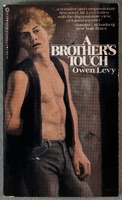 A brother's touch
A brother's touch Angus Rivers, a young Vietnam veteran from upstate New York, ventures to the city to discover the truth about his teenage brother’s death. Earl, a gay sex worker, has been found dead of a heroin overdose on the West Side piers (a notorious cruising ground), his body “stuffed into a rusty oil drum”. This mass-market crime paperback depicts the New York gay scene as a sleazy underworld of addicts, hustlers, self-serving politicians and corrupt priests. But it also introduces gay politics and campaigning, through the activities of the ‘GLP’ or Gay Liberation Party. Positively reviewed in the ‘New York Times’ on publication, Owen Levy’s debut went on to sell very well. His second novel, ‘Goodbye Heiko, Goodbye Berlin’, was published in 2015.
-
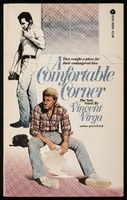 A comfortable corner
A comfortable corner Set in 1980s New York, this second novel by Vincent Virga (1942-) deals with the issue of alcoholism within the gay community and how it affects couple Terence and Christopher. Reviews of the novel acknowledged the importance of the theme, but noted it was presented in a florid style, described by one reviewer as “‘purple’ (lavender?) prose”. The novel is dedicated to the memory of American artist, Jackson Pollock, who suffered from alcoholism. The book was published in a mass market edition by Avon Books, publishers of Virga’s first novel, ‘Gaywyck’, which was also seized during ‘Operation Tiger’.
-
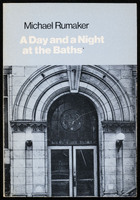 A day and a night at the baths
A day and a night at the baths This book describes Michael Rumaker’s (1932-2019) first visit to the baths at West 28th Street, Manhattan. Although not named, this was the location of the Everard Turkish and Russian baths, which opened in 1888 and became a meeting place for gay men. Tragedy hit the increasingly run-down building in 1977, when nine men died in a fire so devastating it made newspaper headlines. This book is dedicated to all those who were at the Everard Baths during the fire and particularly “to the spirit of the rainbow gay and lesbian phoenix, rising” from the ashes. The publisher is Donald Allen whose Grey Fox imprint published works by several Beat authors, including Allen Ginsberg, whose words of praise for this book are on the back cover. Earlier in his career, Rumaker was aligned with the Beat movement.
-
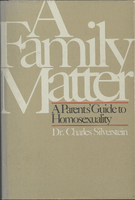 A family matter : a parents' guide to homosexuality
A family matter : a parents' guide to homosexuality Psychologist Charles Silverstein (1935-2023) was a writer and pioneering advocate for LGBTQ+ rights. His presentation to the American Psychiatric Association (APA) contributed to the removal of homosexuality as a mental illness from the APA’s ‘DSM’ (the ‘Diagnostic and Statistical Manual’) in 1974. Three years later, he published his first book, ‘The Joy of Gay Sex’, co-authored with Edmund White – another ‘Operation Tiger’ seized title – and, in the same year, ‘A Family Matter’. While ‘The Joy of Gay Sex’ focused on a community of men who have sex with men, ‘A Family Matter’ is a contribution to the genre of books intended to help parents of lesbian and gay children “come to terms with their own feelings about homosexuality”. In a briefing document about the seized titles, the Defend Gay’s The Word Campaign noted that the book was “Dedicated to his ma and pa!!”
-
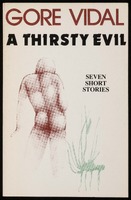 A thirsty evil : seven short stories
A thirsty evil : seven short stories Gore Vidal (1925-2012) was a writer of novels, short stories, plays, essays, and screenplays, on a diverse range of subjects, published across many decades. Some of Vidal’s works centre on gay characters or themes, including some of the tales featured in this collection of seven stories. This edition, which was seized in the raids, was published by Gay Sunshine Press, although it is a reprint of the 1956 first edition published by Zero Press. Additionally, some of the stories had originally been published in magazines. Readers, therefore, had twenty-five years of access to this book’s contents prior to the ‘Operation Tiger’ raids. The front cover shows an illustration by Joe Fuoco.
-
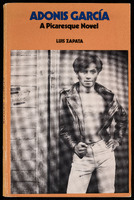 Adonis García : a picaresque novel
Adonis García : a picaresque novel Set in Mexico City’s Roma district, home to students, bohemians, the marginalised and impoverished, this radical experimental novel by Luis Zapata (1951-2020) follows Adonis García as he makes his “shameless and impudent” way through life, as José Joaquin Blanco puts it in the introduction to this edition. Refusing convention in both content and form, Zapata’s eponymous Adonis sets out his sexually adventurous story as if transcribed from a set of tapes, in a freewheeling, verbatim style which makes bold use of white space. The novel was first published in Mexico in 1979 by Editorial Grijalbo as ‘Las Aventuras, Desventuras y Sueños de Adonis García, El Vampiro de la Colonia Roma’. Translator E.A. Lacey (1938-1995) was also a noted gay poet of the post-Stonewall generation.
-
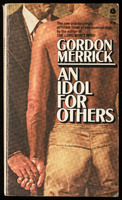 An idol for others
An idol for others Biographer Joseph M. Ortiz claims that Gordon Merrick (1916-1988) “was the most commercially successful writer of gay novels in the twentieth century”. After a moderately successful career as a literary post-war novelist in the 1940s and 1950s, published by important trade presses, it was as the author of paperback gay romance novels, with sex featuring heavily, that Merrick gained success. This novel focusses on theatre producer Walter Makin, an apparently happily married father, who also has gay relationships. The back cover of this paperback outlines the roles played by each of the characters and makes clear that incest is a feature of this novel (Jerry, one of Walter’s lovers, is also his illegitimate son). One reviewer described the novel’s unhappy ending as a return to the 1950s, when gay characters were rarely shown living fulfilled lives.
-
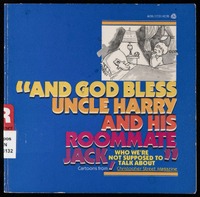 And God bless Uncle Harry and his roommate Jack : who we're not supposed to talk about : cartoons from Christopher Street
And God bless Uncle Harry and his roommate Jack : who we're not supposed to talk about : cartoons from Christopher Street ‘Christopher Street’, named after the New York location of the Stonewall Inn, was a gay magazine which ran for almost twenty years. Founded in 1976 by Charles Ortleb (1950?-) and co-publisher Dorianne Beyer, the magazine published fiction and non-fiction and aimed to be a “cultural forum”. The magazine also prided itself on its satirical cartoons, a selection of which are collected in this book, published by mass market imprint Avon Books. The cartoons were often presented in a sophisticated style similar to the noted ‘New Yorker’ magazine. The titular cartoon, which is featured on the front cover, is by TABBAT, while several cartoons were drawn by the magazine's art director, Rick Fiala, using a range of pseudonyms.
-
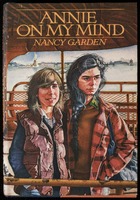 Annie on my mind
Annie on my mind One of the first lesbian young adult novels with an unequivocally happy ending, this is the semi-autobiographical story of Liza and Annie, two teenage girls who fall in love before their relationship is discovered by the school secretary. Nancy Garden (1938-2014), who received an award for lifetime achievement in young adult literature in 2003, met her partner, Sandy, at high school in the 1950s. They remained together until Garden’s death. In 1993, copies of ‘Annie on My Mind’, which had been donated to high schools by an LGBT advocacy organisation, were burned in Kansas City. Following a lawsuit and trial, the book was returned to libraries in 1999. Now considered a classic, it has never been out of print. Garden disliked this cover artwork, preferring the 1992 edition which showed “the two girls really relating to each other equally”.
-
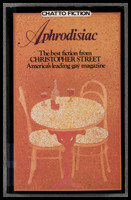 Aphrodisiac : fiction from Christopher Street
Aphrodisiac : fiction from Christopher Street This anthology of “the best fiction from Christopher Street” was praised for its “literary excellence” by ‘Publishers Weekly’. It compiles eighteen short stories published in “America’s leading gay magazine”, from authors including Jane Rule, Edmund White, Tennessee Williams and Kate Millett. The magazine, named after the location of the 1969 Stonewall Uprising, was founded in 1976 and published monthly until the mid-1990s. As well as original fiction, it featured writing on gay politics and culture, interviews and satirical cartoons. A series of essays about the unfolding AIDS crisis in New York by Andrew Holleran – one of the featured authors in this collection – was later published as ‘Ground Zero’.
-
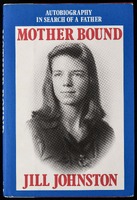 Autobiography in search of a father. Mother bound
Autobiography in search of a father. Mother bound Jill Johnston (1929-2010) was a critic, journalist, feminist and leader of the lesbian-separatist movement in the 1970s. Before publishing perhaps her best-known work, ‘Lesbian Nation - The Feminist Solution’ in 1973, Johnston wrote on dance for the ‘Village Voice’ newspaper, and was the first of its columnists to come out in print. ‘Mother Bound’ details her complicated family relationships and narrates her life up to 1965. Characterised as “readably rambling, pseudo-psychological ponderings” by one somewhat withering reviewer, though notably less experimental in form than her later criticism, ‘Mother Bound’ was followed by a second volume of autobiography, ‘Paper Daughter’, in 1985.
-
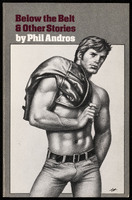 Below the belt : & other stories
Below the belt : & other stories These stories were written by Samuel M. Steward (1909-1993) under the pseudonym Phil Andros. Andros is also the central character – a drifter and hustler, intelligent and well-read, and as handsome as a Greek god – who recounts his sexual exploits in these erotic stories. This book contains an introductory note which flips the interlinked identities of author and subject by suggesting that Andros has lived these experiences, and Steward is an “alter ego” writing them for him. This was the first of seven Andros titles published by Donald Allen of Grey Fox Press, who created the Perineum Press imprint for this purpose. This copy is inscribed by Andros to Gay’s The Word, with hopes that they overcome the “hypocritical, archaic, stupid, and middle-class” Customs officials.
-
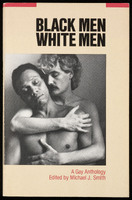 Black men/white men : a gay anthology
Black men/white men : a gay anthology A collection of forty poems, short fiction and non-fiction pieces which explore the intersections of race and sexuality “from the most scholarly to the most explicit”, by authors such as Langston Hughes, Eric Garber and Bruce Nugent. Contributions on sexual stereotyping, discrimination and anti-Black racism within the white gay community are interspersed with several high-quality monochrome photographs and drawings of gay men, both Black and white, pictured separately and in couples. Editor Michael J. Smith founded the advocacy organisation Black and White Men Together in 1980. Chapters sprung up in cities across the United States – there was even, briefly, a Dalston-Hackney branch in London – and the organisation continues today. Smith died of AIDS in 1989 aged 45.
-
 Bodies and souls : a novel
Bodies and souls : a novel Born in El Paso, Texas, to Mexican parents, John Rechy’s (1931-) first novel, ‘City of Night’, was published in 1963 and became a bestseller. Twenty years later, ‘Bodies and Souls’ was published by Carroll & Graf. Written in the style of a classic Hollywood film, the novel is set in Los Angeles and follows a range of characters including porn stars, punks, strippers, television reporters and an evangelist. In addition to his own literary career, Rechy taught creative writing and was also a sex worker. Many of Rechy’s experiences informed his fiction.
-
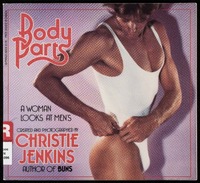 Body parts : a woman looks at men's
Body parts : a woman looks at men's A Defend Gay’s The Word briefing document about the seized titles lists a book called ‘Body Parts’. Its author and publisher are unclear. The book presented here is a candidate for the correct book, but we cannot be sure. Actress and photographer Christie Jenkins, who was initially inspired by the bodies of male ice-skaters (some of whom are spotlighted in the book) presents here a selection of black-and-white photographs of men. The photographic models are named, and feature in sections focussing on specific body parts, including the subtly described ‘Middle Part’. Some images are published with just a question mark, and readers are invited to guess who is featured. The cover model is Leland (Lee) Nicholl, Jenkins’s ideal of “the perfectly built male”.
-
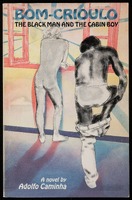 Bom-Crioulo : the Black man and the cabin boy
Bom-Crioulo : the Black man and the cabin boy Brazilian novelist Adolfo Caminha (1867-1897) wrote in the Romantic Naturalist tradition. His work, “polemic, provocative, misunderstood”, according to Raul de Sá Barbosa, who introduces this edition, was largely overlooked in conservative Brazil until it began to be revived in the early 1980s. ‘Bom-Crioulo’, which roughly translates as ‘the Good Black Man’, was first published in Rio de Janeiro in 1895, the same year as Oscar Wilde’s trial and just seven years after the abolition of slavery in Brazil. It depicts, frankly and without moralising, the relationship between a formerly enslaved Black man and a fifteen-year-old white cabin boy. E.A. Lacey, a noted gay poet of the post-Stonewall era, who translated ‘Bom-Crioulo’ from Portuguese, also translated Luis Zapata’s ‘Adonis García’ (another seized book) from Spanish.
-
 Burning : a novel
Burning : a novel Jane Chambers (1937-1983) was an award-winning poet, screenwriter and playwright, who broke new ground by bringing happy, well-adjusted lesbian characters to the stage in plays such as ‘Last Summer at Bluefish Cove’. In ‘Burning’, Cynthia and Angela are on holiday in a New England farmhouse when they are possessed by the spirits of two women persecuted for their love some two hundred years earlier. ‘Burning’, Chambers’s first novel, was originally published by Jove in 1978 before being published by JH Press, one of the Gay Presses of New York. In 1981, Chambers received a Human Fund for Dignity Award with Harvey Fierstein (actor and writer of ‘Torch Song Trilogy’, also seized in ‘Operation Tiger’). In the same year, she was diagnosed with a brain tumour and died two years later. Since 1984, the Jane Chambers Playwriting Award has been offered in her name.
-
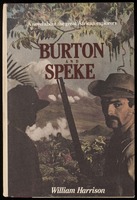 Burton and Speke
Burton and Speke A historical novel of colonial East Africa in the mid-nineteenth century. Explorers Richard Burton and John Hanning Speke drink gin, hunt big game and search for the source of the Nile. Burton is depicted as possibly closeted, Speke as probably gay, but the novel’s racist and imperialist overtones are all too blatant (note the unpleasant reference to “primitive Africa” in the inside book-jacket blurb). There is in addition a deeply misogynistic streak running through the book, including an episode featuring Female Genital Mutilation. The seventh novel from William Harrison (1933-2013), it was received positively by contemporary reviewers, one crediting Harrison with “uncovering a part of lost gay history”. Unusually for the time, ‘Burton and Speke’ was not aimed at a distinctly ‘gay market’. Harrison, who was himself heterosexual, also wrote short stories, nonfiction and screenplays, including for the adaption of this book as ‘Mountains of the Moon’ (1990).
-
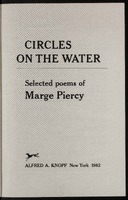 Circles on the water : selected poems of Marge Piercy
Circles on the water : selected poems of Marge Piercy Marge Piercy (1936-) is perhaps best known for her speculative feminist tale ‘Woman on the Edge of Time’ (1976), although she has authored many other novels, short stories and poems. This book collects in one volume 150 of Piercy’s poems from seven titles published between 1963 and 1982. As a result of the twenty-year span, the poems reflect Piercy’s developing ideas and changing themes including her involvement in the USA activist group Students for a Democratic Society (SDS), her enjoyment of growing fruit and vegetables in Cape Cod, her involvement in second-wave feminism and her Tarot poems. The book has been continuously in print ever since its first publication by Alfred A. Knopf.
-
 Coming out
Coming out This novel tells the story of middle-aged divorcee Roger Thornton, and his new life as an out gay man residing in New York, in a relationship with the younger and more extrovert Michael. In addition to this central relationship, the novel features characters from the wider LGBT community including a lesbian couple and Lola, who we would now recognise as a trans woman. The book’s design is reminiscent of a pulp novel, complete with yellow edges. The blurb contains the word “sensitive” which was often used by publishers in the earlier half of the twentieth century to allude to gay men. Wallace Hamilton (1919?-1983) also wrote non-fiction and plays and was a contributor to the ‘New York Native’ paper. Like his character Roger, he was married and came out when he was middle-aged.
-
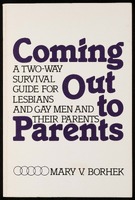 Coming out to parents : a two-way survival guide for lesbians and gay men and their parents
Coming out to parents : a two-way survival guide for lesbians and gay men and their parents In 1975, Mary Borhek (1922-2016) learnt that her son Steve was gay. As a member of the New Testament Church, Borhek initially believed homosexuality was a sin but, over the following years, she not only accepted Steve’s sexuality but became an activist for lesbian and gay rights, particularly within the church community. Borhek turned her experiences into two books aimed at supporting lesbians and gay men and their families – 1979’s ‘My Son Eric’ and, in 1983, the book that was seized during ‘Operation Tiger’, ‘Coming Out to Parents’. Borhek’s introduction to this book expresses sorrow that coming out still necessitates “such elaborate preparation”, and an example ‘Coming-out Letter from Rick to his Family’ is included at the end. The publisher of both books was the Christian Pilgrim Press.
-
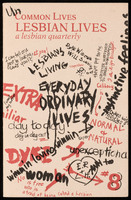 Common lives/lesbian lives : a lesbian feminist quarterly. Number eight, Summer 1983
Common lives/lesbian lives : a lesbian feminist quarterly. Number eight, Summer 1983 Founded in 1981 and edited, typeset, printed and bound by a lesbian collective from Iowa City, ‘Common Lives/Lesbian Lives’ was a quarterly journal committed to “describing the lives of ordinary lesbians” in all their diversity. As the front matter states, this included “lesbians of color, Jewish lesbians, fat lesbians, lesbians over fifty and under twenty years old, physically challenged lesbians, poor and working-class lesbians and lesbians of varying cultural backgrounds”. This issue features poetry, childhood memoir from Joan Nestle and a piece showcasing visual art, with black-and-white reproductions. It is also notable for the essay ‘Love as Addiction – A Story of Battering’ by Kate Hurley, one of the first explorations of intimate partner violence among same-gender couples. ‘Common Lives/Lesbian Lives’ ran for a total of 56 issues, until its primary distributor went bankrupt in 1995.
-
 Counter play
Counter play A high school football novel about friends Brad and Alex, one straight, one gay. Alex’s sexuality is revealed in the first few pages, but remains central to the plot, as Brad is forced to choose between his friend and his wider community. Anne Snyder (1922-2001) wrote seventeen books, mainly young adult ‘problem novels’ which explored issues such as alcoholism, homelessness and anorexia. She collaborated with Louis Pelletier on several titles. Originally marketed as an adult novel, ‘Counter Play’ was republished in 1987 as ‘The Truth about Alex’ and was adapted into a television movie of the same name, broadcast by HBO. Teen heartthrob Scott Baio (Chachi from ‘Happy Days’) played the character of Brad.
-
 Cross sections from a decade of change
Cross sections from a decade of change Elizabeth Janeway (1913-2005) was a novelist, pro-abortion campaigner and prominent second-wave feminist. In this book, which has minimal LGBTQ+ content, Janeway discusses the process of social change regarding women’s personal and public lives and rights in sections entitled ‘History’, ‘Work’, ‘Sexuality’, ‘Literature’ and ‘Dailyness’ (which she describes as “the homely details of ordinary life”). Published in 1983, the book is an unillustrated collection of Janeway’s writings, including essays and reviews, with one piece – a review of Vladimir Nabokov’s novel ‘Lolita’ – dating from 1958. A book named ‘Cross Sections’ was listed, minus author and publisher, in a Defend Gay’s The Word briefing document about the seized titles. It is likely it was this book.
-
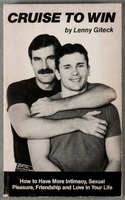 Cruise to win
Cruise to win “This book is about making contact” is the opening declaration of this self-help guide to successful and confident cruising for gay men. Written by Lenny Giteck, assistant editor and columnist at ‘The Advocate’, the book is based on interviews with fifty pseudonymous gay men and seventeen mental health professionals. In chapters on the principles of cruising, ‘dealing with rejection’ (and ‘rejecting others’), ‘sex and intimacy’ and older men and cruising, among others, the book aims to bolster self-worth and reduce anxiety around meeting other men, especially in bars. The inside back cover includes a statement that the book now comes with an ‘AIDS Supplement’. This suggests that this is a later edition of the book – an exact date of publication is not given – as this kind of material would not have been available on first publication in 1982. The supplement is unfortunately not included with this copy.
-
 Cry to heaven
Cry to heaven ‘Cry to Heaven’ is a historical novel set in the world of eighteenth-century Italian opera. It follows castrato singer Guido Maffeo and his star student, the young Venetian nobleman Tonio Treschi, as they navigate same-sex love affairs, incestuous seductions and melodrama both on and off-stage. Anne Rice (1941-2021) was a prolific writer of gothic, erotic, and Christian fiction, perhaps best known for her 1976 debut, ‘Interview with the Vampire’, which was adapted into a feature film in 1994. ‘The Sleeping Beauty Quartet’, written under the pen name A.N. Roquelaure, explored sadomasochism and a range of sexualities and sexual practices. Rice has commented that “From the beginning, [...] gay readers [...] felt that my works involved a sustained gay allegory [...] I didn't set out to do that, but that was what they perceived.”
-
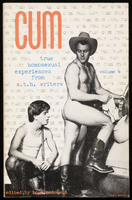 Cum : true homosexual experiences from S.T.H. Volume 4
Cum : true homosexual experiences from S.T.H. Volume 4 This volume of “more than 100 sexually explicit stories” is one of a few anthologies culled from ‘Straight to Hell’, the magazine self-published by Boyd McDonald (1925-1993), that were seized during the raids. The collection gathers ‘true’ stories of sexual experiences, sent to the magazine by its readers, interspersed with black-and-white photographs. The book notes that the pictures are posed by professional models, and their inclusion “does not imply that they are necessarily homosexual”. The humour of these publications is reflected in the title of the cover photograph, taken by Mike Arlen – ‘A typical laundry scene in present-day London’.
-
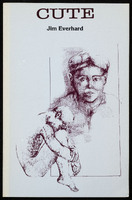 Cute : and other poems
Cute : and other poems A collection of around thirty poems, many of which had previously appeared in gay publications such as ‘Fag Rag’ and ‘Gay Sunshine Journal’ as well as the avant-garde literary review ‘New – American and Canadian Poetry’. Everhard’s writing is moving, personal and direct. ‘For Marcie’ details the complicated feelings of the speaker on sleeping with a woman to whom he is unable to come out. ‘Reasons Why I Love You’ and ‘Enemy’ explore a love affair with a man named Richard – and its aftermath. The book’s cover features a drawing of a boy, face-on and in the foetal position, and on the inside flyleaf there is a sketch of a nude young man, all by Joe Fuoco. Born in 1946, Everhard died of AIDS in 1986.
-
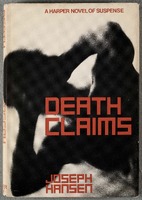 Death claims
Death claims Following ‘Fadeout’ (1970), this is the second book in Joseph Hansen’s Brandstetter series, featuring gay private investigator David ‘Dave’ Brandstetter. Set in Los Angeles, it moves through the worlds of rare books, community theatre and television. Hansen eventually published twelve books in the series and can be credited with inventing the ‘gay detective’ genre. Gay themes are woven throughout – in book nine, Brandstetter must track down a serial killer who is targeting gay men with AIDS. Hansen, born in 1923, was also a poet and journalist. Under the pen name James Colton, he published several gay novels in the pre-Stonewall era, including ‘Strange Marriage’ (1965) and ‘Known Homosexual’ (1968). He received a Private Eye Writers of America Lifetime Achievement Award in 1992, writing several more books before his death in 2004.
-
 Death trick
Death trick Written by journalist and author Richard Lipez (1938-2022), using the name Stevenson, this is the first novel in a series of sixteen to feature the private investigator, Donald Strachey. The story follows Strachey as he investigates a murder in Albany, New York, where the victim and prime suspect are both gay men. Strachey is also gay so can explore the otherwise closed ranks of the gay community. The back cover blurb includes a quote from author Armistead Maupin which makes the perhaps unavoidable comment, “At last a private dick who really earns the title”. Some other books in the Donald Strachey series were filmed for television. Stevenson’s series is often considered alongside books by Joseph Hansen featuring gay detective Dave Brandstetter, who first appeared in print in 1970. One of these books, ‘Death Claims’, was also seized during ‘Operation Tiger’.
-
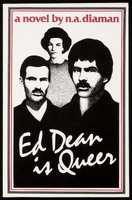 Ed Dean is queer : a novel
Ed Dean is queer : a novel Praised on publication for its “grabbing and lucid style”, ‘Ed Dean is Queer’ was the first novel by N.A. Diaman (1936-2020). Set in 1983, this tale of political intrigue grapples with pro- and anti-gay politics to provide a vision of a “meaningful future” for queer people, according to one reviewer. The book’s layout and typesetting are noticeably DIY in style, and Diaman set up Persona Press in order to self-publish, driven by the conviction that “straight people are not going to tell our stories.” He would go on to write another nine books. Timothy Thompson’s cover design features a striking monochrome graphic of two moustachioed men and a woman looking suspiciously on behind them. The copy on display here is dated “4 December 1984” and is inscribed “Best wishes to Gay’s The Word and its fight against censorship.”
-
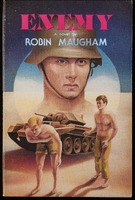 Enemy : a novel
Enemy : a novel First published in the UK in 1981 as ‘The Deserters’, ‘Enemy’ was based initially on Robin Maugham’s play of the same name, which premiered in Guildford in 1969 before transferring to London. Maugham (1916-1981), the nephew of the novelist W. Somerset Maugham, drew on his experience in the Sahara during the Second World War for this tale of two soldiers, one British and one German, who stumble across each other in the desert. Maugham depicts a friendship that crosses boundaries of class, sexuality and nationality. Supported by Peter Burton, who edited Maugham’s short-story collection ‘The Boy from Beirut’, another of the books seized in ‘Operation Tiger’, ‘Enemy’ was the last book Maugham published before he died.
-
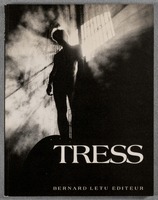 Facing up
Facing up Featuring on the front cover a shadowy photograph of a man in silhouette and only four words, it is not until opening the book that the title and full author name are apparent, and it becomes clear that this is a photography book. The photographer, Arthur Tress (1940-), is described by Yves Navarre in the book’s introduction as a “prowler, voyeur, trickster, devourer, lover of his city and its life”. The backdrop to the sixty-five black-and-white photographs is New York, depicted predominantly as a place of urban decay. Juxtaposed with the cityscapes are (mainly) naked men posed in positions and with objects that explore ideas of male sexuality and power, dreams and the subconscious. Still producing work, Tress was recently described as “one of the most innovative American photographers of the postwar era”.
-
 Feminism in the 80's : facing down the right
Feminism in the 80's : facing down the right A Defend Gay’s The Word briefing document about the seized titles lists a book called ‘Feminism in the 80s’ but with no other identifying features. It is possible, but not certain, that the title is that of a series including two works authored by Charlotte Bunch (1944-) and published in the years preceding the ‘Operation Tiger’ raids – ‘Facing Down the Right’ (1981), shown here, and ‘Going Public With our Vision’ (1983). These pamphlet publications are based on speeches given by Bunch who was a member of the Washington-based lesbian feminist group The Furies. Bunch was also a writer, journal editor, and active in education, and is now a professor at Rutgers University, focussing on feminism, women’s rights and violence against women.
-
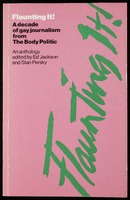 Flaunting it! : a decade of gay journalism from The Body Politic : an anthology
Flaunting it! : a decade of gay journalism from The Body Politic : an anthology ‘The Body Politic’ (TBP) was a collectively run gay liberation journal founded in Toronto in 1971. Initially sold locally, it developed national distribution, and this anthology collects writing and illustrations from thirty-six contributors covering the publication’s first decade. Even at the time of publication, the anthology was considered a historical record of a key decade in gay liberation, which is expressed across sections including those entitled ‘Risks’, ‘Living Our Lives’, ‘Cruising and Censorship’, and ‘Into the Eighties’. The book is published by Pink Triangle Press (which still exists), the publishing organisation behind ‘TBP’, with financial support from New Star Books. This copy is inscribed to Gay’s The Word from six members of the collective, who note that “the seizure of your stock is a tribute to your success”.
-
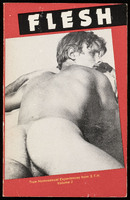 Flesh : true homosexual experiences from S.T.H. Volume 2
Flesh : true homosexual experiences from S.T.H. Volume 2 The second anthology of readers’ real-life sexual experiences from Boyd McDonald (1925-1993), compiled from his self-published magazine, ‘S.T.H. (Straight to Hell)’ and illustrated with explicit black-and-white nude photographs posed by models. McDonald used newspaper headlines to frame stories, interspersed with "demented interviews with diverse groups of homosexual men”, according to one reviewer, featuring quick-fire questions about sexual likes, dislikes and exploits. Other ‘S.T.H.’ anthologies seized in the ‘Operation Tiger’ raids included ‘Meat’, ‘Cum’ and ‘Sex’. ‘Juice’, the fifth volume in the series, continued to cause problems with the establishment. A review in ‘OUT! New Zealand’s Alternative Lifestyle Magazine’ from December 1991 includes the info “Just released by customs”.
-
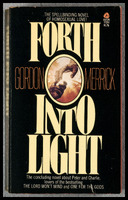 Forth into light
Forth into light Impossibly handsome lovers Peter Martin and Charlie Mills continue to work out their complicated romance. Peter, Charlie and sometime heterosexual love interest Martha – the Mills-Martins – are long-established in comfortable family life, complete with children (named Charlotte and Peter after their respective fathers), but newcomer Jeff still creates tension. This is the concluding part of the bestselling erotic trilogy by Gordon Merrick (1916-1988), following ‘The Lord Won’t Mind’ (1970) and ‘One for the Gods’ (1971), which were also seized in the ‘Operation Tiger’ raids. It is set on an island in the Aegean in the 1950s. Merrick himself had moved to the island of Hydra in 1960.
-
 Forty-deuce : a play
Forty-deuce : a play This dark play was first performed Off Off-Broadway in 1981 and gave Kevin Bacon (seen here on the cover) an early, award-winning role. The play’s title is a riff on both the tennis score and a junction at New York's 42nd Street known as ‘the Deuce’, where sex shops, porn cinemas and peep shows were clustered. The play, by Alan Bowne (1945-1989), depicts the death and exploitation of a young boy alongside a critique of commodity culture and was published by Felice Picano’s Sea Horse Press. Sea Horse Press was one of the Gay Presses of New York collective, which worked to increase the visibility of gay books.
-
 Fox Running : a novel
Fox Running : a novel The fourth novel for teenagers by R.R. Knudson (1932-2008), again with a sporting theme (‘You Are the Rain’, about a doomed canoe trip, was another of the books seized in ‘Operation Tiger’). Fox Running is a Mescalero Apache girl in her late teens, coached by young former Olympian Kathy ‘Sudden’ Hart. To research the novel, Knudson spent time at the Mescalero Apache Reservation in New Mexico and with an athletics track team at the University of Arizona. ‘Fox Running’ was first published by Harper & Row in 1975 before being reprinted by Avon in 1977 and as an Avon Flare paperback in 1981. The inside illustrations are by Ilse Koehn and are reproduced from the Harper & Row edition.
-
 From violent men : a novel
From violent men : a novel In 1978, gay politician Harvey Milk and Mayor George Moscone were assassinated in San Francisco by former city Supervisor Dan White. Daniel Curzon (1938-) self-published this loosely fictionalised version of the aftermath of these deaths through IGNA (or International Gay News Agency). He had experienced “a decade of frustration with publishing houses” over this and other works, according to a 1983 article in ‘Out’ magazine. This copy is inscribed by the author, “Give ‘em hell at Customs! Long live Oscar Wilde, D.H. Lawrence and gay rights!”, and dated 27 February 1985. “D.H. Lawrence” is a reference to the ‘Lady Chatterley’s Lover’ trial in 1960, when the amended Obscene Publications Act 1959 allowed for a work to be defended on the grounds of literary merit for the first time. Curzon’s short story collection ‘Human Warmth and Other Stories’ was also seized in ‘Operation Tiger’.
-
 Game-texts : a Guatemalan journal
Game-texts : a Guatemalan journal This meditative travelogue is written in a fragmentary style, combining quasi-spiritual musings on the natural world (“See that a stone is a stoning in the same sense that a flower is a flowering”) with casual accounts of sexual encounters with various Guatemalan teenagers. The 1982 mail-order catalogue of Los Angeles bookstore A Different Light puts it bluntly – “Personal reflections & sex with Latin American boys.” Although Erskine Lane (1940-) was awarded a 1976 Fels award for the best non-fiction published by a small-press magazine (‘Gay Sunshine Journal’ no. 26/27, in which it first appeared), the lack of reflection on race, class, colonialism and the power dynamics at play make this an uncomfortable read. Lane also worked for Gay Sunshine Press as a translator from Portuguese and Spanish into English.
-
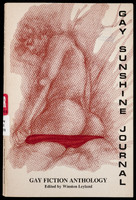 Gay fiction journal. No. 47 : anthology of fiction/poetry/prose
Gay fiction journal. No. 47 : anthology of fiction/poetry/prose ‘Gay Sunshine’ was published, in tabloid newspaper format, between 1970 and 1982. The first issues focussed on radical gay politics and liberation, but when Winston Leyland (1940-) became editor in 1971, he included an emphasis on literature. Leyland made the decision to publish this issue, which became the final one, in book format, as it was less ephemeral and easier to preserve than a newspaper. The issue contains poetry, fiction and prose, most of it previously unpublished, including the first English translation of Paul Verlaine’s story ‘A Draw’. The book also features illustrations, and the cover is by Joe Fuoco, who also illustrated other seized books, Gore Vidal’s ‘A Thirsty Evil’ and Jim Everhard’s ‘Cute’.
-
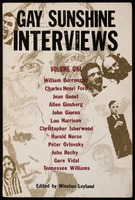 Gay sunshine interviews. Volume 1
Gay sunshine interviews. Volume 1 In 1975, the editor of the ‘Gay Sunshine Journal’, Winston Leyland (1940-), founded the related book imprint Gay Sunshine Press, which published volumes of interviews. Most of the interviews had originally been published in the journal, which began its interview series with gay writers, artists and performers in 1973. This first volume includes interviews with William Burroughs, Jean Genet and Christopher Isherwood. Leyland conducted several of the interviews and noted that they all highlight “a definite gay sensibility in the arts”.
-
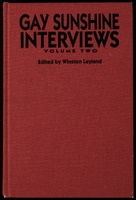 Gay sunshine interviews. Volume 2
Gay sunshine interviews. Volume 2 This volume contains interviews with gay artists and cultural figures, including Ned Rorem, John Wieners and Samuel M. Steward. It also features Harry Britt, who was a gay member of the legislative San Francisco Board of Supervisors, and succeeded Harvey Milk, who had been the first openly gay man in such a role. Winston Leyland (1940-), the publisher of this book, had been ordained as a priest, a role he abandoned as he became more involved in radical and gay politics. This is most clearly seen in his work as a publisher, which he described as follows – “I see Gay Sunshine Press as a catalyst in the evolving Gay Cultural Renaissance and myself as deeply involved in that process”.
-
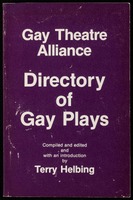 Gay Theatre Alliance directory of gay plays
Gay Theatre Alliance directory of gay plays This book was the first to list plays where gay men and lesbians are the “main, primary, or at least, very important focus”. As part of the criteria for including a play, the key emphasis was on the sexuality of the characters not the playwright, so works authored by straight writers are listed. The four hundred plays are organised alphabetically by title, alongside information such as number of male and female characters and date of first performance. The appendixes list '“Lost” Plays’ and names of gay theatre companies. Terry Helbing (1951-1994) was co-founder of the Gay Theatre Alliance, which supported and promoted gay theatre, and the book is published by his JH Press, which was one third of the Gay Presses of New York. He died from AIDS in 1994.
-
 Gaywyck
Gaywyck ‘Gaywyck’ was the first novel by New York writer and photo editor Vincent Virga (1942-). The first edition of the book, the one seized during ‘Operation Tiger’, was published in 1980 by Avon and advertised with a quote from ‘New York Magazine’ stating it was the “first gay gothic” novel. As a fan of gothic romance – the title is a play on Anya Seton’s 1944 gothic novel, ‘Dragonwyck’ – Virga wrote the novel with gay characters “to show that genres know no gender”. Set in the nineteenth century at Gaywyck, a Long Island estate owned by the Gaylord family, the story follows Robert Whyte, who is employed to catalogue the library, and his relationship with Donaugh Gaylord. Dark family secrets are revealed, but the story ends happily for the couple. Virga’s second book, ‘A Comfortable Corner’, was also seized during ‘Operation Tiger’.
-
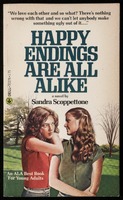 Happy endings are all alike
Happy endings are all alike Uncompromisingly frank from its opening line, Sandra Scoppettone’s (1936-) depiction of the love affair between teenage girls Jaret and Peggy was a much-needed riposte to 1950s lesbian pulp, such as the novels of Ann Bannon and Vin Packer. As one reviewer put it, “The story 1) is not preachy, 2) does not kill off either girl in the end, 3) is not syrupy”. The ground-breaking ‘Happy Endings Are All Alike’, chosen as an American Library Association Best Book for Young Adults, was first published by Harper & Row in 1978, preceding Nancy Garden’s ‘Annie on My Mind’ by four years. Scoppettone is known also for her crime-writing, as a playwright and for her collaboration with Louise Fitzhugh (author of ‘Harriet the Spy’) on the 1961 picture book ‘Suzuki Beane’, a counterculture parody of the ‘Eloise’ books set in Greenwich Village.
-
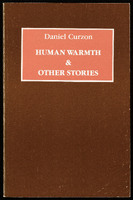 Human warmth : & other stories
Human warmth : & other stories Twelve short stories featuring gay and lesbian characters, which strive for “some kind of universality, even when dealing with very specific homosexual content”, according to the author’s preface. Daniel Curzon (1938-) is a former journalist for publications such as ‘Gay News’, and a now-retired professor of English. In the mid-1970s, Curzon edited and published ‘Gay Literature – A New Journal’, a literary quarterly which folded after eighteen months. Following ‘Something You Do in the Dark’ (Putnam’s,1971), dubbed the “first gay protest novel”, Curzon wrote (and sometimes self-published) several other short story collections, novels, plays, poems and humorous titles, including ‘The Joyful Blue Book of Gracious Gay Etiquette’. His novel ‘From Violent Men’ was also seized in ‘Operation Tiger’.
-
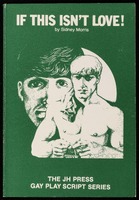 If this isn't love! : (two men--twenty years--in three acts)
If this isn't love! : (two men--twenty years--in three acts) Part of the ‘JH Press Gay Play Script’ series, this was one of the most successful plays performed at The Glines, a not-for-profit gay theatre company in New York. Written by Sidney Morris (Fineberg) (1929-2002), the play follows couple Eric and Adam across three acts representing three decades of gay life and experience, entitled ‘The Fearful Fifties’, ‘The Seeking Sixties’, and ‘The Succulent Seventies’. As the men age, they respond to increasing societal liberation and changes in their own relationship. Morris, whose own youth was in the 1950s, wanted to ensure that the gay community did “not forget our dark and absurd past”. Morris wrote a number of other plays with gay male themes. Terry Helbing from JH Press, the play’s publisher, was also the general manager of the play’s first run. Morris died from AIDS in 2002.
-
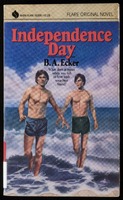 Independence day
Independence day “What does it mean when you fall in love with your best friend?”, asks the cover of this coming-of-age story, which depicts identically clad high-school students Mike and Todd. Mike decides to tell Todd how he feels about him on 4 July – Independence Day in the US – and although Todd does not feel the same, this proto-Young Adult novel models understanding and acceptance. By its close, Mike has “dated several guys” in college and is taking a course “to become a counselor to gay kids”. B.A. Ecker includes a reference to another of the books erroneously seized in ‘Operation Tiger’, Patricia Nell Warren’s ‘The Front Runner’ (1974), which Mike “really found some comfort reading”. ‘Independence Day’ appears to be Ecker’s only published work.
-
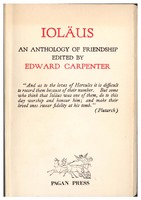 Ioläus : an anthology of friendship
Ioläus : an anthology of friendship First published in 1902, this book contains selections from multiple texts, including poetry and essays, which present romantic friendships between men. The collection is edited by Edward Carpenter (1844-1929), a writer and socialist who campaigned for sexual freedom and homosexual equality. This collection covers three centuries, beginning with examples of male love from pagan and early worlds, and features the words of some English canonical writers, including William Shakespeare. This is a reprint of a 1917 Mitchell Kennerley edition and was the first book published by John Lauritsen’s Pagan Press which aimed to introduce a new audience to classical, “pro-male” texts.
-
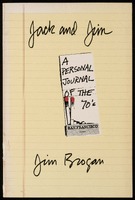 Jack and Jim : a personal journal of the 70's
Jack and Jim : a personal journal of the 70's In January 1970, Jim Brogan (1941-), a young college professor at San Francisco State University (SFSU), is about to be fired for participating in strike action. He is considering going back into therapy and thinks 1970 might be the year he finds love. By December, he has a permanent post. In August 1972, he meets the handsome Jack, and they begin seeing each other. These diaries, revised for publication by an extensive ensemble of Brogan’s friends, cover the decade up to 1981. They are a remarkable chronicle of long-term love and an ongoing search for personal, sexual and spiritual fulfilment. Brogan taught SFSU’s first lesbian and gay studies course and, with husband Jack Post, established three scholarships for the study and teaching of literature and sexuality.
-
 Kevin
Kevin Wallace Hamilton came out in his fifties, moved to Greenwich Village and began writing popular books and plays about the queer community. ‘Kevin’, about a relationship between a teenage runaway and a professional man in his mid-thirties, draws in part on Hamilton’s own experiences. Hamilton died after a fall at his home in 1983, aged 64. Various obituaries note his involvement in the international paedophilia advocacy organisation NAMBLA (North American Man/Boy Love Association). Criticised by one contemporary reviewer for its sentimentality and lack of realism, readers of ‘Kevin’ today may have more serious concerns about the abusive power dynamics at play. Hamilton’s novel ‘Coming Out’ (1977) was also seized in ‘Operation Tiger’.
-
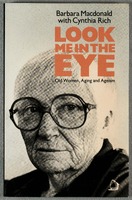 Look me in the eye : old women, aging, and ageism
Look me in the eye : old women, aging, and ageism This book focusses on women and ageing via several essays previously published in journals such as ‘Broomstick’ and ‘Sinister Wisdom’. Barbara Macdonald (1913-2000) and Cynthia Rich (1933-), the sister of poet Adrienne Rich, who were a couple and active in the women’s rights movement, write from different stages in the ageing process. Macdonald uses her introduction to reflect on the repressive environment she encountered growing up, which forced lesbians to become “other”, an otherness she now equates with being an older woman. The copy displayed here is the 1985 reprint edition. The first edition, and likely the one seized during the raids, was published by Spinsters Ink, a feminist press founded in 1979 in New York by Judith McDaniel and Maureen Brady.
-
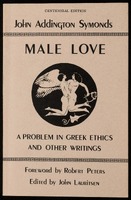 Male love : a problem in Greek ethics and other writings
Male love : a problem in Greek ethics and other writings Poet and literary critic John Addington Symonds (1840-1893) had several same-sex relationships both before and after his marriage in 1864 to Janet Catherine North, with whom he had four daughters. ‘A Problem in Greek Ethics’, an extensive study of sexuality in Ancient Greece, including the culturally sanctioned practice of pederasty (sex between men and adolescent boys), was written in 1873 and published privately a decade later in an edition of ten. In 1897, it was expanded as an appendix to sexologist Havelock Ellis’s ‘Sexual Inversion’ (though immediately suppressed) and was subsequently reprinted over the course of the twentieth century, often using fictitious imprints to avoid prosecution. The Pagan Press edition of 1983, edited by John Lauritsen, marked the centenary of the work’s first publication and was named one of the ten best gay books of the year by ‘The Advocate’ newspaper.
-
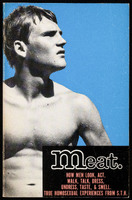 Meat : how men look, act, walk, talk, dress, undress, taste & smell
Meat : how men look, act, walk, talk, dress, undress, taste & smell Described in the introduction by ‘Fag Rag’ co-founder and Walt Whitman scholar Charles Shively as “an unprecedented piece of literature”, ‘Meat’ is an anthology of writing from the first forty-seven issues of ‘Straight to Hell (S.T.H.)’, a self-published magazine sometimes known by other titles including ‘The Manhattan Review of Unnatural Acts’. Created by Boyd McDonald (1925-1993), the publication predominantly contains explicit true stories of gay men’s sexual experiences which have been submitted by readers. These are accompanied by photos of muscular men, not unlike those published in physique magazines, often posed by models from agencies such as the Athletic Model Guild. This collection is published by Gay Sunshine Press, and the back cover includes quotes from readers including Gore Vidal, William Burroughs and Allen Ginsberg.
-
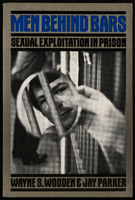 Men behind bars : sexual exploitation in prison
Men behind bars : sexual exploitation in prison This is an in-depth study of exploitative and consensual sex between men in prison, drawing on qualitative interviews with men in a medium-security correctional facility in California. It covers themes such as the prison setting, prison policy and staff attitudes towards homosexuality. Wayne Wooden, a sociologist, was based for several years at Cal Poly Pomona. He has also worked on aging and was an active member of the National Association of Lesbian and Gay Gerontology. First published by New York’s Plenum Press in 1982, ‘Men Behind Bars’ was then published by Da Capo in 1983 – this is the paperback edition of the following year.
-
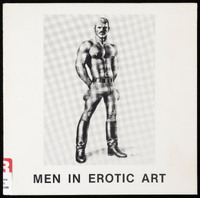 Men in erotic art
Men in erotic art This is a catalogue of artists represented by the Rob Gallery, based in Amsterdam and later also in New York, which exhibited male erotic art. Rob started as a leather worker catering for men, and the themes of leather and S&M continued in the art represented by the gallery. The catalogue is an introduction to this work and the artists, including Tom of Finland (Touko Laaksonen), Nigel Kent (aka James D.), Olaf and Orsen. The catalogue also introduces the Art Matchboxes series, limited edition matchboxes containing erotic prints by a single artist.
-
 Men loving men : a gay sex guide and consciousness book
Men loving men : a gay sex guide and consciousness book Disappointed by the heterosexism of ‘The Joy of Sex’ (1972), Mitch Walker (1951-) produced this practical sex guide for men “who want to love other men” and “be themselves”, in the same year as Charles Silverstein and Edmund White published ‘The Joy of Gay Sex’. Walker also emphasises queer kinship, distinguishing a more emotionally and socially encompassing “gayness” from a medico-scientific “homosexuality”. Explanations of sexual acts such as masturbation and fellatio are interspersed with quotations and images on love and sex between men from other times and cultures. The book is illustrated with expressive line drawings by Bill Warwick and black-and-white photography by David Greene. Copies of ‘Men Loving Men’ sent to ‘Gay News’ in the late 1970s were destroyed by Customs. It also met with Customs’ disapproval in Canada and New Zealand, where it was banned as indecent in 1983.
-
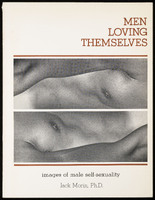 Men loving themselves : images of male self-sexuality
Men loving themselves : images of male self-sexuality The publisher of this book, Down There Press, was founded by sex therapist and feminist Joani Blank (1937-2016), to publish works advocating for sex positivity. She also edited this book which explores male masturbation, primarily through black-and-white images of men depicted in the act. Jack Morin (1946-2013) photographed twelve straight and gay men in settings of their choosing, alongside statements outlining how masturbation relates to their sexuality. The book ends with a section entitled ‘The Psychology of Male Self-Sexuality' which provides a conceptual framework for the images. It includes a list of recommended readings, and an advert for a poster of the book’s cover, available to purchase. Other books exploring gay men’s sexuality, ‘The Joy of Gay Sex’ and ‘Men Loving Men’, were also seized during ‘Operation Tiger’.
-
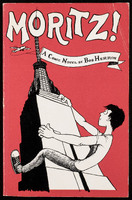 Moritz! : a comic novel
Moritz! : a comic novel A review of this novel described it as “a trashy book” but one that was nonetheless enjoyable thanks to its absurdist and silly humour. This satirical novel follows Jellico Moritz, a “well-endowed” young man, who travels from rural America to a new life and sexual awakening in New York City. The final chapter, entitled ‘Moritz Goes to a Garden Party’, was first published in ‘A True Likeness’ which was edited by Felice Picano. The book was published by Larry Mitchell’s Calamus Books which was one third of the Gay Presses of New York collective.
-
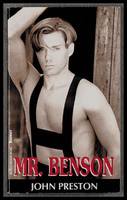 Mr. Benson
Mr. Benson First published in 1983 by San Francisco-based publishers Alternate, John Preston’s classic S/M novel details a young man’s slave/master relationship with the sadistic and dominant Mr Benson. Preston (1945-1994) was involved in the civil rights and anti-war movements of the 1960s, as well as in gay activism. By 1975, he was editor of national gay newspaper, ‘The Advocate’. In the 1980s, he combined his writing of erotica and pornography with more mainstream anthologies about gay life. In 1995, he posthumously received a Lambda Literary Award and was a finalist for the American Library Association’s Stonewall Book Award for 'Sister and Brother’, a nonfiction anthology co-edited with Joan Nestle. In 1994, the year of his death from complications from AIDS, he received the Steve Maidhof Award from the National Leather Association International, who inaugurated a short story prize in his name in 2007.
-
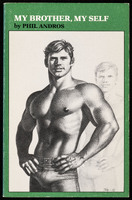 My brother, my self
My brother, my self This is the second of three Phil Andros (pseudonym of Samuel M. Steward, 1909-1993) titles seized during the raids. As with the other Andros titles published by Perineum Press, the cover is a specially commissioned Tom of Finland (Touko Laaksonen) illustration of the Phil Andros character (Steward was very pleased with these drawings). This novel was first published in 1970 by pulp publisher Gay Parisian Press under the title ‘My Brother, the Hustler’, so the title was altered to avoid legal issues. Featuring more sexual exploits of the character Phil Andros, the “brother” of the title is his doppelgänger, Denny. The two men can psychically communicate and are often confused for one another.
-
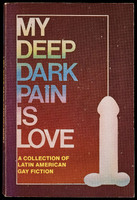 My deep dark pain is love : a collection of Latin American gay fiction
My deep dark pain is love : a collection of Latin American gay fiction This anthology, edited by Winston Leyland (1940-), presents a selection of short stories, novellas and excerpts from longer works from a wide range of male Argentinian, Mexican, Cuban, Chilean and Brazilian authors. It is illustrated with graphic line-drawings by Argentian artist Jorge Gumier Maier and is a follow up to Gay Sunshine Press’s ‘Now the Volcano’ (1979) which focused on Mexico, Brazil and Colombia. Like the first anthology, Brazilian literature predominates in this collection. It is a collaboration between Leyland, who travelled extensively in Latin America, and frequent Gay Sunshine translator, E. A. Lacey (1938-1995). The two anthologies form part of a small body of books from Gay Sunshine Press with a Latin American focus, including Luis Zapata’s ‘Adonis García’ and Adolfo Caminha’s ‘Bom-Crioulo’, both of which were also seized in the ‘Operation Tiger’ raids.
-
 My first satyrnalia
My first satyrnalia One of two Michael Rumaker (1932-2019) books seized, this novel follows a narrator through a night in New York, on the streets, in the bookshops and in “make-out booths”. The narrator’s ultimate destination is an apartment where a Fairy (Faerie) Circle is gathering for the Saturnalia of the book’s title, an “orgiastic celebration” of the Winter Solstice. The Fairy Circle refers to a meeting of the Radical Faeries, a countercultural movement founded in 1979. The novel is scattered with references to non-fictional locations, books and music, including the Oscar Wilde Memorial Bookshop on Christopher Street, Donna Summer and Arthur Evans’s book ‘Witchcraft and the Gay Counterculture’ (also seized in ‘Operation Tiger’). The novel, therefore, provides a sense of gay culture in Greenwich Village as it was forty years ago.
-
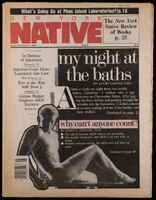 New York native. Issue 82, January 30-February 12, 1984
New York native. Issue 82, January 30-February 12, 1984 Published biweekly between 1980 and 1997, this is a relatively early edition of ‘New York Native’. Much of the paper’s reporting at this time concentrated on the growing AIDS crisis, and this issue is no exception, with headline statistics and an editorial concerned with a potential link between the human immunodeficiency virus (HIV) and the African Swine Fever virus. While a paper supporting this theory appeared two years later in medical journal ‘The Lancet’, it was later discredited. Also featured are music, theatre, film, gallery and restaurant reviews, guides to New York and San Francisco, a letters page, classified ads and personal ads.
-
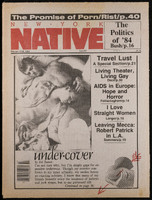 New York native. Issue 83, February 13-26, 1984
New York native. Issue 83, February 13-26, 1984 The ‘New York Native’ newspaper was published by Charles Ortleb (1950?-) between 1980 and 1997. This issue contains articles, reviews, personal listings, adverts, a fashion spread and a winter travel supplement. Most notable is the range of reports on AIDS, which begin with an editorial critiquing the racism and homophobia in press reports of the crisis. Other articles in this issue focus on the first European conference on AIDS and lists of numbers of cases reported in New York. The paper first reported on AIDS in 1981, after the ‘New York Times’ broke the story on 3 July that year. ‘New York Native’ had been pioneering in its coverage, although it later fell out of favour and was boycotted by some activists when it began to promote conspiracy theories regarding the cause of AIDS.
-
 Notes from a marriage : love poems
Notes from a marriage : love poems Since the mid-1970s, the creative output of Gavin Geoffrey Dillard (1954-) has encompassed many forms including poetry, songwriting and acting in pornographic films. This poetry collection, Dillard’s third, explores the emotional and sexual relationship between two young men, with some undertones of violence. It was published in New York by Felice Picano’s Sea Horse Press. In 1988, Australian gay rights activist Dennis Altman described Dillard as “the laureate of the sensual”, while Dillard’s poetry forms the basis of Clint Borzoni’s 2014 opera ‘When Adonis Calls’. Today, Dillard self-publishes books under his Gavin Dillard Poetry Library & Archive imprint and recently produced a new text and photographic edition of ‘Notes from a Marriage’.
-
 Now let's talk about music
Now let's talk about music Riding high on his wildly popular Peter and Charlie trilogy (also seized by Customs), Gordon Merrick (1916-1988) continued to publish paperback romances with Avon into the 1980s. ‘Now Let’s Talk About Music’ gave Merrick’s fans more of what they wanted – exotic locations (Thailand, a yacht off the coast of Sri Lanka), rich, beautiful gay men, steamy sex scenes and page-turning drama. “Another winner from the gay Harold Robbins” proclaimed a reviewer for ‘Gay News’ in December 1982. As with several other Merrick titles published by Avon, the cover art is by Victor Gadino, a noted illustrator of romance and erotica.
-
 Now the volcano : an anthology of Latin American gay literature
Now the volcano : an anthology of Latin American gay literature Edited by Winston Leyland (1940-) and published by his Gay Sunshine Press imprint, this book is an anthology of short stories, poems, novel excerpts and a memoir, interspersed with illustrations. The collection presents a snapshot of gay male writing from Latin America, with an emphasis on Brazilian literature, which Leyland notes is the richest, including ‘Bom-Crioulo’ which was first published in 1895 (and which was also seized during ‘Operation Tiger’ as a separate title). The book’s title refers to Malcolm Lowry’s Mexican-set novel ‘Under the Volcano’. Translator Erskine Lane’s own novel, ‘Game-Texts – a Guatemalan Journal’, was also published by Gay Sunshine Press and seized during the raids.
-
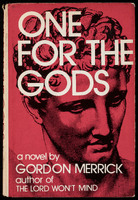 One for the gods : a novel
One for the gods : a novel The second book in the Peter and Charlie trilogy by Gordon Merrick (1916-1988) and the couple, now a decade into their relationship, move from the South of France to Greece. The copy on display is the original Bernard Geis Associates edition from 1971. The cover design, by Roy E. LaGrone, is of a sculpted Greek head rendered in black ink against a red background, overlaid with large, sans-serif white lettering. It lends the book a serious air – this could be a historical novel or a textbook – at odds both with its content and with the smouldering pulp covers of later Merrick editions, as published by Avon Books. Bernard Geis was also responsible for Jacqueline Susann’s ‘The Valley of the Dolls’ in 1966, one of the bestselling novels in publishing history.
-
 P.S. your cat is dead
P.S. your cat is dead A darkly comic exploration of the burgeoning relationship between down-on-his-luck actor Jimmy Zoole and a gay cat burglar he finds looting his apartment. This is the third novel from author and playwright James Kirkwood (1924-1989). According to biographer Sean Egan, Kirkwood was inspired by a series of burglaries at his home on West 58th Street, New York. In their 1979-80 catalogue, Philadelphia bookstore Giovanni’s Room described ‘P.S. Your Cat is Dead’ as “our all-time bestselling gay men’s novel”. Kirkwood adapted it into a play in 1975 and in 2002, it was adapted again into a feature film, directed by Steve Guttenberg, which was rather less well-received. Kirkwood’s ‘There Must Be a Pony!’ was also seized in ‘Operation Tiger’.
-
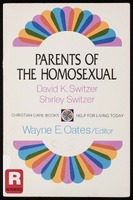 Parents of the homosexual
Parents of the homosexual This book was published as part of the ‘Christian Care Books’ series, a set of practical guides which dealt with contemporary social experiences from a Christian pastoral care perspective. The series was edited by Warren E. Oates, a pastor and psychotherapist. This volume is aimed at Christian parents of gay or lesbian children, particularly those who are struggling with their children’s sexuality. Authored by Shirley Switzer, a mental health psychologist, and pastor David Switzer (1925-2015), this book draws on real conversations with the intention of lovingly reconciling families. The book also includes a chapter which critically engages with the Bible and challenges its use as an excuse for homophobia.
-
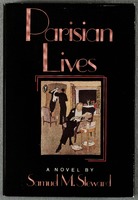 Parisian lives : a novel
Parisian lives : a novel Samuel M. Steward (1909-1993) was, amongst other things, an academic, a novelist, a pornographer and a tattoo artist. During the 1930s, he befriended writer Gertrude Stein and her partner Alice B. Toklas. Both feature in this novel, which follows their painter protégé, Francis Rose (fictionalised as Arthur Lyly), in Paris just prior to the Second World War. The first paragraph sets a tone which blends fact and fiction, highlighting an ambiguity that was typical of Steward and which can also be seen in his writings under the pseudonym Phil Andros, some of which were also seized during the ‘Operation Tiger’ raids. Written and edited over a thirty-year period, this novel was published in 1984 by Michael Denneny at St. Martin’s Press.
-
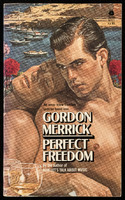 Perfect freedom
Perfect freedom This is another of Gordon Merrick’s (1916-1988) romance and sex novels published in paperback by Avon, with Victor Gadino illustrated covers. Avon was the paperback division of the Hearst Corporation, and ‘Gay Times’ claimed that publishing these novels was Avon's attempt to “cash in on the post-Stonewall gay market”. Based on one of his earlier novels, ‘Demon of Noon’ (1954) – an at-times-coded gay novel which is less explicit than his later work – this story is set in 1938 on a cruise in the Greek Islands and features Robbie’s sexual awakening with multiple partners. Some of the men he meets during his journey are listed and briefly described before the novel’s title page, including an “Italian deckhand”, a “Greek Adonis”, and a “brooding biker”. The title of the novel is a quote from E.M. Forster’s ‘The Longest Journey’.
-
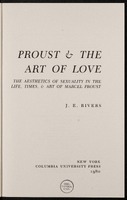 Proust & the art of love : the aesthetics of sexuality in the life, times, & art of Marcel Proust
Proust & the art of love : the aesthetics of sexuality in the life, times, & art of Marcel Proust Volume four of Marcel Proust’s (1871-1922) seven volume novel ‘À la recherche du temps perdu’ (‘In Search of Lost Time’) is entitled ‘Sodome et Gomorrhe’. Published in 1921/22, volume four is an early literary representation of gay and lesbian sexuality, focussing on characters including the decadent Baron de Charlus. Written by Julius Edwin (J.E.) Rivers (1944-), this book is a scholarly study and critique of Proust’s depiction of homosexuality covering biographical, historical and psychological elements. The book was published by the academic Columbia University Press and is held in multiple UK university libraries.
-
 Querelle of Brest
Querelle of Brest Set in the French port town of Brest, bisexual anti-hero Georges Querelle is a young sailor lusted after by his superior officer, by a local corrupt policeman and by the madam of a brothel. But Querelle is also a thief and a serial killer. ‘Querelle of Brest’ by Jean Genet (1910-1986) was first published anonymously in 1947 in a limited edition and illustrated with a series of homoerotic and sexually explicit line drawings by Jean Cocteau. It was prosecuted in France on grounds of indecency in 1954 but cleared in 1956. This edition from 1966 marks its first translation into English by Gregory Streatham. Rainer Werner Fassbinder’s last film, ‘Querelle’ (1982), is an adaptation of the novel. Genet himself was dishonorably discharged from the French Foreign Legion and imprisoned for committing ‘lewd’ (homosexual) acts.
-
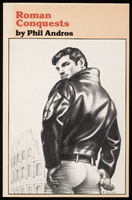 Roman conquests
Roman conquests The third Phil Andros (pseudonym of Samuel M. Steward, 1909-1993) book seized during the raids, this erotic novel is set in Rome where Andros meets and has sex with a range of characters, some of whom are described on the back cover, including “a sexton with a feeling for ritual” and “a carabiniere in black boots”. The book was first published in 1971 by the pulp publisher Gay Parisian Press under the title ‘When in Rome, Do...’ In keeping with his tendency to merge fact and fiction, Steward has dedicated this book to another of his alter egos, Ward Stames. This copy has an inscription from Andros to Gay’s The Word which refers to supposedly ‘obscene’ Roman classical works held at the British Museum.
-
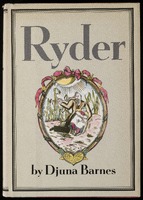 Ryder
Ryder This first novel by modernist writer and artist Djuna Barnes (1892-1982) was published in 1928 and focusses on the experiences of Wendell Ryder. The story is relayed in over fifty chapters of differing lengths, via experiments with literary form and style (including in a faux Medieval style, complete with explanatory footnotes). Part prose, part poetry, part play and accompanied by Barnes’s own illustrations, the novel was, for a time, a bestseller. Before publication, however, the proofs were seized by the New York Postal Service, who deemed them “obscene”. Barnes responded by removing some sections of the text and replacing them with asterisks. These textual markings are retained in this 1979 edition, although Barnes’s original foreword critiquing censorship is not. This was the edition seized at Gay’s The Word, making ‘Ryder’ a doubly censored book.
-
 S and M : studies in sadomasochism
S and M : studies in sadomasochism This anthology is part of a series entitled ‘New Concepts in Human Sexuality’ which was edited by Vern L. Bullough (1928-2006), a sexologist, historian and sociologist. The two editors of this volume, sociology professor Thomas Weinberg (1943-) and scholar and public health worker G.W. Levi Kamel (1947-1989), approach sadomasochism from a sociological rather than a psychopathological perspective although the book begins with acknowledgement of that traditional view in a chapter focussing on Richard von Krafft-Ebing, Sigmund Freud and Havelock Ellis. Most of the work considers the social behaviour of those involved with sadomasochism – gay and straight – via exploration of identity, interaction and organization. The book is published by Prometheus Books which was founded in 1969 by secular humanist and academic Paul Kurtz.
-
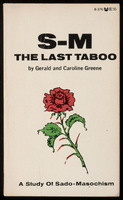 S-M : the last taboo
S-M : the last taboo The appearance of this book is reminiscent of a 1950s pulp novel, with its paperback cover and cheap, browning paper. It was published by Grove Press, a predominantly literary publisher of writers including John Rechy and Michael Rumaker, under their Evergreen Black Cat Book imprint. The authors are, presumably, a married couple, although there is very little information about them. It is also unclear whether the couple were involved in sadomasochism (which they prefer to call “s-m”) or distant researchers of it. At one point, in a section on purchasing s-m materials, they use the word “we”. The book aims to describe the “psychology, techniques, and accessories” of s-m. The final section, ‘From the Fields of Infamy’, presents literary examples of s-m, including by Charles Baudelaire and Pauline Réage.
-
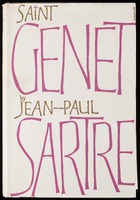 Saint Genet : actor and martyr
Saint Genet : actor and martyr First published in French in 1952, this biography of Jean Genet (1910-1986) is shown here in English translation. Written by one of the twentieth century’s most influential thinkers and writers Jean-Paul Sartre (1905-1980), this work is the first volume of and introduction to ‘The Complete Works of Genet’. Considering him a man out of his time, Sartre outlines Genet’s life from his birth and abandonment as a foundling child, through his times as a thief, prisoner, vagrant, sex worker and later, playwright and novelist. Genet was also an out gay man who both wrote about and was imprisoned for this part of his life. Two works by Genet, ‘Querelle of Brest’ and ‘Treasures of the Night – The Collected Poems of Jean Genet’, were also seized during the ‘Operation Tiger’ raids.
-
 Scotch verdict* : Miss Pirie and Miss Woods v. Dame Cumming Gordon
Scotch verdict* : Miss Pirie and Miss Woods v. Dame Cumming Gordon A “Scotch Verdict” results in the Scottish legal system if a case is “not proven” or is inconclusive. Using archival documents, historian Lillian Faderman (1940-) explores this outcome in the 1810 case of Edinburgh teachers Jane Pirie and Marianne Woods. The two women were accused by pupil Jane Cumming of having a sexual relationship which led to the removal of all pupils from the school. Having lost their work, Pirie and Woods brought a libel case against Jane’s grandmother, Dame Cumming Gordon, which ended in the titular Scotch Verdict. Unlike many of the ‘Operation Tiger’ titles, this book is still in print. The Pirie and Woods case also inspired Lillian Hellman’s 1934 play ‘The Children’s Hour’ which was later filmed.
-
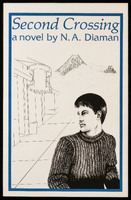 Second crossing : a novel
Second crossing : a novel N.A. (Nikos) Diaman (1936-2020), also known as Tony, was a novelist, video filmmaker, photographer, writer and magazine editor. Amongst the many groups he joined were the San Francisco Radical Faeries and the New York Gay Liberation Front (some of his work was published in the associated newspaper ‘Come Out!’). Based for many years in San Francisco, Diaman self-published novels under the imprint Persona Press which allowed him the space to tell stories about the gay community. This novel is set in the 1950s and follows a young writer as he explores his sexuality among San Francisco’s North Beach gay and literary circles. This copy is inscribed by Diaman to Gay’s The Word, wishing them well “in the battle against homophobia and censorship”.
-
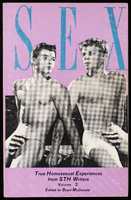 Sex : true homosexual experiences from S.T.H. Volume 3
Sex : true homosexual experiences from S.T.H. Volume 3 “Laughing out loud with a hard-on”, as one reader put it in the back-cover endorsements. This is the third in a series of thirteen anthologies from the self-published magazine ‘S.T.H.’, or ‘Straight to Hell’, which was founded circa 1973 by editor Boyd McDonald (1925-1993) and is still published today. The premise is simple – readers send in their accounts of real-life sexual experiences. These are published with minimal editorial intervention under tongue-in-cheek tabloid-style headlines (‘Priests Expect Students to Put Out’). The articles are illustrated with black-and-white nude photographs posed by models, cut-and-pasted from old magazines. Copies of ‘Sex’ were also seized by Canadian customs officers in the mid-1980s according to newspaper ‘Body Politic’.
-
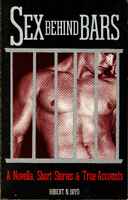 Sex behind bars: a novella, short stories and true accounts
Sex behind bars: a novella, short stories and true accounts This Gay Sunshine Press collection is a mix of fictional and non-fictional accounts of the (sexual) experiences of imprisoned gay men. Author Robert N. Boyd, who was a prisoner in Nevada, hoped the book would provide “a true perspective” and believed that this combination of fact and fiction, with some blurring between the two, was the most appropriate method of portraying that truth. Some of the stories and articles had previously been published in magazines such as soft-core pornography lifestyle titles ‘Mandate’ and ‘In Touch’, while others – such as the novella ‘No One Ever Wins’ - are new to this collection. On publication, ‘Sex Behind Bars’ was often advertised as erotica. Although Boyd agreed in an interview that it would be good if the book proved informative, his main aim was to entertain his readers rather than advocate for prison reform.
-
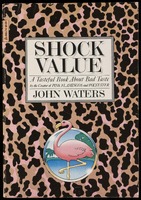 Shock value
Shock value This first book from John Waters (1946-) is a memoir of his early filmmaking years from his childhood puppet shows to his 1977 feature film ‘Desperate Living’. As a gay man with a deep and abiding love for both low- and highbrow cinema, his films feature over-the-top LGBTQ+ characters (and actors) and set out to shake up the status quo and shock his audience. As Waters explains in the book’s introduction, “to me, bad taste is what entertainment is all about”. The memoir is illustrated with film stills and photographs of Waters and his friends and associates, including Divine (1945-1988), the actor and drag queen who featured in several Waters films.
-
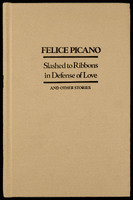 Slashed to ribbons in defense of love : and other stories
Slashed to ribbons in defense of love : and other stories Eleven semi-autobiographical short stories of gay love and sex in New York City (and popular gay beach resort, Fire Island). It was published by the collective Gay Presses of New York (Sea Horse Press, Calamus Press and J.H. Press). Felice Picano (1944-) founded Sea Horse Press in 1977 and the Gay Presses came together – with co-editors Terry Helbing and Larry Mitchell – in 1981. An award-winning writer, Picano had published several novels, short stories and a book of poems before this collection, and has been prolific since, producing memoir, plays, screenplays and co-writing ‘The New Joy of Gay Sex’ with Charles Silverstein in 1993. This copy is signed by the author and inscribed on the titlepage, “In brotherhood – and against censorship!”
-
 Special teachers/special boys
Special teachers/special boys “What happens here when a teacher comes out?” is the question this novel explores. The “here” is the fictional Lennox School for troubled boys, who are taught in small groups by a dedicated teacher – the special boys and special teachers of the title. Amongst the teachers is Bob Davidson, who is gay and comes out publicly on a television programme, an act which reverberates through the school and gives courage to two gay pupils. The novel was criticised in some quarters for the style of writing but praised for providing an antidote to prejudicial accounts of gay teachers. The authors, Peter Fisher (1944-2012) and Marc Rubin (1932-2007), were both gay activists. Rubin was also a teacher, and the book draws on his own experiences. It is dedicated to “the staff and boys of ‘The Lennox School’”.
-
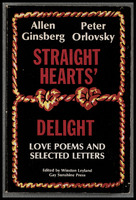 Straight hearts' delight : love poems and selected letters, 1947-1980
Straight hearts' delight : love poems and selected letters, 1947-1980 Containing thirty years of poetry and numerous letters, this book relates the lives and works of two key figures of the Beat Generation. Documenting chronologically the relationship between Allen Ginsberg (1926-1997) and Peter Orlovsky (1933-2010), the book is not only a record of their love but also of the milieu in which they lived and worked. The book contains previously unpublished poems and is illustrated, including with a Richard Avedon photograph of the authors naked. Edited by Winston Leyland, the authors were involved in the book’s production and contributed footnotes. As with many Gay Sunshine Press (and Fag Rag) publications, it was made possible in part by a grant from the National Endowment for the Arts, an independent federal agency established by the US Congress.
-
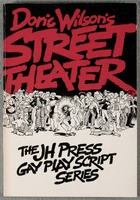 Street theater : the twenty-seventh of June, 1969, in two acts
Street theater : the twenty-seventh of June, 1969, in two acts Part of the ‘JH Press Gay Play Script’ series, the play is set on Christopher Street on the eve of the police raids on the Stonewall Inn bar which led to the Stonewall Uprising, in which Doric Wilson (1939-2011) was a participant. The “street theater” of the title is created by the characters including a “flower child”, “street queens”, a “vice cop”, a “student radical” and a “politically incorrect lesbian”. First performed in 1982 in San Francisco, the play later moved to New York. Wilson also worked as a barman, the tips from which helped support his theatrical endeavours, including TOSOS (The Other Side of Silence) an Off Off-Broadway theatre space.
-
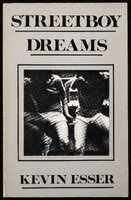 Streetboy dreams : a novel
Streetboy dreams : a novel ‘Streetboy Dreams’ by Kevin Esser (1953-) was published by two out of the three Gay Presses of New York, who note the “controversial and divisive” nature of its subject matter. The novel details the relationship between Peter, a teacher in his mid-thirties, and teenage Gito. Unlike Bruce, the adult protagonist of Wallace Hamilton’s ‘Kevin’, Peter is not presented as a gay character, per se – the novel opens with the end of “another fling at heterosexuality”. Marketed at the time as “a different approach” to what was euphemistically known as “man/boy love”, it is hard to read the novel today as anything other than the story of a grooming – a glorification of unequal power dynamics and dubiously consensual sexual experience.
-
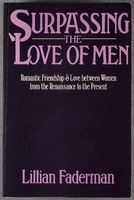 Surpassing the love of men : romantic friendship and love between women from the Renaissance to the present
Surpassing the love of men : romantic friendship and love between women from the Renaissance to the present Academic Lillian Faderman (1940-) uses literary and documentary sources to present a history of romantic love between women, one of the first comprehensive studies of its kind. Following initial research on poet Emily Dickinson’s love letters to her sister-in-law Susan Gilbert, Faderman expanded her scope to consider a period of five hundred years and the lives of many women (including those featured in the ‘Scotch Verdict’ case explored in another Faderman work seized during the raids). The book describes how societal attitudes to love between women moved from tolerance (albeit not to women who dressed as men), to prejudice and eventually, to liberatory lesbian feminism. The book, dedicated to Faderman’s partner Phyllis Irwin, is shown here in the UK edition, although it is likely to have been the US William Morrow edition that was seized from Gay’s The Word.
-
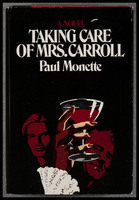 Taking care of Mrs. Carroll : a novel
Taking care of Mrs. Carroll : a novel This first novel by poet and novelist Paul Monette (1945-1995) begins with the sudden death of wealthy estate owner Mrs Beth Carroll and the introduction of her houseboy David who awakens in bed alongside John, the gardener. The narrative that follows, involving unsigned wills, forgery and impersonation, was described by one reviewer as “a most entertaining venture into fantasy, hilarity, and gay sex”. Monette’s later works, including a memoir of his partner Roger Horwitz’s illness and death from AIDS, took a more serious turn. Horwitz’s presence is felt in the novel displayed here – the book is dedicated to him, and the author photograph gracing the back cover was taken by him. Before Monette’s own death from AIDS, he founded the Monette-Horwitz Trust to honour individuals and organisations that fight to eradicate homophobia.
-
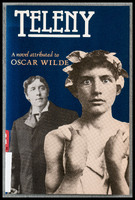 Teleny : a novel
Teleny : a novel This sexually explicit “Physiological Romance” was first published by pornographer Leonard Smithers in 1893 in a two-volume edition of 200 copies, anonymously and with a false place of publication to deter Victorian censors. Although ‘Teleny’ may have been produced collaboratively, strong hints that Oscar Wilde was at least the principal author were already circulating. It has been attributed to Wilde since the Olympia Press edition of 1954. ‘Teleny’ continued to be reprinted in expurgated editions over the course of the twentieth century. The Gay Sunshine Press edition is, according to editor Winston Leyland, “the first unexpurgated version in English based on the original manuscript”.
-
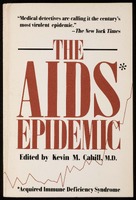 The AIDS epidemic
The AIDS epidemic In spring 1983, a “devastating, puzzling and fatal” new illness was spreading rapidly throughout the United States. At that time, some three to four years after the first cases of HIV/AIDS had emerged and under two years since the first cases were reported in the ‘New York Times’, New York City was the hardest-hit metropolitan area with 595 cases and 228 deaths. This astonishingly prescient book edited by physician Kevin Cahill (1936-2022) comprises the published proceedings of a symposium that took place at Lenox Hill Hospital, New York City. Doctors, epidemiologists and policy-makers gathered to discuss how they might combat the disease, stating that “there is every indication that we will soon be in the midst of a worldwide epidemic”. As of 2024, HIV has claimed over 40 million lives worldwide.
-
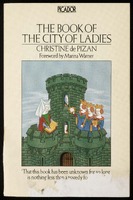 The book of the city of ladies
The book of the city of ladies This is quite possibly the most surprising book seized during the raids and certainly is the oldest narrative, first printed in French in 1405. Christine de Pisan (or Pizan) (1364-1430) was a Medieval Italian woman who lived in France and, following the death of her husband, wrote over twenty works to support her family. Using the device of a discussion with ladies called Reason, Rectitude and Justice, this work highlights women’s oppression, including lack of access to education and misogynistic portrayal in texts written by men, in words which have resonance for more contemporary feminist thought. As befits the times, the text is also underpinned by Christian values, and Christine spent her final years living in a convent. It is unclear which edition of the book was seized during the ‘Operation Tiger’ raids.
-
 The boy from Beirut : and other stories
The boy from Beirut : and other stories Robin Maugham (1916-1981), Second Viscount Maugham of Hartfield and nephew of the novelist W. Somerset Maugham, wrote short stories, novels, screenplays, plays and non-fiction. “Bisexual, though predominantly homosexual”, as he put it, Maugham published his first short story in 1943 (‘The 1946 Ms’, praised by George Orwell), turning more to gay themes in his post-1970 work. Published posthumously, Maugham’s ‘The Boy from Beirut’ consists of eight short stories, introduced by writer and former editor for ‘Gay News’, Peter Burton. These stories draw partly on Maugham’s time in North Africa during the Second World War and had all previously been published in the UK. The volume closes with Burton’s long interview with Maugham, first published in ‘Gay Sunshine’ magazine in the Summer/Fall edition, 1977 (no. 33/34).
-
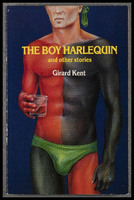 The boy harlequin : and other stories
The boy harlequin : and other stories Fourteen short stories from a now little-known American author Girard Kent, the nom-de-plume of a Texan writer named Lon Rogers. Though the collection did well enough for Gay Sunshine Press to bring out a second edition in 1985, its mildly distasteful blend of humour and eroticism has not dated well. Several stories feature sexual relationships between adolescent boys and adult men, and as a perceptive contemporary review in New Zealand magazine ‘Pink Triangle’ noted, the characters feel more like “fantasy material” than fully realised protagonists. ‘The Boy Harlequin’ was Kent’s first book, and he seems to have published nothing further, either under his own name or his pen name.
-
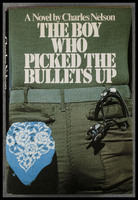 The boy who picked the bullets up
The boy who picked the bullets up Charles Nelson (1942-2003) served as a Marine in the Vietnam War and claimed that some of this novel was autobiographical. The story follows medic Kurt Strom during a year he spent stationed in Vietnam. Strom’s experiences as a gay Marine are relayed via letters he sends home to his family and friends. One reviewer described the novel as containing “endless humour and devastating realism”, while the gay perspective was praised for presenting “decidedly different” insights on war. The novel’s title is taken from the poem of the same name by Arthur Rimbaud. Published by William Morrow, the book’s dust jacket shows a soldier’s trousered backside, with a blue bandana in the left pocket, alluding to ‘flagging’, a coded means of expressing sexual preferences.
-
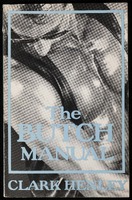 The butch manual : the current drag and how to do it
The butch manual : the current drag and how to do it A tongue-in-cheek manual for gay men on how to appear more ‘butch’, or stereotypically masculine, written in the style of a women’s magazine – complete with a problem page featuring Gertrude Stein as a fictional agony aunt. Butch men shun smiling, screaming and “misquoting Dorothy Parker” in favour of moustaches, yelling and talking dirty, according to author, model and artist Clark Henley (1950-1988). The book is undoubtedly influenced by the wildly popular contemporary humorous titles ‘The Official Preppy Handbook’ (1980) and ‘The Official Sloane Ranger Handbook’ (1982). Henley also drew the rare 1976 ‘Tails of the City’ ‘Alligator Oz’ map of San Francisco, a gay map of the city populated by cartoon alligators, and ‘A Butch Look at America’ (1982), in which the United States is represented by torn cut-off jeans over bare buttocks. Diagnosed HIV-positive in 1986, Henley died in San Francisco of AIDS-related causes in 1988, aged just 38.
-
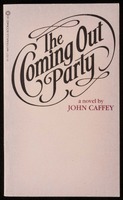 The coming out party : a novel
The coming out party : a novel Jaded by West Hollywood gay life, long-term lovers Cal and Sidney yearn for a new distraction. In this queer reworking of ‘My Fair Lady' they find one in a young gay man, overweight college student, Hal. They take him on as a project, schooling him in Tennessee Williams, ‘Brideshead Revisited’ and E.M. Forster’s ‘Maurice’ and putting him through a punishing programme of physical transformation. Republished in 2001 via self-publishing platform iUniverse, this second edition is described as “A novel so outrageous it was banned in England!”, a possible reference to ‘Operation Tiger’. The blurb also claims Caffey won a PEN Award for an Outstanding First Work of Fiction, receiving a Special Commendation in 1983. However, no evidence either for this specific award or this commendation can be found.
-
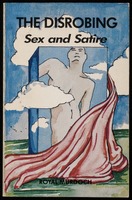 The disrobing : sex and satire
The disrobing : sex and satire Poet and author Royal Murdoch, known to friends as Kenneth, was born in California in 1898 and moved to Mexico City in the mid-1960s, where he died in 1981. ‘The Disrobing’, ten copies of which were seized in the ‘Operation Tiger’ raids, is a posthumously published collection spanning fifty years, including poetry, diary extracts, letters and part of an unfinished novel. It was edited by Gay Sunshine’s Winston Leyland. Murdoch himself wrote of ‘Gay Sunshine Journal’ that “I was already an old man when I first saw an issue” and “each issue brings me a renewed sense of liberation”. Murdoch’s prose works in particular describe life in pre-Stonewall America. His papers are now held by the Harry Ransom Center, The University of Texas at Austin.
-
 The front runner
The front runner After the Stonewall Uprising, many mainstream publishers realised they could have commercial success with gay fiction. ‘The Front Runner’ was the first bestselling novel of this era, selling millions of copies when first published in 1974 by William Morrow. The story concerns Billy Sive, a young, gay athlete training for the 1976 Olympics, and his relationship with his older sports coach. Patricia Nell Warren (1936-2019), who was also an athlete, considered the novel’s publication to be a step in her own coming-out process. Latterly, Warren self-published lesbian fiction under the Wildcat Press imprint, fought online censorship laws and was one of the initial fifty nominees for the National LGBTQ Wall of Honor in New York City. The edition seized was probably the 1975 Bantam Books paperback rather than the one on display here.
-
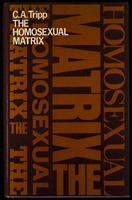 The homosexual matrix
The homosexual matrix First published in America by McGraw-Hill in 1975, the preface to this British edition includes author C.A. Tripp’s (1919-2003) reflections on the book’s initial reception. More positively received than the author had hoped among the scientific community and in much of the media, including ‘Newsweek’, it nevertheless provoked anti-gay moralising in ‘Time’ magazine and ‘The New York Times’, while some papers cancelled their reviews altogether. Tripp, a psychotherapist, fails to mention that the book was also criticised by LGBTQ+ reviewers for its pseudo-scientific categorisation of gay men into ‘types’, its misogyny, and its refusal to engage with gay liberation as a social movement. The striking typographic cover design is by Marcy J. Katz. The edition on display is from the library of actor, author and bookseller Noel Lloyd.
-
 The journey
The journey This knowingly ahistorical lesbian feminist Western, set in Canada and the US in the nineteenth century, is dedicated to “all the little girls who always wanted to [...] grow up to be cowboys”. Teenager Anne leaves home and teams up with sex worker Sarah. Travelling together across the Pacific Northwest, they become lovers, have a child and receive support from a matrilineal group of Indigenous people. Despite reversing gender roles, the novel is in other ways a romp through the stereotypes of the Western genre – wagons, guns, vigilante justice. Anne Cameron (1938-2022) was a prolific writer of fiction for adults and children, as well as poetry and drama for stage and screen. Born Barbara Cameron, she later wrote under the name Cam Hubert. ‘The Journey’, her third novel, was reissued in 1986 by feminist press Spinsters/Aunt Lute.
-
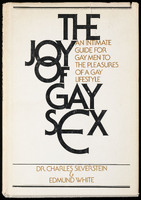 The joy of gay sex : an intimate guide for gay men to the pleasures of a gay lifestyle
The joy of gay sex : an intimate guide for gay men to the pleasures of a gay lifestyle A collaboration between Dr Charles Silverstein (1935-2023) and novelist Edmund White (1940-), “by gays, for gays”. Structured as an A-to-Z guide to gay life, from Androgyny to Wrestling, plus a short bibliography, it is illustrated throughout by Michael Leonard, Ian Beck and Julian Graddon. Riding high on the popularity of ‘The Joy of Sex’ (1972), it sold out its first print run of 75,000 copies. Some commentators, however, were critical of this apparent mainstreaming. “If we have reached a point where cultural interests include the marketing of our sex lives, it would be nice for some basic civil rights to come along with that,” wrote Michael Bronski in ‘Gay Community News’ in November 1977. “You can still get arrested for having a good time.” The book was later used in healthcare during the AIDS crisis, and ‘The New Joy of Gay Sex’ (1993) was substantially updated with safe sex information.
-
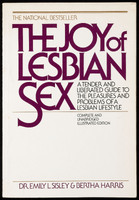 The joy of lesbian sex : a tender and liberated guide to the pleasures and problems of a lesbian lifestyle
The joy of lesbian sex : a tender and liberated guide to the pleasures and problems of a lesbian lifestyle Published a year after ‘The Joy of Gay Sex’, the subtitle of this volume introduces the “problems” as well as “pleasures” of lesbian life in marked contrast to its gay male counterpart. Written by Dr Emily L. Sisley (1930-2016) and novelist and Daughters, Inc. founder Bertha Harris (1937-2005), and illustrated by Yvonne Gilbert, Charles Raymond and Patricia Faulkner, it follows the formula set by ‘The Joy of Sex’ in 1972. It covers all aspects of lesbian life and sexuality from “Alcohol and sex” to “Water, water, everywhere”, followed by a bibliography. It had a smaller initial print run than ‘The Joy of Gay Sex’ – 50,000 rather than 75,000 copies – and its reception was mixed. One (lesbian) reviewer objected to its misandry while another suggested its “authors cling to the concept of a penis”. It was also criticised for its omissions, “myths and misconceptions”, particularly around disability, race and class.
-
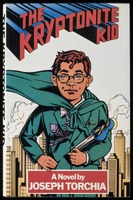 The Kryptonite kid : a novel
The Kryptonite kid : a novel An affecting novel of one-sided letters to Superman from schoolboy Jerry Chariot and his best friend Robert Sipanno. Filled with a mixture of curiosity and naivety (down to the preservation of Jerry’s childlike spelling and grammar), the letters wrestle with everyday problems of homelife, hero-worship and Catholic schooling as well as questions about what “a queer” is and whether Superman pees out of his “Thing”. Joseph Torchia (1946-1996), a journalist for various newspapers on the West Coast of the US, published one other full-length work and a short story, and wrote two further unpublished novels. He turned to photography later in life. His papers are held at Stanford University.
-
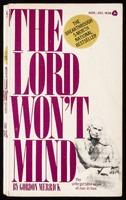 The Lord won't mind
The Lord won't mind This is the opening book in a gay romance trilogy by Gordon Merrick (1916-1988), first published in 1970. Young, handsome and improbably well-endowed Charlie Mills is introduced to the equally attractive Peter Martin in late 1930s New Jersey. It is love – and lust – at first sight. Advertised in ‘The New York Times’ as “the first homosexual novel with a happy ending”, the book spent sixteen weeks in the ‘Times’ top ten, becoming a bestseller that secured Merrick’s fortunes. Criticised for its misogyny and as “corny, oddly dated and saccharine” by a discerning reviewer for ‘Gay NYC’, it nonetheless became a guilty pleasure for generations of gay men.
-
 The Nazi extermination of homosexuals
The Nazi extermination of homosexuals This book, which is held in several UK academic libraries, outlines the treatment of gay men in Germany during the Third Reich. Much of the research is based on secondary sources which expose increasing societal homophobia, culminating in the imprisonment of gay men in concentration camps where they were forced to wear a pink triangle stitched to their clothing and undergo horrific, brutal treatment. The final two chapters focus on personal, pseudonymous testimony from men who survived, including an extract from a 1972 German book, published in English in 1980, entitled ‘The Men with the Pink Triangle’. By the 1980s, the pink triangle symbol had been reclaimed by LGBTQ+ activists.
-
 The New York diary of Ned Rorem
The New York diary of Ned Rorem The ‘New York Diary’ begins with Ned Rorem (1923-2022) returning home from Paris and is the second volume of Rorem’s diaries, covering the period 1955-1961. As with the previous volume, Rorem uses the diary form to discuss the – often famous – people he meets, his thoughts on the life of an artist and his own personal life, including his relationships and alcoholism. Rorem noted that these New York diaries were “less frivolous and more outspoken” than those he wrote in Paris. The exhibition shows Rorem’s diaries in two separate volumes, although in the list of books seized from Gay’s The Word they are listed as one title. It is likely, therefore, that the combined edition published by US paperback imprint Avon was the one seized.
-
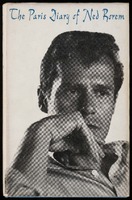 The Paris diary of Ned Rorem
The Paris diary of Ned Rorem Ned Rorem (1923-2022) was an American composer of modern classical music, for which he was awarded the Pulitzer Prize for Music in 1976 and a Grammy in 1989. Rorem was also gay, and documented his life in a series of diaries which began with his ‘Paris Diary’, covering the early 1950s when he was in his late twenties. Famed not only for his musical talent but also his good looks, Rorem was a dedicated socialite who gained entry to the Parisian artistic scene under the mentorship of Vicomtesse Marie-Laure de Noailles. This selection of his diaries shows the extent of Rorem’s connections not only via his writing but also through the inclusion of photographs taken of him by artists such as Man Ray and a portrait illustration by Jean Cocteau.
-
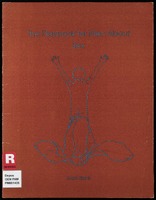 The playbook for men about sex
The playbook for men about sex Author and publisher Joani Blank (1937-2016) described this playbook as the “companion piece” to the ‘Playbook for Women About Sex’. The two titles follow the same format and style and aim to encourage sexual awareness in the reader through the questioning and reflective prompts of a workbook. Blank notes at the start that she was compelled to write this title as no man had done so, although she was assisted by men who advised, edited and reviewed the playbook. The honest and direct content of the playbooks for men and women and the other sex positive titles published by Blank’s Down There Press, meant it was often difficult to locate printers who were willing to produce the books. In 1980, Blank co-authored ‘The Playbook for Kids About Sex’ which was condemned by the UK’s Conservative government in their election campaigning.
-
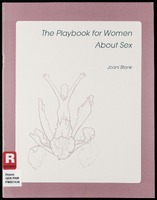 The playbook for women about sex
The playbook for women about sex Using her experience working in sex therapy and family planning, Joani Blank (1937-2016) founded Down There Press in 1975 to publish sex positive books. The first title was this 23-page playbook (or workbook) which uses direct language, illustrations and interactive questions to promote sexual self-awareness for women. The cover illustration is by lesbian artist Tee A. Corinne. The playbook includes sections on masturbation, honest communication with partners and body image. Blank stated that she took “the word ‘play’ very seriously”, but the workbooks also contain humour, as expressed in the final pages which contain a certificate declaring the reader a ‘Bona-Fide Sexually Self-Aware Woman’. Two years after publishing this playbook, Blank founded the Good Vibrations shop in San Francisco, selling sex toys to women. This is one of three books published by Down There Press that were seized during the raids.
-
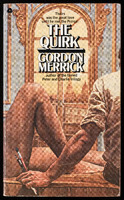 The quirk
The quirk As with other Gordon Merrick (1916-1988) novels published by Avon Books, the cover of ‘The Quirk’ is the work of artist Victor Gadino. The style of these Avon paperbacks alludes to the romances published by Mills and Boon in the UK (or Harlequin in the USA), but in this case, they are aimed at gay readers. Gadino used male models as the basis of his illustrations which, unusually for the time, depict the men together and looking at each other rather than separate and isolated. In this instance, the full illustration wraps around the front and back covers. This novel centres on Rod, a bisexual artist in 1960s Paris who has relationships with men and a woman during the novel.
-
 The rose exterminator : a novel
The rose exterminator : a novel This gay sado-masochistic mystery novel was the third and final work of fiction by William Carney (1922-1987), after ‘The Real Thing’ (1968) and ‘A Year in a Closet’ (1974). If it seems a niche subgenre, it was one Carney carved out for himself successfully, alongside employment as a university teacher of French – ‘The Real Thing’ was influenced by Pierre Choderlos de Laclos’s eighteenth-century epistolary novel ‘Les Liaisons Dangereuses’ – and as a restorer of Victorian and Edwardian houses. As well as being a guide to the S/M lifestyle and the first generation of West Coast ‘leathermen’, Carney’s books provide an insight into late 1960s and 1970s gay life in San Francisco more generally. Carney’s papers are now held at the Bancroft Library, University of California, Berkeley.
-
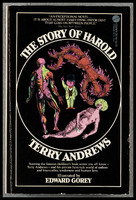 The story of Harold
The story of Harold Underground classic ‘The Story of Harold’ was written under the pseudonym Terry Andrews by acclaimed children’s author George Selden (1929-1989), best-known for ‘The Cricket in Times Square’, winner of a Newbery Honor in 1961. It describes the mostly doomed, often sadomasochistic affairs of a bisexual children’s author named Terry Andrews – whose children’s book, ‘The Story of Harold’, is wildly popular – but who is otherwise on the verge of emotional and physical breakdown. Andrews finds healing by re-working incidents in his own life through stories about his character, Harold, which he relates to the young sons of his friend and lover. The novel is illustrated with several full-page pen-and-ink drawings by Edward Gorey, known for ‘The Gashlycrumb Tinies’ and ‘The Doubtful Guest’ among other works.
-
 The sunny side of Castro Street : a diary of sorts
The sunny side of Castro Street : a diary of sorts A detailed, first-person account of bars, cruising and bathhouses in 1970s San Francisco by Dan Vojir (1947-). It also includes an extended memoir of growing up gay in a second-generation Czech immigrant family in Berwyn, Illinois, before Vojir moved to San Francisco’s Castro neighbourhood in 1974. “It’s a charmer”, proclaimed one contemporary reviewer. Vojir was a writer for the ‘Castro Times’ newspaper and worked in publishing as well as hosting a radio talk show, ‘Strictly Books’. ‘The Sunny Side of Castro Street’ is illustrated by Ku Fu-Sheng in a distinctive style which combines pencil and pen-and-ink sketches with photographic collage.
-
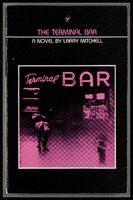 The terminal bar : a novel
The terminal bar : a novel Self-published by Larry Mitchell (1939-2012) of Calamus Books, one third of the Gay Presses of New York collective, this novel is set in a real Times Square bar which was popularly known as the “roughest” in New York but which was a sanctuary for its clientele. Based on Mitchell’s experiences and those of his friends, the novel follows a group of lesbians and gay men against a backdrop of a decaying America, symbolised by the Three Mile Island nuclear incident in 1979. The novel has also been considered the first work of fiction to reference AIDS. The copy of the book on display is inscribed to Gay’s The Word by the author “In defence of the freedom to read”.
-
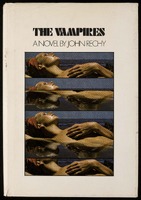 The vampires
The vampires This novel is the second by Mexican-American author John Rechy (1931-) to be seized during the ‘Operation Tiger’ raids. The vampires of the title are metaphorical, as a disparate group of people gather on a Caribbean island and unleash their darkest desires via Satanic rituals and witchcraft. The novel is filmic in style and has a character list which includes actresses, priests (Voodoo and Catholic), a “madam”, a possibly murderous male sex worker and “a drug goddess”. In one of their catalogues, Philadelphia gay bookstore Giovanni’s Room described this novel as a departure for Rechy, particularly as it was “non-gay”, although ‘Gay Times’ noted it still had enough in the contents to be interesting to gay readers.
-
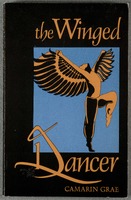 The winged dancer
The winged dancer A “grown-up lesbian adventure story”, according to New Zealand’s feminist magazine ‘Broadsheet’. Part murder mystery, part tale of psychological development, part love story, it describes lesbian feminist Kat Rogan’s journey from Chicago to the fictional Latin American country of Marigua. Rogan spends time in prison, solves the case and also comes to terms with the dominant and submissive sides of her personality. The book was criticised by some reviewers for exoticising South America and failing to engage with the politics of the region. Camarin Grae (1941-), author of ‘Paz’ (1984) and ‘Soul Snatcher’ (1985), among other works, was the owner of Blazon Books – this was their first title.
-
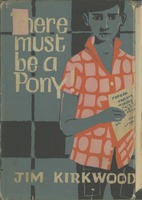 There must be a pony!
There must be a pony! Written in a style distinctly reminiscent of J.D. Salinger’s ‘The Catcher in the Rye’ (1951), this is the story of “sensitive” sixteen-year-old Josh, his film star mother Rita Cydney, and her relationship with the mysterious Ben. Its queer content is largely subtextual, but a 1963 write-up in the ‘Mattachine Review’ by Gene Damon (pseudonym of legendary lesbian bibliographer Barbara Grier) noted its “sensitive handling of a boy’s first comprehension of homosexuality, with the aid of an older, well-presented man”. ‘There Must Be a Pony!’ was adapted into a television drama in 1986, starring Elizabeth Taylor as Rita. James Kirkwood (1924-1989) stated in an interview that the book was based on his own relationship with his mother, actress and silent film star Lila Lee, about whom he said, “She should have had puppies or kittens, not a kid”. Kirkwood’s ‘'P.S. Your Cat is Dead’ was also seized in ‘Operation Tiger’.
-
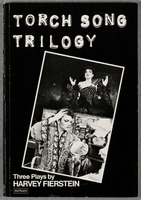 Torch song trilogy : three plays
Torch song trilogy : three plays ‘Torch Song Trilogy’ has three acts titled ‘International Stud,’ ‘Fugue in a Nursery’ and ‘Widows and Children First!’ Each deals with a different phase in the life of Arnold Beckoff, a gay, Jewish drag queen and torch singer in 1970s and 1980s New York. Receiving criticism from some for upholding ‘family values’, for others, the trilogy’s exploration of gay marriage and adoption was radical during a time of conservative backlash. Harvey Fierstein (1954-) won a Tony Award for Best Play in 1983 as well as for Best Performance by a Leading Actor. First published in 1981 by the Gay Presses of New York, this edition was published in the UK to tie in with its West End premiere at Albery Theatre (now the Noël Coward Theatre) in 1985. Fierstein has since blazed a trail for queer representation on stage and screen.
-
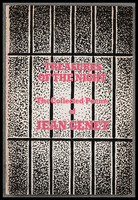 Treasures of the night : the collected poems
Treasures of the night : the collected poems A collection of six long poems by Jean Genet (1910-1986), first published between 1942 and 1948. They are presented here in a bilingual French/English version for the first time by translator Steven Finch, with the authorisation of Jean Genet and publisher, Éditions Gallimard. The French original occupies the verso (left hand side) and the English is printed on the recto (right hand side) in a facing page layout. Finch describes Genet’s poems as “a rich contribution to the expression of the gay movement and spirit”. This edition also includes the cover artwork of the rare first edition of Genet’s ‘Poèmes’, published by L’Arbalète in 1948, as well as striking, graphic black-and-white drawings by Bill Sullivan.
-
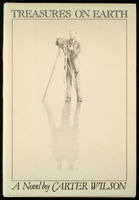 Treasures on earth : a novel
Treasures on earth : a novel This novel is a fictionalised depiction of a real expedition to Machu Picchu in Peru which was undertaken by Hiram Bingham in 1911. Running parallel to the main narrative is the story of the trip’s photographer, Willie Hickler, who discovers his sexuality when he falls in love with the expedition’s Peruvian assistant, Ernesto. Author Carter Wilson (1942?-), who later became an academic and Professor of Community Studies, described this book as “my coming-out novel”. The book was published by the well-established Knopf imprint and received good reviews, including from Christopher Isherwood who compared it to E. M. Forster’s ‘A Passage to India’.
-
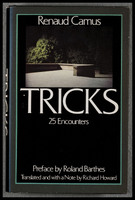 Tricks : 25 encounters
Tricks : 25 encounters “Homosexuality”, Renaud Camus (1946-) reminds the reader of ‘Tricks’ in his foreword, “has a history, and of course, a geography”. These stories of sexual encounter, translated by distinguished gay poet Richard Howard (1929-2022), move from late 1970s Paris to Milan to the United States. In the preface, literary theorist Roland Barthes notes these short narratives’ simplicity, their repetitive nature, and also their status as literature rather than pornography. Each begins with a name and a date, before detailing a sexual liaison between Camus and a man he has never met before. Each ends with a note on their subsequent relationship (if any). Previously a columnist for ‘Gai Pied’ and a socialist, Camus is now a conspiracy theorist and white nationalist, who developed the far-right ‘Great Replacement’ theory.
-
 True to life adventure stories. Vol. 1
True to life adventure stories. Vol. 1 Judy Grahn (1940-) is a poet, lesbian feminist and advocate of women’s spirituality. She also wrote 1984’s ‘Another Mother Tongue’, a mythic queer history. In response to Grahn’s question, “what is a woman’s adventure story?”, this book presents stories by twenty writers which relate women’s direct experiences. Writing by working-class women is a strong feature of the collection, with an emphasis on maintaining the authors’ unedited natural language and spelling. The book was published by Diana Press, a feminist printing and publishing house founded in 1972 by Coletta Reid and Casey Czarnik. The cover illustration is by Karen Sjöholm, who also worked at the Press. The Press was vandalised in 1977, with damage to plates, paste-ups, books and machines. It closed in 1979.
-
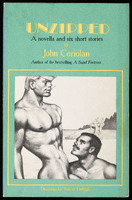 Unzipped : a novella and six short stories
Unzipped : a novella and six short stories The opening line of the first short story in this collection, aptly illustrated by Tom of Finland (Touko Laaksonen), gives a representative flavour – “At fourteen, Vincent Conte didn’t know whether he had a big cock or an ordinary one – at fifteen, he found out”. The back cover blurb declares that “Through all seven pieces runs a single theme – the explicitly detailed celebration of male-male sex, the excitement, the romance, the fun of it”. One reviewer for Australian publication ‘OutRage’ was less impressed, however, stating that the illustrations were the most exciting part of the book. American author John Coriolan wrote several other erotic novels from the late 1960s onwards.
-
 What Dillinger meant to me
What Dillinger meant to me This poetry collection from Robert Peters (1924-2014), his eighteenth, contains a mix of new poems and some that were published in earlier books and little magazines, such as ‘The Berkeley Poetry Review’. This volume is autobiographical, focussing on the poet’s childhood, family and society in rural Wisconsin during the Great Depression of the 1930s. The American gangster John Dillinger was involved in a shootout in the nearby Little Bohemia Lodge – his image adorned the young Peters’s bedroom wall, and he appears throughout this collection. Peters’s burgeoning sexuality is explored in poems such as ‘Tommy McQuaker’, about a local gay man who defiantly “walked like a woman down Main Street”, inspiring both fear and desire. Published by the Sea Horse Press, the book is dedicated to Peters’s parents.
-
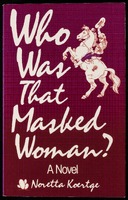 Who was that masked woman?
Who was that masked woman? Bertha Harris, co-author of ‘The Joy of Lesbian Sex’, described this coming-of-age novel as “an authentic slice of lesbian Americana”. The novel follows young lesbian Tretona Getroek, from her childhood on a farm amidst religious Revival meetings, through to university and travels that take her to Turkey and England. She also explores her sexuality while combatting the prejudices of the church, education and psychiatric establishments. Tretona is the masked woman of the title, hiding her identity. Noretta Koertge (1935-) wrote a sequel to this novel, 1984’s ‘Valley of the Amazons’, and was part of the Daughters, Inc. publishing collective. She is currently Emeritus Professor of the History and Philosophy of Science and Medicine at Indiana University.
-
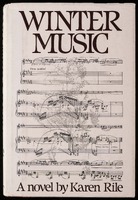 Winter music
Winter music Set in the Philadelphia classical music scene of the late 1970s, Karen Rile’s first and only novel concerns gay concert flautist Lawrence Chatterjee, whose performance career has been cut short following an accident, and child flute prodigy Gabriel, who also loves Kool-Aid and the Beatles. Rile herself studied flute at university level, before going on to become a writer and journalist for publications including ‘The New York Times’, ‘The San Francisco Chronicle’ and ‘The Philadelphia Enquirer’, and her fiction and creative nonfiction have appeared in several literary magazines. She teaches fiction and creative nonfiction at the University of Pennsylvania.
-
 Witchcraft and the gay counterculture : a radical view of Western civilization and some of the people it has tried to destroy
Witchcraft and the gay counterculture : a radical view of Western civilization and some of the people it has tried to destroy This book by Arthur Evans (1942-2011) is a rebuttal to the homophobic bias of “professional historians” and academics. Merging myth and history, the text is a self-proclaimed radical and subjective vision of a pre-Christian world of nature societies, which touches on many themes including Druids, Gnosticism, witchcraft, matriarchy, class politics and magic as a collective endeavour. Published by the Boston-based Fag Rag collective, it was edited by two of its members, Michael Bronski and Charles Shively, and chapters were initially published in the journals ‘Out’ and ‘Fag Rag’. Active in gay liberation movements, Evans was a co-founder of the Gay Activists Alliance and of the San Francisco Faerie Circle. This text is still in print in pirated editions and remains popular with Radical Faeries.
-
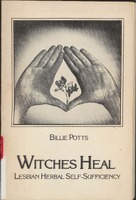 Witches heal : lesbian herbal self-sufficiency
Witches heal : lesbian herbal self-sufficiency Billie Potts (1940-2013) was one third of Elf and Dragons, self-described “lesbian witches”, who were a Woodstock-based women’s land collective, a publisher, distributor of herbs and part of a wider feminist spirituality movement. Women’s rural collectives were common in the USA at this time. Potts’s book is a guide to herbalism and an “access tool”, promoting self-sufficiency and encouraging lesbian women to reclaim their role as healers. The book proved controversial as its publication coincided with an acrimonious split within Elf and Dragons. Susun R. Weed accused Potts of using her work uncredited and asked feminist bookshops not to stock the book. The ‘Operation Tiger’ raids were not, therefore, the first attempts to restrict this book.
-
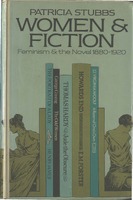 Women and fiction : feminism and the novel, 1880-1920
Women and fiction : feminism and the novel, 1880-1920 First published in 1979, this academic monograph was reissued as a Methuen University Paperback in 1981. Somewhat enigmatically referred to in Gay’s The Word’s list of seized books as ‘Women fiction’, it is one of the more unexpected items to be confiscated by Customs, who seized four copies in October 1984. Patricia Stubbs discusses the relationship between literary depictions of women and the roles and possibilities available to them in the late nineteenth and early twentieth centuries. As the copy on display here demonstrates, the book was also available in academic libraries. This is Senate House Library’s own copy and has been heavily marked up by studious readers.
-
 Women and madness
Women and madness Since publication in 1972, this feminist work on women’s psychology has sold over 2.5 million copies. Psychologist Phyllis Chesler (1940-) interviewed women who had been psychiatry or psychotherapy patients and wove their experiences into a book which explores the ways in which women are stigmatised, abused and oppressed by a patriarchal medical establishment. The book is held in multiple UK academic libraries. It is unclear which edition of the book was seized during ‘Operation Tiger’ – the Allen Lane edition is shown here – but more likely it was the 1973 version from the US mass market publisher Avon Books. Chesler sued the owners of Avon for publishing the book with differences from her original text.
-
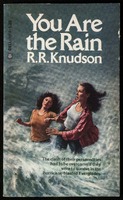 You are the rain : a novel
You are the rain : a novel When a hurricane strikes an all-girl canoe trip in the Florida Everglades, athletic Crash and introvert June become separated from the group and must depend on each other to survive. The novel is described as being “Of lesbian interest” in the 1975-76 catalogue of women’s bookstore First Things First, although the relationship is implied rather than overt. The novel is endorsed on the back cover by lesbian poet Adrienne Rich, with several references to the poetry of Emily Dickinson throughout. The title is taken from a May Swenson poem – “I will be earth you be the flower / You have found my root you are the rain”. Swenson and R.R. Knudson (1932-2008) were lovers in the mid-1960s. They collaborated on the collection ‘American Sports Poems’ (1988), and Knudson was Swenson’s literary executor on her death in 1989.
 A brother's touch Angus Rivers, a young Vietnam veteran from upstate New York, ventures to the city to discover the truth about his teenage brother’s death. Earl, a gay sex worker, has been found dead of a heroin overdose on the West Side piers (a notorious cruising ground), his body “stuffed into a rusty oil drum”. This mass-market crime paperback depicts the New York gay scene as a sleazy underworld of addicts, hustlers, self-serving politicians and corrupt priests. But it also introduces gay politics and campaigning, through the activities of the ‘GLP’ or Gay Liberation Party. Positively reviewed in the ‘New York Times’ on publication, Owen Levy’s debut went on to sell very well. His second novel, ‘Goodbye Heiko, Goodbye Berlin’, was published in 2015.
A brother's touch Angus Rivers, a young Vietnam veteran from upstate New York, ventures to the city to discover the truth about his teenage brother’s death. Earl, a gay sex worker, has been found dead of a heroin overdose on the West Side piers (a notorious cruising ground), his body “stuffed into a rusty oil drum”. This mass-market crime paperback depicts the New York gay scene as a sleazy underworld of addicts, hustlers, self-serving politicians and corrupt priests. But it also introduces gay politics and campaigning, through the activities of the ‘GLP’ or Gay Liberation Party. Positively reviewed in the ‘New York Times’ on publication, Owen Levy’s debut went on to sell very well. His second novel, ‘Goodbye Heiko, Goodbye Berlin’, was published in 2015. A comfortable corner Set in 1980s New York, this second novel by Vincent Virga (1942-) deals with the issue of alcoholism within the gay community and how it affects couple Terence and Christopher. Reviews of the novel acknowledged the importance of the theme, but noted it was presented in a florid style, described by one reviewer as “‘purple’ (lavender?) prose”. The novel is dedicated to the memory of American artist, Jackson Pollock, who suffered from alcoholism. The book was published in a mass market edition by Avon Books, publishers of Virga’s first novel, ‘Gaywyck’, which was also seized during ‘Operation Tiger’.
A comfortable corner Set in 1980s New York, this second novel by Vincent Virga (1942-) deals with the issue of alcoholism within the gay community and how it affects couple Terence and Christopher. Reviews of the novel acknowledged the importance of the theme, but noted it was presented in a florid style, described by one reviewer as “‘purple’ (lavender?) prose”. The novel is dedicated to the memory of American artist, Jackson Pollock, who suffered from alcoholism. The book was published in a mass market edition by Avon Books, publishers of Virga’s first novel, ‘Gaywyck’, which was also seized during ‘Operation Tiger’. A day and a night at the baths This book describes Michael Rumaker’s (1932-2019) first visit to the baths at West 28th Street, Manhattan. Although not named, this was the location of the Everard Turkish and Russian baths, which opened in 1888 and became a meeting place for gay men. Tragedy hit the increasingly run-down building in 1977, when nine men died in a fire so devastating it made newspaper headlines. This book is dedicated to all those who were at the Everard Baths during the fire and particularly “to the spirit of the rainbow gay and lesbian phoenix, rising” from the ashes. The publisher is Donald Allen whose Grey Fox imprint published works by several Beat authors, including Allen Ginsberg, whose words of praise for this book are on the back cover. Earlier in his career, Rumaker was aligned with the Beat movement.
A day and a night at the baths This book describes Michael Rumaker’s (1932-2019) first visit to the baths at West 28th Street, Manhattan. Although not named, this was the location of the Everard Turkish and Russian baths, which opened in 1888 and became a meeting place for gay men. Tragedy hit the increasingly run-down building in 1977, when nine men died in a fire so devastating it made newspaper headlines. This book is dedicated to all those who were at the Everard Baths during the fire and particularly “to the spirit of the rainbow gay and lesbian phoenix, rising” from the ashes. The publisher is Donald Allen whose Grey Fox imprint published works by several Beat authors, including Allen Ginsberg, whose words of praise for this book are on the back cover. Earlier in his career, Rumaker was aligned with the Beat movement. A family matter : a parents' guide to homosexuality Psychologist Charles Silverstein (1935-2023) was a writer and pioneering advocate for LGBTQ+ rights. His presentation to the American Psychiatric Association (APA) contributed to the removal of homosexuality as a mental illness from the APA’s ‘DSM’ (the ‘Diagnostic and Statistical Manual’) in 1974. Three years later, he published his first book, ‘The Joy of Gay Sex’, co-authored with Edmund White – another ‘Operation Tiger’ seized title – and, in the same year, ‘A Family Matter’. While ‘The Joy of Gay Sex’ focused on a community of men who have sex with men, ‘A Family Matter’ is a contribution to the genre of books intended to help parents of lesbian and gay children “come to terms with their own feelings about homosexuality”. In a briefing document about the seized titles, the Defend Gay’s The Word Campaign noted that the book was “Dedicated to his ma and pa!!”
A family matter : a parents' guide to homosexuality Psychologist Charles Silverstein (1935-2023) was a writer and pioneering advocate for LGBTQ+ rights. His presentation to the American Psychiatric Association (APA) contributed to the removal of homosexuality as a mental illness from the APA’s ‘DSM’ (the ‘Diagnostic and Statistical Manual’) in 1974. Three years later, he published his first book, ‘The Joy of Gay Sex’, co-authored with Edmund White – another ‘Operation Tiger’ seized title – and, in the same year, ‘A Family Matter’. While ‘The Joy of Gay Sex’ focused on a community of men who have sex with men, ‘A Family Matter’ is a contribution to the genre of books intended to help parents of lesbian and gay children “come to terms with their own feelings about homosexuality”. In a briefing document about the seized titles, the Defend Gay’s The Word Campaign noted that the book was “Dedicated to his ma and pa!!” A thirsty evil : seven short stories Gore Vidal (1925-2012) was a writer of novels, short stories, plays, essays, and screenplays, on a diverse range of subjects, published across many decades. Some of Vidal’s works centre on gay characters or themes, including some of the tales featured in this collection of seven stories. This edition, which was seized in the raids, was published by Gay Sunshine Press, although it is a reprint of the 1956 first edition published by Zero Press. Additionally, some of the stories had originally been published in magazines. Readers, therefore, had twenty-five years of access to this book’s contents prior to the ‘Operation Tiger’ raids. The front cover shows an illustration by Joe Fuoco.
A thirsty evil : seven short stories Gore Vidal (1925-2012) was a writer of novels, short stories, plays, essays, and screenplays, on a diverse range of subjects, published across many decades. Some of Vidal’s works centre on gay characters or themes, including some of the tales featured in this collection of seven stories. This edition, which was seized in the raids, was published by Gay Sunshine Press, although it is a reprint of the 1956 first edition published by Zero Press. Additionally, some of the stories had originally been published in magazines. Readers, therefore, had twenty-five years of access to this book’s contents prior to the ‘Operation Tiger’ raids. The front cover shows an illustration by Joe Fuoco. Adonis García : a picaresque novel Set in Mexico City’s Roma district, home to students, bohemians, the marginalised and impoverished, this radical experimental novel by Luis Zapata (1951-2020) follows Adonis García as he makes his “shameless and impudent” way through life, as José Joaquin Blanco puts it in the introduction to this edition. Refusing convention in both content and form, Zapata’s eponymous Adonis sets out his sexually adventurous story as if transcribed from a set of tapes, in a freewheeling, verbatim style which makes bold use of white space. The novel was first published in Mexico in 1979 by Editorial Grijalbo as ‘Las Aventuras, Desventuras y Sueños de Adonis García, El Vampiro de la Colonia Roma’. Translator E.A. Lacey (1938-1995) was also a noted gay poet of the post-Stonewall generation.
Adonis García : a picaresque novel Set in Mexico City’s Roma district, home to students, bohemians, the marginalised and impoverished, this radical experimental novel by Luis Zapata (1951-2020) follows Adonis García as he makes his “shameless and impudent” way through life, as José Joaquin Blanco puts it in the introduction to this edition. Refusing convention in both content and form, Zapata’s eponymous Adonis sets out his sexually adventurous story as if transcribed from a set of tapes, in a freewheeling, verbatim style which makes bold use of white space. The novel was first published in Mexico in 1979 by Editorial Grijalbo as ‘Las Aventuras, Desventuras y Sueños de Adonis García, El Vampiro de la Colonia Roma’. Translator E.A. Lacey (1938-1995) was also a noted gay poet of the post-Stonewall generation. An idol for others Biographer Joseph M. Ortiz claims that Gordon Merrick (1916-1988) “was the most commercially successful writer of gay novels in the twentieth century”. After a moderately successful career as a literary post-war novelist in the 1940s and 1950s, published by important trade presses, it was as the author of paperback gay romance novels, with sex featuring heavily, that Merrick gained success. This novel focusses on theatre producer Walter Makin, an apparently happily married father, who also has gay relationships. The back cover of this paperback outlines the roles played by each of the characters and makes clear that incest is a feature of this novel (Jerry, one of Walter’s lovers, is also his illegitimate son). One reviewer described the novel’s unhappy ending as a return to the 1950s, when gay characters were rarely shown living fulfilled lives.
An idol for others Biographer Joseph M. Ortiz claims that Gordon Merrick (1916-1988) “was the most commercially successful writer of gay novels in the twentieth century”. After a moderately successful career as a literary post-war novelist in the 1940s and 1950s, published by important trade presses, it was as the author of paperback gay romance novels, with sex featuring heavily, that Merrick gained success. This novel focusses on theatre producer Walter Makin, an apparently happily married father, who also has gay relationships. The back cover of this paperback outlines the roles played by each of the characters and makes clear that incest is a feature of this novel (Jerry, one of Walter’s lovers, is also his illegitimate son). One reviewer described the novel’s unhappy ending as a return to the 1950s, when gay characters were rarely shown living fulfilled lives. And God bless Uncle Harry and his roommate Jack : who we're not supposed to talk about : cartoons from Christopher Street ‘Christopher Street’, named after the New York location of the Stonewall Inn, was a gay magazine which ran for almost twenty years. Founded in 1976 by Charles Ortleb (1950?-) and co-publisher Dorianne Beyer, the magazine published fiction and non-fiction and aimed to be a “cultural forum”. The magazine also prided itself on its satirical cartoons, a selection of which are collected in this book, published by mass market imprint Avon Books. The cartoons were often presented in a sophisticated style similar to the noted ‘New Yorker’ magazine. The titular cartoon, which is featured on the front cover, is by TABBAT, while several cartoons were drawn by the magazine's art director, Rick Fiala, using a range of pseudonyms.
And God bless Uncle Harry and his roommate Jack : who we're not supposed to talk about : cartoons from Christopher Street ‘Christopher Street’, named after the New York location of the Stonewall Inn, was a gay magazine which ran for almost twenty years. Founded in 1976 by Charles Ortleb (1950?-) and co-publisher Dorianne Beyer, the magazine published fiction and non-fiction and aimed to be a “cultural forum”. The magazine also prided itself on its satirical cartoons, a selection of which are collected in this book, published by mass market imprint Avon Books. The cartoons were often presented in a sophisticated style similar to the noted ‘New Yorker’ magazine. The titular cartoon, which is featured on the front cover, is by TABBAT, while several cartoons were drawn by the magazine's art director, Rick Fiala, using a range of pseudonyms. Annie on my mind One of the first lesbian young adult novels with an unequivocally happy ending, this is the semi-autobiographical story of Liza and Annie, two teenage girls who fall in love before their relationship is discovered by the school secretary. Nancy Garden (1938-2014), who received an award for lifetime achievement in young adult literature in 2003, met her partner, Sandy, at high school in the 1950s. They remained together until Garden’s death. In 1993, copies of ‘Annie on My Mind’, which had been donated to high schools by an LGBT advocacy organisation, were burned in Kansas City. Following a lawsuit and trial, the book was returned to libraries in 1999. Now considered a classic, it has never been out of print. Garden disliked this cover artwork, preferring the 1992 edition which showed “the two girls really relating to each other equally”.
Annie on my mind One of the first lesbian young adult novels with an unequivocally happy ending, this is the semi-autobiographical story of Liza and Annie, two teenage girls who fall in love before their relationship is discovered by the school secretary. Nancy Garden (1938-2014), who received an award for lifetime achievement in young adult literature in 2003, met her partner, Sandy, at high school in the 1950s. They remained together until Garden’s death. In 1993, copies of ‘Annie on My Mind’, which had been donated to high schools by an LGBT advocacy organisation, were burned in Kansas City. Following a lawsuit and trial, the book was returned to libraries in 1999. Now considered a classic, it has never been out of print. Garden disliked this cover artwork, preferring the 1992 edition which showed “the two girls really relating to each other equally”. Aphrodisiac : fiction from Christopher Street This anthology of “the best fiction from Christopher Street” was praised for its “literary excellence” by ‘Publishers Weekly’. It compiles eighteen short stories published in “America’s leading gay magazine”, from authors including Jane Rule, Edmund White, Tennessee Williams and Kate Millett. The magazine, named after the location of the 1969 Stonewall Uprising, was founded in 1976 and published monthly until the mid-1990s. As well as original fiction, it featured writing on gay politics and culture, interviews and satirical cartoons. A series of essays about the unfolding AIDS crisis in New York by Andrew Holleran – one of the featured authors in this collection – was later published as ‘Ground Zero’.
Aphrodisiac : fiction from Christopher Street This anthology of “the best fiction from Christopher Street” was praised for its “literary excellence” by ‘Publishers Weekly’. It compiles eighteen short stories published in “America’s leading gay magazine”, from authors including Jane Rule, Edmund White, Tennessee Williams and Kate Millett. The magazine, named after the location of the 1969 Stonewall Uprising, was founded in 1976 and published monthly until the mid-1990s. As well as original fiction, it featured writing on gay politics and culture, interviews and satirical cartoons. A series of essays about the unfolding AIDS crisis in New York by Andrew Holleran – one of the featured authors in this collection – was later published as ‘Ground Zero’. Autobiography in search of a father. Mother bound Jill Johnston (1929-2010) was a critic, journalist, feminist and leader of the lesbian-separatist movement in the 1970s. Before publishing perhaps her best-known work, ‘Lesbian Nation - The Feminist Solution’ in 1973, Johnston wrote on dance for the ‘Village Voice’ newspaper, and was the first of its columnists to come out in print. ‘Mother Bound’ details her complicated family relationships and narrates her life up to 1965. Characterised as “readably rambling, pseudo-psychological ponderings” by one somewhat withering reviewer, though notably less experimental in form than her later criticism, ‘Mother Bound’ was followed by a second volume of autobiography, ‘Paper Daughter’, in 1985.
Autobiography in search of a father. Mother bound Jill Johnston (1929-2010) was a critic, journalist, feminist and leader of the lesbian-separatist movement in the 1970s. Before publishing perhaps her best-known work, ‘Lesbian Nation - The Feminist Solution’ in 1973, Johnston wrote on dance for the ‘Village Voice’ newspaper, and was the first of its columnists to come out in print. ‘Mother Bound’ details her complicated family relationships and narrates her life up to 1965. Characterised as “readably rambling, pseudo-psychological ponderings” by one somewhat withering reviewer, though notably less experimental in form than her later criticism, ‘Mother Bound’ was followed by a second volume of autobiography, ‘Paper Daughter’, in 1985. Below the belt : & other stories These stories were written by Samuel M. Steward (1909-1993) under the pseudonym Phil Andros. Andros is also the central character – a drifter and hustler, intelligent and well-read, and as handsome as a Greek god – who recounts his sexual exploits in these erotic stories. This book contains an introductory note which flips the interlinked identities of author and subject by suggesting that Andros has lived these experiences, and Steward is an “alter ego” writing them for him. This was the first of seven Andros titles published by Donald Allen of Grey Fox Press, who created the Perineum Press imprint for this purpose. This copy is inscribed by Andros to Gay’s The Word, with hopes that they overcome the “hypocritical, archaic, stupid, and middle-class” Customs officials.
Below the belt : & other stories These stories were written by Samuel M. Steward (1909-1993) under the pseudonym Phil Andros. Andros is also the central character – a drifter and hustler, intelligent and well-read, and as handsome as a Greek god – who recounts his sexual exploits in these erotic stories. This book contains an introductory note which flips the interlinked identities of author and subject by suggesting that Andros has lived these experiences, and Steward is an “alter ego” writing them for him. This was the first of seven Andros titles published by Donald Allen of Grey Fox Press, who created the Perineum Press imprint for this purpose. This copy is inscribed by Andros to Gay’s The Word, with hopes that they overcome the “hypocritical, archaic, stupid, and middle-class” Customs officials. Black men/white men : a gay anthology A collection of forty poems, short fiction and non-fiction pieces which explore the intersections of race and sexuality “from the most scholarly to the most explicit”, by authors such as Langston Hughes, Eric Garber and Bruce Nugent. Contributions on sexual stereotyping, discrimination and anti-Black racism within the white gay community are interspersed with several high-quality monochrome photographs and drawings of gay men, both Black and white, pictured separately and in couples. Editor Michael J. Smith founded the advocacy organisation Black and White Men Together in 1980. Chapters sprung up in cities across the United States – there was even, briefly, a Dalston-Hackney branch in London – and the organisation continues today. Smith died of AIDS in 1989 aged 45.
Black men/white men : a gay anthology A collection of forty poems, short fiction and non-fiction pieces which explore the intersections of race and sexuality “from the most scholarly to the most explicit”, by authors such as Langston Hughes, Eric Garber and Bruce Nugent. Contributions on sexual stereotyping, discrimination and anti-Black racism within the white gay community are interspersed with several high-quality monochrome photographs and drawings of gay men, both Black and white, pictured separately and in couples. Editor Michael J. Smith founded the advocacy organisation Black and White Men Together in 1980. Chapters sprung up in cities across the United States – there was even, briefly, a Dalston-Hackney branch in London – and the organisation continues today. Smith died of AIDS in 1989 aged 45. Bodies and souls : a novel Born in El Paso, Texas, to Mexican parents, John Rechy’s (1931-) first novel, ‘City of Night’, was published in 1963 and became a bestseller. Twenty years later, ‘Bodies and Souls’ was published by Carroll & Graf. Written in the style of a classic Hollywood film, the novel is set in Los Angeles and follows a range of characters including porn stars, punks, strippers, television reporters and an evangelist. In addition to his own literary career, Rechy taught creative writing and was also a sex worker. Many of Rechy’s experiences informed his fiction.
Bodies and souls : a novel Born in El Paso, Texas, to Mexican parents, John Rechy’s (1931-) first novel, ‘City of Night’, was published in 1963 and became a bestseller. Twenty years later, ‘Bodies and Souls’ was published by Carroll & Graf. Written in the style of a classic Hollywood film, the novel is set in Los Angeles and follows a range of characters including porn stars, punks, strippers, television reporters and an evangelist. In addition to his own literary career, Rechy taught creative writing and was also a sex worker. Many of Rechy’s experiences informed his fiction. Body parts : a woman looks at men's A Defend Gay’s The Word briefing document about the seized titles lists a book called ‘Body Parts’. Its author and publisher are unclear. The book presented here is a candidate for the correct book, but we cannot be sure. Actress and photographer Christie Jenkins, who was initially inspired by the bodies of male ice-skaters (some of whom are spotlighted in the book) presents here a selection of black-and-white photographs of men. The photographic models are named, and feature in sections focussing on specific body parts, including the subtly described ‘Middle Part’. Some images are published with just a question mark, and readers are invited to guess who is featured. The cover model is Leland (Lee) Nicholl, Jenkins’s ideal of “the perfectly built male”.
Body parts : a woman looks at men's A Defend Gay’s The Word briefing document about the seized titles lists a book called ‘Body Parts’. Its author and publisher are unclear. The book presented here is a candidate for the correct book, but we cannot be sure. Actress and photographer Christie Jenkins, who was initially inspired by the bodies of male ice-skaters (some of whom are spotlighted in the book) presents here a selection of black-and-white photographs of men. The photographic models are named, and feature in sections focussing on specific body parts, including the subtly described ‘Middle Part’. Some images are published with just a question mark, and readers are invited to guess who is featured. The cover model is Leland (Lee) Nicholl, Jenkins’s ideal of “the perfectly built male”. Bom-Crioulo : the Black man and the cabin boy Brazilian novelist Adolfo Caminha (1867-1897) wrote in the Romantic Naturalist tradition. His work, “polemic, provocative, misunderstood”, according to Raul de Sá Barbosa, who introduces this edition, was largely overlooked in conservative Brazil until it began to be revived in the early 1980s. ‘Bom-Crioulo’, which roughly translates as ‘the Good Black Man’, was first published in Rio de Janeiro in 1895, the same year as Oscar Wilde’s trial and just seven years after the abolition of slavery in Brazil. It depicts, frankly and without moralising, the relationship between a formerly enslaved Black man and a fifteen-year-old white cabin boy. E.A. Lacey, a noted gay poet of the post-Stonewall era, who translated ‘Bom-Crioulo’ from Portuguese, also translated Luis Zapata’s ‘Adonis García’ (another seized book) from Spanish.
Bom-Crioulo : the Black man and the cabin boy Brazilian novelist Adolfo Caminha (1867-1897) wrote in the Romantic Naturalist tradition. His work, “polemic, provocative, misunderstood”, according to Raul de Sá Barbosa, who introduces this edition, was largely overlooked in conservative Brazil until it began to be revived in the early 1980s. ‘Bom-Crioulo’, which roughly translates as ‘the Good Black Man’, was first published in Rio de Janeiro in 1895, the same year as Oscar Wilde’s trial and just seven years after the abolition of slavery in Brazil. It depicts, frankly and without moralising, the relationship between a formerly enslaved Black man and a fifteen-year-old white cabin boy. E.A. Lacey, a noted gay poet of the post-Stonewall era, who translated ‘Bom-Crioulo’ from Portuguese, also translated Luis Zapata’s ‘Adonis García’ (another seized book) from Spanish. Burning : a novel Jane Chambers (1937-1983) was an award-winning poet, screenwriter and playwright, who broke new ground by bringing happy, well-adjusted lesbian characters to the stage in plays such as ‘Last Summer at Bluefish Cove’. In ‘Burning’, Cynthia and Angela are on holiday in a New England farmhouse when they are possessed by the spirits of two women persecuted for their love some two hundred years earlier. ‘Burning’, Chambers’s first novel, was originally published by Jove in 1978 before being published by JH Press, one of the Gay Presses of New York. In 1981, Chambers received a Human Fund for Dignity Award with Harvey Fierstein (actor and writer of ‘Torch Song Trilogy’, also seized in ‘Operation Tiger’). In the same year, she was diagnosed with a brain tumour and died two years later. Since 1984, the Jane Chambers Playwriting Award has been offered in her name.
Burning : a novel Jane Chambers (1937-1983) was an award-winning poet, screenwriter and playwright, who broke new ground by bringing happy, well-adjusted lesbian characters to the stage in plays such as ‘Last Summer at Bluefish Cove’. In ‘Burning’, Cynthia and Angela are on holiday in a New England farmhouse when they are possessed by the spirits of two women persecuted for their love some two hundred years earlier. ‘Burning’, Chambers’s first novel, was originally published by Jove in 1978 before being published by JH Press, one of the Gay Presses of New York. In 1981, Chambers received a Human Fund for Dignity Award with Harvey Fierstein (actor and writer of ‘Torch Song Trilogy’, also seized in ‘Operation Tiger’). In the same year, she was diagnosed with a brain tumour and died two years later. Since 1984, the Jane Chambers Playwriting Award has been offered in her name. Burton and Speke A historical novel of colonial East Africa in the mid-nineteenth century. Explorers Richard Burton and John Hanning Speke drink gin, hunt big game and search for the source of the Nile. Burton is depicted as possibly closeted, Speke as probably gay, but the novel’s racist and imperialist overtones are all too blatant (note the unpleasant reference to “primitive Africa” in the inside book-jacket blurb). There is in addition a deeply misogynistic streak running through the book, including an episode featuring Female Genital Mutilation. The seventh novel from William Harrison (1933-2013), it was received positively by contemporary reviewers, one crediting Harrison with “uncovering a part of lost gay history”. Unusually for the time, ‘Burton and Speke’ was not aimed at a distinctly ‘gay market’. Harrison, who was himself heterosexual, also wrote short stories, nonfiction and screenplays, including for the adaption of this book as ‘Mountains of the Moon’ (1990).
Burton and Speke A historical novel of colonial East Africa in the mid-nineteenth century. Explorers Richard Burton and John Hanning Speke drink gin, hunt big game and search for the source of the Nile. Burton is depicted as possibly closeted, Speke as probably gay, but the novel’s racist and imperialist overtones are all too blatant (note the unpleasant reference to “primitive Africa” in the inside book-jacket blurb). There is in addition a deeply misogynistic streak running through the book, including an episode featuring Female Genital Mutilation. The seventh novel from William Harrison (1933-2013), it was received positively by contemporary reviewers, one crediting Harrison with “uncovering a part of lost gay history”. Unusually for the time, ‘Burton and Speke’ was not aimed at a distinctly ‘gay market’. Harrison, who was himself heterosexual, also wrote short stories, nonfiction and screenplays, including for the adaption of this book as ‘Mountains of the Moon’ (1990). Circles on the water : selected poems of Marge Piercy Marge Piercy (1936-) is perhaps best known for her speculative feminist tale ‘Woman on the Edge of Time’ (1976), although she has authored many other novels, short stories and poems. This book collects in one volume 150 of Piercy’s poems from seven titles published between 1963 and 1982. As a result of the twenty-year span, the poems reflect Piercy’s developing ideas and changing themes including her involvement in the USA activist group Students for a Democratic Society (SDS), her enjoyment of growing fruit and vegetables in Cape Cod, her involvement in second-wave feminism and her Tarot poems. The book has been continuously in print ever since its first publication by Alfred A. Knopf.
Circles on the water : selected poems of Marge Piercy Marge Piercy (1936-) is perhaps best known for her speculative feminist tale ‘Woman on the Edge of Time’ (1976), although she has authored many other novels, short stories and poems. This book collects in one volume 150 of Piercy’s poems from seven titles published between 1963 and 1982. As a result of the twenty-year span, the poems reflect Piercy’s developing ideas and changing themes including her involvement in the USA activist group Students for a Democratic Society (SDS), her enjoyment of growing fruit and vegetables in Cape Cod, her involvement in second-wave feminism and her Tarot poems. The book has been continuously in print ever since its first publication by Alfred A. Knopf. Coming out This novel tells the story of middle-aged divorcee Roger Thornton, and his new life as an out gay man residing in New York, in a relationship with the younger and more extrovert Michael. In addition to this central relationship, the novel features characters from the wider LGBT community including a lesbian couple and Lola, who we would now recognise as a trans woman. The book’s design is reminiscent of a pulp novel, complete with yellow edges. The blurb contains the word “sensitive” which was often used by publishers in the earlier half of the twentieth century to allude to gay men. Wallace Hamilton (1919?-1983) also wrote non-fiction and plays and was a contributor to the ‘New York Native’ paper. Like his character Roger, he was married and came out when he was middle-aged.
Coming out This novel tells the story of middle-aged divorcee Roger Thornton, and his new life as an out gay man residing in New York, in a relationship with the younger and more extrovert Michael. In addition to this central relationship, the novel features characters from the wider LGBT community including a lesbian couple and Lola, who we would now recognise as a trans woman. The book’s design is reminiscent of a pulp novel, complete with yellow edges. The blurb contains the word “sensitive” which was often used by publishers in the earlier half of the twentieth century to allude to gay men. Wallace Hamilton (1919?-1983) also wrote non-fiction and plays and was a contributor to the ‘New York Native’ paper. Like his character Roger, he was married and came out when he was middle-aged. Coming out to parents : a two-way survival guide for lesbians and gay men and their parents In 1975, Mary Borhek (1922-2016) learnt that her son Steve was gay. As a member of the New Testament Church, Borhek initially believed homosexuality was a sin but, over the following years, she not only accepted Steve’s sexuality but became an activist for lesbian and gay rights, particularly within the church community. Borhek turned her experiences into two books aimed at supporting lesbians and gay men and their families – 1979’s ‘My Son Eric’ and, in 1983, the book that was seized during ‘Operation Tiger’, ‘Coming Out to Parents’. Borhek’s introduction to this book expresses sorrow that coming out still necessitates “such elaborate preparation”, and an example ‘Coming-out Letter from Rick to his Family’ is included at the end. The publisher of both books was the Christian Pilgrim Press.
Coming out to parents : a two-way survival guide for lesbians and gay men and their parents In 1975, Mary Borhek (1922-2016) learnt that her son Steve was gay. As a member of the New Testament Church, Borhek initially believed homosexuality was a sin but, over the following years, she not only accepted Steve’s sexuality but became an activist for lesbian and gay rights, particularly within the church community. Borhek turned her experiences into two books aimed at supporting lesbians and gay men and their families – 1979’s ‘My Son Eric’ and, in 1983, the book that was seized during ‘Operation Tiger’, ‘Coming Out to Parents’. Borhek’s introduction to this book expresses sorrow that coming out still necessitates “such elaborate preparation”, and an example ‘Coming-out Letter from Rick to his Family’ is included at the end. The publisher of both books was the Christian Pilgrim Press. Common lives/lesbian lives : a lesbian feminist quarterly. Number eight, Summer 1983 Founded in 1981 and edited, typeset, printed and bound by a lesbian collective from Iowa City, ‘Common Lives/Lesbian Lives’ was a quarterly journal committed to “describing the lives of ordinary lesbians” in all their diversity. As the front matter states, this included “lesbians of color, Jewish lesbians, fat lesbians, lesbians over fifty and under twenty years old, physically challenged lesbians, poor and working-class lesbians and lesbians of varying cultural backgrounds”. This issue features poetry, childhood memoir from Joan Nestle and a piece showcasing visual art, with black-and-white reproductions. It is also notable for the essay ‘Love as Addiction – A Story of Battering’ by Kate Hurley, one of the first explorations of intimate partner violence among same-gender couples. ‘Common Lives/Lesbian Lives’ ran for a total of 56 issues, until its primary distributor went bankrupt in 1995.
Common lives/lesbian lives : a lesbian feminist quarterly. Number eight, Summer 1983 Founded in 1981 and edited, typeset, printed and bound by a lesbian collective from Iowa City, ‘Common Lives/Lesbian Lives’ was a quarterly journal committed to “describing the lives of ordinary lesbians” in all their diversity. As the front matter states, this included “lesbians of color, Jewish lesbians, fat lesbians, lesbians over fifty and under twenty years old, physically challenged lesbians, poor and working-class lesbians and lesbians of varying cultural backgrounds”. This issue features poetry, childhood memoir from Joan Nestle and a piece showcasing visual art, with black-and-white reproductions. It is also notable for the essay ‘Love as Addiction – A Story of Battering’ by Kate Hurley, one of the first explorations of intimate partner violence among same-gender couples. ‘Common Lives/Lesbian Lives’ ran for a total of 56 issues, until its primary distributor went bankrupt in 1995. Counter play A high school football novel about friends Brad and Alex, one straight, one gay. Alex’s sexuality is revealed in the first few pages, but remains central to the plot, as Brad is forced to choose between his friend and his wider community. Anne Snyder (1922-2001) wrote seventeen books, mainly young adult ‘problem novels’ which explored issues such as alcoholism, homelessness and anorexia. She collaborated with Louis Pelletier on several titles. Originally marketed as an adult novel, ‘Counter Play’ was republished in 1987 as ‘The Truth about Alex’ and was adapted into a television movie of the same name, broadcast by HBO. Teen heartthrob Scott Baio (Chachi from ‘Happy Days’) played the character of Brad.
Counter play A high school football novel about friends Brad and Alex, one straight, one gay. Alex’s sexuality is revealed in the first few pages, but remains central to the plot, as Brad is forced to choose between his friend and his wider community. Anne Snyder (1922-2001) wrote seventeen books, mainly young adult ‘problem novels’ which explored issues such as alcoholism, homelessness and anorexia. She collaborated with Louis Pelletier on several titles. Originally marketed as an adult novel, ‘Counter Play’ was republished in 1987 as ‘The Truth about Alex’ and was adapted into a television movie of the same name, broadcast by HBO. Teen heartthrob Scott Baio (Chachi from ‘Happy Days’) played the character of Brad. Cross sections from a decade of change Elizabeth Janeway (1913-2005) was a novelist, pro-abortion campaigner and prominent second-wave feminist. In this book, which has minimal LGBTQ+ content, Janeway discusses the process of social change regarding women’s personal and public lives and rights in sections entitled ‘History’, ‘Work’, ‘Sexuality’, ‘Literature’ and ‘Dailyness’ (which she describes as “the homely details of ordinary life”). Published in 1983, the book is an unillustrated collection of Janeway’s writings, including essays and reviews, with one piece – a review of Vladimir Nabokov’s novel ‘Lolita’ – dating from 1958. A book named ‘Cross Sections’ was listed, minus author and publisher, in a Defend Gay’s The Word briefing document about the seized titles. It is likely it was this book.
Cross sections from a decade of change Elizabeth Janeway (1913-2005) was a novelist, pro-abortion campaigner and prominent second-wave feminist. In this book, which has minimal LGBTQ+ content, Janeway discusses the process of social change regarding women’s personal and public lives and rights in sections entitled ‘History’, ‘Work’, ‘Sexuality’, ‘Literature’ and ‘Dailyness’ (which she describes as “the homely details of ordinary life”). Published in 1983, the book is an unillustrated collection of Janeway’s writings, including essays and reviews, with one piece – a review of Vladimir Nabokov’s novel ‘Lolita’ – dating from 1958. A book named ‘Cross Sections’ was listed, minus author and publisher, in a Defend Gay’s The Word briefing document about the seized titles. It is likely it was this book. Cruise to win “This book is about making contact” is the opening declaration of this self-help guide to successful and confident cruising for gay men. Written by Lenny Giteck, assistant editor and columnist at ‘The Advocate’, the book is based on interviews with fifty pseudonymous gay men and seventeen mental health professionals. In chapters on the principles of cruising, ‘dealing with rejection’ (and ‘rejecting others’), ‘sex and intimacy’ and older men and cruising, among others, the book aims to bolster self-worth and reduce anxiety around meeting other men, especially in bars. The inside back cover includes a statement that the book now comes with an ‘AIDS Supplement’. This suggests that this is a later edition of the book – an exact date of publication is not given – as this kind of material would not have been available on first publication in 1982. The supplement is unfortunately not included with this copy.
Cruise to win “This book is about making contact” is the opening declaration of this self-help guide to successful and confident cruising for gay men. Written by Lenny Giteck, assistant editor and columnist at ‘The Advocate’, the book is based on interviews with fifty pseudonymous gay men and seventeen mental health professionals. In chapters on the principles of cruising, ‘dealing with rejection’ (and ‘rejecting others’), ‘sex and intimacy’ and older men and cruising, among others, the book aims to bolster self-worth and reduce anxiety around meeting other men, especially in bars. The inside back cover includes a statement that the book now comes with an ‘AIDS Supplement’. This suggests that this is a later edition of the book – an exact date of publication is not given – as this kind of material would not have been available on first publication in 1982. The supplement is unfortunately not included with this copy. Cry to heaven ‘Cry to Heaven’ is a historical novel set in the world of eighteenth-century Italian opera. It follows castrato singer Guido Maffeo and his star student, the young Venetian nobleman Tonio Treschi, as they navigate same-sex love affairs, incestuous seductions and melodrama both on and off-stage. Anne Rice (1941-2021) was a prolific writer of gothic, erotic, and Christian fiction, perhaps best known for her 1976 debut, ‘Interview with the Vampire’, which was adapted into a feature film in 1994. ‘The Sleeping Beauty Quartet’, written under the pen name A.N. Roquelaure, explored sadomasochism and a range of sexualities and sexual practices. Rice has commented that “From the beginning, [...] gay readers [...] felt that my works involved a sustained gay allegory [...] I didn't set out to do that, but that was what they perceived.”
Cry to heaven ‘Cry to Heaven’ is a historical novel set in the world of eighteenth-century Italian opera. It follows castrato singer Guido Maffeo and his star student, the young Venetian nobleman Tonio Treschi, as they navigate same-sex love affairs, incestuous seductions and melodrama both on and off-stage. Anne Rice (1941-2021) was a prolific writer of gothic, erotic, and Christian fiction, perhaps best known for her 1976 debut, ‘Interview with the Vampire’, which was adapted into a feature film in 1994. ‘The Sleeping Beauty Quartet’, written under the pen name A.N. Roquelaure, explored sadomasochism and a range of sexualities and sexual practices. Rice has commented that “From the beginning, [...] gay readers [...] felt that my works involved a sustained gay allegory [...] I didn't set out to do that, but that was what they perceived.” Cum : true homosexual experiences from S.T.H. Volume 4 This volume of “more than 100 sexually explicit stories” is one of a few anthologies culled from ‘Straight to Hell’, the magazine self-published by Boyd McDonald (1925-1993), that were seized during the raids. The collection gathers ‘true’ stories of sexual experiences, sent to the magazine by its readers, interspersed with black-and-white photographs. The book notes that the pictures are posed by professional models, and their inclusion “does not imply that they are necessarily homosexual”. The humour of these publications is reflected in the title of the cover photograph, taken by Mike Arlen – ‘A typical laundry scene in present-day London’.
Cum : true homosexual experiences from S.T.H. Volume 4 This volume of “more than 100 sexually explicit stories” is one of a few anthologies culled from ‘Straight to Hell’, the magazine self-published by Boyd McDonald (1925-1993), that were seized during the raids. The collection gathers ‘true’ stories of sexual experiences, sent to the magazine by its readers, interspersed with black-and-white photographs. The book notes that the pictures are posed by professional models, and their inclusion “does not imply that they are necessarily homosexual”. The humour of these publications is reflected in the title of the cover photograph, taken by Mike Arlen – ‘A typical laundry scene in present-day London’. Cute : and other poems A collection of around thirty poems, many of which had previously appeared in gay publications such as ‘Fag Rag’ and ‘Gay Sunshine Journal’ as well as the avant-garde literary review ‘New – American and Canadian Poetry’. Everhard’s writing is moving, personal and direct. ‘For Marcie’ details the complicated feelings of the speaker on sleeping with a woman to whom he is unable to come out. ‘Reasons Why I Love You’ and ‘Enemy’ explore a love affair with a man named Richard – and its aftermath. The book’s cover features a drawing of a boy, face-on and in the foetal position, and on the inside flyleaf there is a sketch of a nude young man, all by Joe Fuoco. Born in 1946, Everhard died of AIDS in 1986.
Cute : and other poems A collection of around thirty poems, many of which had previously appeared in gay publications such as ‘Fag Rag’ and ‘Gay Sunshine Journal’ as well as the avant-garde literary review ‘New – American and Canadian Poetry’. Everhard’s writing is moving, personal and direct. ‘For Marcie’ details the complicated feelings of the speaker on sleeping with a woman to whom he is unable to come out. ‘Reasons Why I Love You’ and ‘Enemy’ explore a love affair with a man named Richard – and its aftermath. The book’s cover features a drawing of a boy, face-on and in the foetal position, and on the inside flyleaf there is a sketch of a nude young man, all by Joe Fuoco. Born in 1946, Everhard died of AIDS in 1986. Death claims Following ‘Fadeout’ (1970), this is the second book in Joseph Hansen’s Brandstetter series, featuring gay private investigator David ‘Dave’ Brandstetter. Set in Los Angeles, it moves through the worlds of rare books, community theatre and television. Hansen eventually published twelve books in the series and can be credited with inventing the ‘gay detective’ genre. Gay themes are woven throughout – in book nine, Brandstetter must track down a serial killer who is targeting gay men with AIDS. Hansen, born in 1923, was also a poet and journalist. Under the pen name James Colton, he published several gay novels in the pre-Stonewall era, including ‘Strange Marriage’ (1965) and ‘Known Homosexual’ (1968). He received a Private Eye Writers of America Lifetime Achievement Award in 1992, writing several more books before his death in 2004.
Death claims Following ‘Fadeout’ (1970), this is the second book in Joseph Hansen’s Brandstetter series, featuring gay private investigator David ‘Dave’ Brandstetter. Set in Los Angeles, it moves through the worlds of rare books, community theatre and television. Hansen eventually published twelve books in the series and can be credited with inventing the ‘gay detective’ genre. Gay themes are woven throughout – in book nine, Brandstetter must track down a serial killer who is targeting gay men with AIDS. Hansen, born in 1923, was also a poet and journalist. Under the pen name James Colton, he published several gay novels in the pre-Stonewall era, including ‘Strange Marriage’ (1965) and ‘Known Homosexual’ (1968). He received a Private Eye Writers of America Lifetime Achievement Award in 1992, writing several more books before his death in 2004. Death trick Written by journalist and author Richard Lipez (1938-2022), using the name Stevenson, this is the first novel in a series of sixteen to feature the private investigator, Donald Strachey. The story follows Strachey as he investigates a murder in Albany, New York, where the victim and prime suspect are both gay men. Strachey is also gay so can explore the otherwise closed ranks of the gay community. The back cover blurb includes a quote from author Armistead Maupin which makes the perhaps unavoidable comment, “At last a private dick who really earns the title”. Some other books in the Donald Strachey series were filmed for television. Stevenson’s series is often considered alongside books by Joseph Hansen featuring gay detective Dave Brandstetter, who first appeared in print in 1970. One of these books, ‘Death Claims’, was also seized during ‘Operation Tiger’.
Death trick Written by journalist and author Richard Lipez (1938-2022), using the name Stevenson, this is the first novel in a series of sixteen to feature the private investigator, Donald Strachey. The story follows Strachey as he investigates a murder in Albany, New York, where the victim and prime suspect are both gay men. Strachey is also gay so can explore the otherwise closed ranks of the gay community. The back cover blurb includes a quote from author Armistead Maupin which makes the perhaps unavoidable comment, “At last a private dick who really earns the title”. Some other books in the Donald Strachey series were filmed for television. Stevenson’s series is often considered alongside books by Joseph Hansen featuring gay detective Dave Brandstetter, who first appeared in print in 1970. One of these books, ‘Death Claims’, was also seized during ‘Operation Tiger’. Ed Dean is queer : a novel Praised on publication for its “grabbing and lucid style”, ‘Ed Dean is Queer’ was the first novel by N.A. Diaman (1936-2020). Set in 1983, this tale of political intrigue grapples with pro- and anti-gay politics to provide a vision of a “meaningful future” for queer people, according to one reviewer. The book’s layout and typesetting are noticeably DIY in style, and Diaman set up Persona Press in order to self-publish, driven by the conviction that “straight people are not going to tell our stories.” He would go on to write another nine books. Timothy Thompson’s cover design features a striking monochrome graphic of two moustachioed men and a woman looking suspiciously on behind them. The copy on display here is dated “4 December 1984” and is inscribed “Best wishes to Gay’s The Word and its fight against censorship.”
Ed Dean is queer : a novel Praised on publication for its “grabbing and lucid style”, ‘Ed Dean is Queer’ was the first novel by N.A. Diaman (1936-2020). Set in 1983, this tale of political intrigue grapples with pro- and anti-gay politics to provide a vision of a “meaningful future” for queer people, according to one reviewer. The book’s layout and typesetting are noticeably DIY in style, and Diaman set up Persona Press in order to self-publish, driven by the conviction that “straight people are not going to tell our stories.” He would go on to write another nine books. Timothy Thompson’s cover design features a striking monochrome graphic of two moustachioed men and a woman looking suspiciously on behind them. The copy on display here is dated “4 December 1984” and is inscribed “Best wishes to Gay’s The Word and its fight against censorship.” Enemy : a novel First published in the UK in 1981 as ‘The Deserters’, ‘Enemy’ was based initially on Robin Maugham’s play of the same name, which premiered in Guildford in 1969 before transferring to London. Maugham (1916-1981), the nephew of the novelist W. Somerset Maugham, drew on his experience in the Sahara during the Second World War for this tale of two soldiers, one British and one German, who stumble across each other in the desert. Maugham depicts a friendship that crosses boundaries of class, sexuality and nationality. Supported by Peter Burton, who edited Maugham’s short-story collection ‘The Boy from Beirut’, another of the books seized in ‘Operation Tiger’, ‘Enemy’ was the last book Maugham published before he died.
Enemy : a novel First published in the UK in 1981 as ‘The Deserters’, ‘Enemy’ was based initially on Robin Maugham’s play of the same name, which premiered in Guildford in 1969 before transferring to London. Maugham (1916-1981), the nephew of the novelist W. Somerset Maugham, drew on his experience in the Sahara during the Second World War for this tale of two soldiers, one British and one German, who stumble across each other in the desert. Maugham depicts a friendship that crosses boundaries of class, sexuality and nationality. Supported by Peter Burton, who edited Maugham’s short-story collection ‘The Boy from Beirut’, another of the books seized in ‘Operation Tiger’, ‘Enemy’ was the last book Maugham published before he died. Facing up Featuring on the front cover a shadowy photograph of a man in silhouette and only four words, it is not until opening the book that the title and full author name are apparent, and it becomes clear that this is a photography book. The photographer, Arthur Tress (1940-), is described by Yves Navarre in the book’s introduction as a “prowler, voyeur, trickster, devourer, lover of his city and its life”. The backdrop to the sixty-five black-and-white photographs is New York, depicted predominantly as a place of urban decay. Juxtaposed with the cityscapes are (mainly) naked men posed in positions and with objects that explore ideas of male sexuality and power, dreams and the subconscious. Still producing work, Tress was recently described as “one of the most innovative American photographers of the postwar era”.
Facing up Featuring on the front cover a shadowy photograph of a man in silhouette and only four words, it is not until opening the book that the title and full author name are apparent, and it becomes clear that this is a photography book. The photographer, Arthur Tress (1940-), is described by Yves Navarre in the book’s introduction as a “prowler, voyeur, trickster, devourer, lover of his city and its life”. The backdrop to the sixty-five black-and-white photographs is New York, depicted predominantly as a place of urban decay. Juxtaposed with the cityscapes are (mainly) naked men posed in positions and with objects that explore ideas of male sexuality and power, dreams and the subconscious. Still producing work, Tress was recently described as “one of the most innovative American photographers of the postwar era”. Feminism in the 80's : facing down the right A Defend Gay’s The Word briefing document about the seized titles lists a book called ‘Feminism in the 80s’ but with no other identifying features. It is possible, but not certain, that the title is that of a series including two works authored by Charlotte Bunch (1944-) and published in the years preceding the ‘Operation Tiger’ raids – ‘Facing Down the Right’ (1981), shown here, and ‘Going Public With our Vision’ (1983). These pamphlet publications are based on speeches given by Bunch who was a member of the Washington-based lesbian feminist group The Furies. Bunch was also a writer, journal editor, and active in education, and is now a professor at Rutgers University, focussing on feminism, women’s rights and violence against women.
Feminism in the 80's : facing down the right A Defend Gay’s The Word briefing document about the seized titles lists a book called ‘Feminism in the 80s’ but with no other identifying features. It is possible, but not certain, that the title is that of a series including two works authored by Charlotte Bunch (1944-) and published in the years preceding the ‘Operation Tiger’ raids – ‘Facing Down the Right’ (1981), shown here, and ‘Going Public With our Vision’ (1983). These pamphlet publications are based on speeches given by Bunch who was a member of the Washington-based lesbian feminist group The Furies. Bunch was also a writer, journal editor, and active in education, and is now a professor at Rutgers University, focussing on feminism, women’s rights and violence against women. Flaunting it! : a decade of gay journalism from The Body Politic : an anthology ‘The Body Politic’ (TBP) was a collectively run gay liberation journal founded in Toronto in 1971. Initially sold locally, it developed national distribution, and this anthology collects writing and illustrations from thirty-six contributors covering the publication’s first decade. Even at the time of publication, the anthology was considered a historical record of a key decade in gay liberation, which is expressed across sections including those entitled ‘Risks’, ‘Living Our Lives’, ‘Cruising and Censorship’, and ‘Into the Eighties’. The book is published by Pink Triangle Press (which still exists), the publishing organisation behind ‘TBP’, with financial support from New Star Books. This copy is inscribed to Gay’s The Word from six members of the collective, who note that “the seizure of your stock is a tribute to your success”.
Flaunting it! : a decade of gay journalism from The Body Politic : an anthology ‘The Body Politic’ (TBP) was a collectively run gay liberation journal founded in Toronto in 1971. Initially sold locally, it developed national distribution, and this anthology collects writing and illustrations from thirty-six contributors covering the publication’s first decade. Even at the time of publication, the anthology was considered a historical record of a key decade in gay liberation, which is expressed across sections including those entitled ‘Risks’, ‘Living Our Lives’, ‘Cruising and Censorship’, and ‘Into the Eighties’. The book is published by Pink Triangle Press (which still exists), the publishing organisation behind ‘TBP’, with financial support from New Star Books. This copy is inscribed to Gay’s The Word from six members of the collective, who note that “the seizure of your stock is a tribute to your success”. Flesh : true homosexual experiences from S.T.H. Volume 2 The second anthology of readers’ real-life sexual experiences from Boyd McDonald (1925-1993), compiled from his self-published magazine, ‘S.T.H. (Straight to Hell)’ and illustrated with explicit black-and-white nude photographs posed by models. McDonald used newspaper headlines to frame stories, interspersed with "demented interviews with diverse groups of homosexual men”, according to one reviewer, featuring quick-fire questions about sexual likes, dislikes and exploits. Other ‘S.T.H.’ anthologies seized in the ‘Operation Tiger’ raids included ‘Meat’, ‘Cum’ and ‘Sex’. ‘Juice’, the fifth volume in the series, continued to cause problems with the establishment. A review in ‘OUT! New Zealand’s Alternative Lifestyle Magazine’ from December 1991 includes the info “Just released by customs”.
Flesh : true homosexual experiences from S.T.H. Volume 2 The second anthology of readers’ real-life sexual experiences from Boyd McDonald (1925-1993), compiled from his self-published magazine, ‘S.T.H. (Straight to Hell)’ and illustrated with explicit black-and-white nude photographs posed by models. McDonald used newspaper headlines to frame stories, interspersed with "demented interviews with diverse groups of homosexual men”, according to one reviewer, featuring quick-fire questions about sexual likes, dislikes and exploits. Other ‘S.T.H.’ anthologies seized in the ‘Operation Tiger’ raids included ‘Meat’, ‘Cum’ and ‘Sex’. ‘Juice’, the fifth volume in the series, continued to cause problems with the establishment. A review in ‘OUT! New Zealand’s Alternative Lifestyle Magazine’ from December 1991 includes the info “Just released by customs”. Forth into light Impossibly handsome lovers Peter Martin and Charlie Mills continue to work out their complicated romance. Peter, Charlie and sometime heterosexual love interest Martha – the Mills-Martins – are long-established in comfortable family life, complete with children (named Charlotte and Peter after their respective fathers), but newcomer Jeff still creates tension. This is the concluding part of the bestselling erotic trilogy by Gordon Merrick (1916-1988), following ‘The Lord Won’t Mind’ (1970) and ‘One for the Gods’ (1971), which were also seized in the ‘Operation Tiger’ raids. It is set on an island in the Aegean in the 1950s. Merrick himself had moved to the island of Hydra in 1960.
Forth into light Impossibly handsome lovers Peter Martin and Charlie Mills continue to work out their complicated romance. Peter, Charlie and sometime heterosexual love interest Martha – the Mills-Martins – are long-established in comfortable family life, complete with children (named Charlotte and Peter after their respective fathers), but newcomer Jeff still creates tension. This is the concluding part of the bestselling erotic trilogy by Gordon Merrick (1916-1988), following ‘The Lord Won’t Mind’ (1970) and ‘One for the Gods’ (1971), which were also seized in the ‘Operation Tiger’ raids. It is set on an island in the Aegean in the 1950s. Merrick himself had moved to the island of Hydra in 1960. Forty-deuce : a play This dark play was first performed Off Off-Broadway in 1981 and gave Kevin Bacon (seen here on the cover) an early, award-winning role. The play’s title is a riff on both the tennis score and a junction at New York's 42nd Street known as ‘the Deuce’, where sex shops, porn cinemas and peep shows were clustered. The play, by Alan Bowne (1945-1989), depicts the death and exploitation of a young boy alongside a critique of commodity culture and was published by Felice Picano’s Sea Horse Press. Sea Horse Press was one of the Gay Presses of New York collective, which worked to increase the visibility of gay books.
Forty-deuce : a play This dark play was first performed Off Off-Broadway in 1981 and gave Kevin Bacon (seen here on the cover) an early, award-winning role. The play’s title is a riff on both the tennis score and a junction at New York's 42nd Street known as ‘the Deuce’, where sex shops, porn cinemas and peep shows were clustered. The play, by Alan Bowne (1945-1989), depicts the death and exploitation of a young boy alongside a critique of commodity culture and was published by Felice Picano’s Sea Horse Press. Sea Horse Press was one of the Gay Presses of New York collective, which worked to increase the visibility of gay books. Fox Running : a novel The fourth novel for teenagers by R.R. Knudson (1932-2008), again with a sporting theme (‘You Are the Rain’, about a doomed canoe trip, was another of the books seized in ‘Operation Tiger’). Fox Running is a Mescalero Apache girl in her late teens, coached by young former Olympian Kathy ‘Sudden’ Hart. To research the novel, Knudson spent time at the Mescalero Apache Reservation in New Mexico and with an athletics track team at the University of Arizona. ‘Fox Running’ was first published by Harper & Row in 1975 before being reprinted by Avon in 1977 and as an Avon Flare paperback in 1981. The inside illustrations are by Ilse Koehn and are reproduced from the Harper & Row edition.
Fox Running : a novel The fourth novel for teenagers by R.R. Knudson (1932-2008), again with a sporting theme (‘You Are the Rain’, about a doomed canoe trip, was another of the books seized in ‘Operation Tiger’). Fox Running is a Mescalero Apache girl in her late teens, coached by young former Olympian Kathy ‘Sudden’ Hart. To research the novel, Knudson spent time at the Mescalero Apache Reservation in New Mexico and with an athletics track team at the University of Arizona. ‘Fox Running’ was first published by Harper & Row in 1975 before being reprinted by Avon in 1977 and as an Avon Flare paperback in 1981. The inside illustrations are by Ilse Koehn and are reproduced from the Harper & Row edition. From violent men : a novel In 1978, gay politician Harvey Milk and Mayor George Moscone were assassinated in San Francisco by former city Supervisor Dan White. Daniel Curzon (1938-) self-published this loosely fictionalised version of the aftermath of these deaths through IGNA (or International Gay News Agency). He had experienced “a decade of frustration with publishing houses” over this and other works, according to a 1983 article in ‘Out’ magazine. This copy is inscribed by the author, “Give ‘em hell at Customs! Long live Oscar Wilde, D.H. Lawrence and gay rights!”, and dated 27 February 1985. “D.H. Lawrence” is a reference to the ‘Lady Chatterley’s Lover’ trial in 1960, when the amended Obscene Publications Act 1959 allowed for a work to be defended on the grounds of literary merit for the first time. Curzon’s short story collection ‘Human Warmth and Other Stories’ was also seized in ‘Operation Tiger’.
From violent men : a novel In 1978, gay politician Harvey Milk and Mayor George Moscone were assassinated in San Francisco by former city Supervisor Dan White. Daniel Curzon (1938-) self-published this loosely fictionalised version of the aftermath of these deaths through IGNA (or International Gay News Agency). He had experienced “a decade of frustration with publishing houses” over this and other works, according to a 1983 article in ‘Out’ magazine. This copy is inscribed by the author, “Give ‘em hell at Customs! Long live Oscar Wilde, D.H. Lawrence and gay rights!”, and dated 27 February 1985. “D.H. Lawrence” is a reference to the ‘Lady Chatterley’s Lover’ trial in 1960, when the amended Obscene Publications Act 1959 allowed for a work to be defended on the grounds of literary merit for the first time. Curzon’s short story collection ‘Human Warmth and Other Stories’ was also seized in ‘Operation Tiger’. Game-texts : a Guatemalan journal This meditative travelogue is written in a fragmentary style, combining quasi-spiritual musings on the natural world (“See that a stone is a stoning in the same sense that a flower is a flowering”) with casual accounts of sexual encounters with various Guatemalan teenagers. The 1982 mail-order catalogue of Los Angeles bookstore A Different Light puts it bluntly – “Personal reflections & sex with Latin American boys.” Although Erskine Lane (1940-) was awarded a 1976 Fels award for the best non-fiction published by a small-press magazine (‘Gay Sunshine Journal’ no. 26/27, in which it first appeared), the lack of reflection on race, class, colonialism and the power dynamics at play make this an uncomfortable read. Lane also worked for Gay Sunshine Press as a translator from Portuguese and Spanish into English.
Game-texts : a Guatemalan journal This meditative travelogue is written in a fragmentary style, combining quasi-spiritual musings on the natural world (“See that a stone is a stoning in the same sense that a flower is a flowering”) with casual accounts of sexual encounters with various Guatemalan teenagers. The 1982 mail-order catalogue of Los Angeles bookstore A Different Light puts it bluntly – “Personal reflections & sex with Latin American boys.” Although Erskine Lane (1940-) was awarded a 1976 Fels award for the best non-fiction published by a small-press magazine (‘Gay Sunshine Journal’ no. 26/27, in which it first appeared), the lack of reflection on race, class, colonialism and the power dynamics at play make this an uncomfortable read. Lane also worked for Gay Sunshine Press as a translator from Portuguese and Spanish into English. Gay fiction journal. No. 47 : anthology of fiction/poetry/prose ‘Gay Sunshine’ was published, in tabloid newspaper format, between 1970 and 1982. The first issues focussed on radical gay politics and liberation, but when Winston Leyland (1940-) became editor in 1971, he included an emphasis on literature. Leyland made the decision to publish this issue, which became the final one, in book format, as it was less ephemeral and easier to preserve than a newspaper. The issue contains poetry, fiction and prose, most of it previously unpublished, including the first English translation of Paul Verlaine’s story ‘A Draw’. The book also features illustrations, and the cover is by Joe Fuoco, who also illustrated other seized books, Gore Vidal’s ‘A Thirsty Evil’ and Jim Everhard’s ‘Cute’.
Gay fiction journal. No. 47 : anthology of fiction/poetry/prose ‘Gay Sunshine’ was published, in tabloid newspaper format, between 1970 and 1982. The first issues focussed on radical gay politics and liberation, but when Winston Leyland (1940-) became editor in 1971, he included an emphasis on literature. Leyland made the decision to publish this issue, which became the final one, in book format, as it was less ephemeral and easier to preserve than a newspaper. The issue contains poetry, fiction and prose, most of it previously unpublished, including the first English translation of Paul Verlaine’s story ‘A Draw’. The book also features illustrations, and the cover is by Joe Fuoco, who also illustrated other seized books, Gore Vidal’s ‘A Thirsty Evil’ and Jim Everhard’s ‘Cute’. Gay sunshine interviews. Volume 1 In 1975, the editor of the ‘Gay Sunshine Journal’, Winston Leyland (1940-), founded the related book imprint Gay Sunshine Press, which published volumes of interviews. Most of the interviews had originally been published in the journal, which began its interview series with gay writers, artists and performers in 1973. This first volume includes interviews with William Burroughs, Jean Genet and Christopher Isherwood. Leyland conducted several of the interviews and noted that they all highlight “a definite gay sensibility in the arts”.
Gay sunshine interviews. Volume 1 In 1975, the editor of the ‘Gay Sunshine Journal’, Winston Leyland (1940-), founded the related book imprint Gay Sunshine Press, which published volumes of interviews. Most of the interviews had originally been published in the journal, which began its interview series with gay writers, artists and performers in 1973. This first volume includes interviews with William Burroughs, Jean Genet and Christopher Isherwood. Leyland conducted several of the interviews and noted that they all highlight “a definite gay sensibility in the arts”. Gay sunshine interviews. Volume 2 This volume contains interviews with gay artists and cultural figures, including Ned Rorem, John Wieners and Samuel M. Steward. It also features Harry Britt, who was a gay member of the legislative San Francisco Board of Supervisors, and succeeded Harvey Milk, who had been the first openly gay man in such a role. Winston Leyland (1940-), the publisher of this book, had been ordained as a priest, a role he abandoned as he became more involved in radical and gay politics. This is most clearly seen in his work as a publisher, which he described as follows – “I see Gay Sunshine Press as a catalyst in the evolving Gay Cultural Renaissance and myself as deeply involved in that process”.
Gay sunshine interviews. Volume 2 This volume contains interviews with gay artists and cultural figures, including Ned Rorem, John Wieners and Samuel M. Steward. It also features Harry Britt, who was a gay member of the legislative San Francisco Board of Supervisors, and succeeded Harvey Milk, who had been the first openly gay man in such a role. Winston Leyland (1940-), the publisher of this book, had been ordained as a priest, a role he abandoned as he became more involved in radical and gay politics. This is most clearly seen in his work as a publisher, which he described as follows – “I see Gay Sunshine Press as a catalyst in the evolving Gay Cultural Renaissance and myself as deeply involved in that process”. Gay Theatre Alliance directory of gay plays This book was the first to list plays where gay men and lesbians are the “main, primary, or at least, very important focus”. As part of the criteria for including a play, the key emphasis was on the sexuality of the characters not the playwright, so works authored by straight writers are listed. The four hundred plays are organised alphabetically by title, alongside information such as number of male and female characters and date of first performance. The appendixes list '“Lost” Plays’ and names of gay theatre companies. Terry Helbing (1951-1994) was co-founder of the Gay Theatre Alliance, which supported and promoted gay theatre, and the book is published by his JH Press, which was one third of the Gay Presses of New York. He died from AIDS in 1994.
Gay Theatre Alliance directory of gay plays This book was the first to list plays where gay men and lesbians are the “main, primary, or at least, very important focus”. As part of the criteria for including a play, the key emphasis was on the sexuality of the characters not the playwright, so works authored by straight writers are listed. The four hundred plays are organised alphabetically by title, alongside information such as number of male and female characters and date of first performance. The appendixes list '“Lost” Plays’ and names of gay theatre companies. Terry Helbing (1951-1994) was co-founder of the Gay Theatre Alliance, which supported and promoted gay theatre, and the book is published by his JH Press, which was one third of the Gay Presses of New York. He died from AIDS in 1994. Gaywyck ‘Gaywyck’ was the first novel by New York writer and photo editor Vincent Virga (1942-). The first edition of the book, the one seized during ‘Operation Tiger’, was published in 1980 by Avon and advertised with a quote from ‘New York Magazine’ stating it was the “first gay gothic” novel. As a fan of gothic romance – the title is a play on Anya Seton’s 1944 gothic novel, ‘Dragonwyck’ – Virga wrote the novel with gay characters “to show that genres know no gender”. Set in the nineteenth century at Gaywyck, a Long Island estate owned by the Gaylord family, the story follows Robert Whyte, who is employed to catalogue the library, and his relationship with Donaugh Gaylord. Dark family secrets are revealed, but the story ends happily for the couple. Virga’s second book, ‘A Comfortable Corner’, was also seized during ‘Operation Tiger’.
Gaywyck ‘Gaywyck’ was the first novel by New York writer and photo editor Vincent Virga (1942-). The first edition of the book, the one seized during ‘Operation Tiger’, was published in 1980 by Avon and advertised with a quote from ‘New York Magazine’ stating it was the “first gay gothic” novel. As a fan of gothic romance – the title is a play on Anya Seton’s 1944 gothic novel, ‘Dragonwyck’ – Virga wrote the novel with gay characters “to show that genres know no gender”. Set in the nineteenth century at Gaywyck, a Long Island estate owned by the Gaylord family, the story follows Robert Whyte, who is employed to catalogue the library, and his relationship with Donaugh Gaylord. Dark family secrets are revealed, but the story ends happily for the couple. Virga’s second book, ‘A Comfortable Corner’, was also seized during ‘Operation Tiger’. Happy endings are all alike Uncompromisingly frank from its opening line, Sandra Scoppettone’s (1936-) depiction of the love affair between teenage girls Jaret and Peggy was a much-needed riposte to 1950s lesbian pulp, such as the novels of Ann Bannon and Vin Packer. As one reviewer put it, “The story 1) is not preachy, 2) does not kill off either girl in the end, 3) is not syrupy”. The ground-breaking ‘Happy Endings Are All Alike’, chosen as an American Library Association Best Book for Young Adults, was first published by Harper & Row in 1978, preceding Nancy Garden’s ‘Annie on My Mind’ by four years. Scoppettone is known also for her crime-writing, as a playwright and for her collaboration with Louise Fitzhugh (author of ‘Harriet the Spy’) on the 1961 picture book ‘Suzuki Beane’, a counterculture parody of the ‘Eloise’ books set in Greenwich Village.
Happy endings are all alike Uncompromisingly frank from its opening line, Sandra Scoppettone’s (1936-) depiction of the love affair between teenage girls Jaret and Peggy was a much-needed riposte to 1950s lesbian pulp, such as the novels of Ann Bannon and Vin Packer. As one reviewer put it, “The story 1) is not preachy, 2) does not kill off either girl in the end, 3) is not syrupy”. The ground-breaking ‘Happy Endings Are All Alike’, chosen as an American Library Association Best Book for Young Adults, was first published by Harper & Row in 1978, preceding Nancy Garden’s ‘Annie on My Mind’ by four years. Scoppettone is known also for her crime-writing, as a playwright and for her collaboration with Louise Fitzhugh (author of ‘Harriet the Spy’) on the 1961 picture book ‘Suzuki Beane’, a counterculture parody of the ‘Eloise’ books set in Greenwich Village. Human warmth : & other stories Twelve short stories featuring gay and lesbian characters, which strive for “some kind of universality, even when dealing with very specific homosexual content”, according to the author’s preface. Daniel Curzon (1938-) is a former journalist for publications such as ‘Gay News’, and a now-retired professor of English. In the mid-1970s, Curzon edited and published ‘Gay Literature – A New Journal’, a literary quarterly which folded after eighteen months. Following ‘Something You Do in the Dark’ (Putnam’s,1971), dubbed the “first gay protest novel”, Curzon wrote (and sometimes self-published) several other short story collections, novels, plays, poems and humorous titles, including ‘The Joyful Blue Book of Gracious Gay Etiquette’. His novel ‘From Violent Men’ was also seized in ‘Operation Tiger’.
Human warmth : & other stories Twelve short stories featuring gay and lesbian characters, which strive for “some kind of universality, even when dealing with very specific homosexual content”, according to the author’s preface. Daniel Curzon (1938-) is a former journalist for publications such as ‘Gay News’, and a now-retired professor of English. In the mid-1970s, Curzon edited and published ‘Gay Literature – A New Journal’, a literary quarterly which folded after eighteen months. Following ‘Something You Do in the Dark’ (Putnam’s,1971), dubbed the “first gay protest novel”, Curzon wrote (and sometimes self-published) several other short story collections, novels, plays, poems and humorous titles, including ‘The Joyful Blue Book of Gracious Gay Etiquette’. His novel ‘From Violent Men’ was also seized in ‘Operation Tiger’. If this isn't love! : (two men--twenty years--in three acts) Part of the ‘JH Press Gay Play Script’ series, this was one of the most successful plays performed at The Glines, a not-for-profit gay theatre company in New York. Written by Sidney Morris (Fineberg) (1929-2002), the play follows couple Eric and Adam across three acts representing three decades of gay life and experience, entitled ‘The Fearful Fifties’, ‘The Seeking Sixties’, and ‘The Succulent Seventies’. As the men age, they respond to increasing societal liberation and changes in their own relationship. Morris, whose own youth was in the 1950s, wanted to ensure that the gay community did “not forget our dark and absurd past”. Morris wrote a number of other plays with gay male themes. Terry Helbing from JH Press, the play’s publisher, was also the general manager of the play’s first run. Morris died from AIDS in 2002.
If this isn't love! : (two men--twenty years--in three acts) Part of the ‘JH Press Gay Play Script’ series, this was one of the most successful plays performed at The Glines, a not-for-profit gay theatre company in New York. Written by Sidney Morris (Fineberg) (1929-2002), the play follows couple Eric and Adam across three acts representing three decades of gay life and experience, entitled ‘The Fearful Fifties’, ‘The Seeking Sixties’, and ‘The Succulent Seventies’. As the men age, they respond to increasing societal liberation and changes in their own relationship. Morris, whose own youth was in the 1950s, wanted to ensure that the gay community did “not forget our dark and absurd past”. Morris wrote a number of other plays with gay male themes. Terry Helbing from JH Press, the play’s publisher, was also the general manager of the play’s first run. Morris died from AIDS in 2002. Independence day “What does it mean when you fall in love with your best friend?”, asks the cover of this coming-of-age story, which depicts identically clad high-school students Mike and Todd. Mike decides to tell Todd how he feels about him on 4 July – Independence Day in the US – and although Todd does not feel the same, this proto-Young Adult novel models understanding and acceptance. By its close, Mike has “dated several guys” in college and is taking a course “to become a counselor to gay kids”. B.A. Ecker includes a reference to another of the books erroneously seized in ‘Operation Tiger’, Patricia Nell Warren’s ‘The Front Runner’ (1974), which Mike “really found some comfort reading”. ‘Independence Day’ appears to be Ecker’s only published work.
Independence day “What does it mean when you fall in love with your best friend?”, asks the cover of this coming-of-age story, which depicts identically clad high-school students Mike and Todd. Mike decides to tell Todd how he feels about him on 4 July – Independence Day in the US – and although Todd does not feel the same, this proto-Young Adult novel models understanding and acceptance. By its close, Mike has “dated several guys” in college and is taking a course “to become a counselor to gay kids”. B.A. Ecker includes a reference to another of the books erroneously seized in ‘Operation Tiger’, Patricia Nell Warren’s ‘The Front Runner’ (1974), which Mike “really found some comfort reading”. ‘Independence Day’ appears to be Ecker’s only published work. Ioläus : an anthology of friendship First published in 1902, this book contains selections from multiple texts, including poetry and essays, which present romantic friendships between men. The collection is edited by Edward Carpenter (1844-1929), a writer and socialist who campaigned for sexual freedom and homosexual equality. This collection covers three centuries, beginning with examples of male love from pagan and early worlds, and features the words of some English canonical writers, including William Shakespeare. This is a reprint of a 1917 Mitchell Kennerley edition and was the first book published by John Lauritsen’s Pagan Press which aimed to introduce a new audience to classical, “pro-male” texts.
Ioläus : an anthology of friendship First published in 1902, this book contains selections from multiple texts, including poetry and essays, which present romantic friendships between men. The collection is edited by Edward Carpenter (1844-1929), a writer and socialist who campaigned for sexual freedom and homosexual equality. This collection covers three centuries, beginning with examples of male love from pagan and early worlds, and features the words of some English canonical writers, including William Shakespeare. This is a reprint of a 1917 Mitchell Kennerley edition and was the first book published by John Lauritsen’s Pagan Press which aimed to introduce a new audience to classical, “pro-male” texts. Jack and Jim : a personal journal of the 70's In January 1970, Jim Brogan (1941-), a young college professor at San Francisco State University (SFSU), is about to be fired for participating in strike action. He is considering going back into therapy and thinks 1970 might be the year he finds love. By December, he has a permanent post. In August 1972, he meets the handsome Jack, and they begin seeing each other. These diaries, revised for publication by an extensive ensemble of Brogan’s friends, cover the decade up to 1981. They are a remarkable chronicle of long-term love and an ongoing search for personal, sexual and spiritual fulfilment. Brogan taught SFSU’s first lesbian and gay studies course and, with husband Jack Post, established three scholarships for the study and teaching of literature and sexuality.
Jack and Jim : a personal journal of the 70's In January 1970, Jim Brogan (1941-), a young college professor at San Francisco State University (SFSU), is about to be fired for participating in strike action. He is considering going back into therapy and thinks 1970 might be the year he finds love. By December, he has a permanent post. In August 1972, he meets the handsome Jack, and they begin seeing each other. These diaries, revised for publication by an extensive ensemble of Brogan’s friends, cover the decade up to 1981. They are a remarkable chronicle of long-term love and an ongoing search for personal, sexual and spiritual fulfilment. Brogan taught SFSU’s first lesbian and gay studies course and, with husband Jack Post, established three scholarships for the study and teaching of literature and sexuality. Kevin Wallace Hamilton came out in his fifties, moved to Greenwich Village and began writing popular books and plays about the queer community. ‘Kevin’, about a relationship between a teenage runaway and a professional man in his mid-thirties, draws in part on Hamilton’s own experiences. Hamilton died after a fall at his home in 1983, aged 64. Various obituaries note his involvement in the international paedophilia advocacy organisation NAMBLA (North American Man/Boy Love Association). Criticised by one contemporary reviewer for its sentimentality and lack of realism, readers of ‘Kevin’ today may have more serious concerns about the abusive power dynamics at play. Hamilton’s novel ‘Coming Out’ (1977) was also seized in ‘Operation Tiger’.
Kevin Wallace Hamilton came out in his fifties, moved to Greenwich Village and began writing popular books and plays about the queer community. ‘Kevin’, about a relationship between a teenage runaway and a professional man in his mid-thirties, draws in part on Hamilton’s own experiences. Hamilton died after a fall at his home in 1983, aged 64. Various obituaries note his involvement in the international paedophilia advocacy organisation NAMBLA (North American Man/Boy Love Association). Criticised by one contemporary reviewer for its sentimentality and lack of realism, readers of ‘Kevin’ today may have more serious concerns about the abusive power dynamics at play. Hamilton’s novel ‘Coming Out’ (1977) was also seized in ‘Operation Tiger’. Look me in the eye : old women, aging, and ageism This book focusses on women and ageing via several essays previously published in journals such as ‘Broomstick’ and ‘Sinister Wisdom’. Barbara Macdonald (1913-2000) and Cynthia Rich (1933-), the sister of poet Adrienne Rich, who were a couple and active in the women’s rights movement, write from different stages in the ageing process. Macdonald uses her introduction to reflect on the repressive environment she encountered growing up, which forced lesbians to become “other”, an otherness she now equates with being an older woman. The copy displayed here is the 1985 reprint edition. The first edition, and likely the one seized during the raids, was published by Spinsters Ink, a feminist press founded in 1979 in New York by Judith McDaniel and Maureen Brady.
Look me in the eye : old women, aging, and ageism This book focusses on women and ageing via several essays previously published in journals such as ‘Broomstick’ and ‘Sinister Wisdom’. Barbara Macdonald (1913-2000) and Cynthia Rich (1933-), the sister of poet Adrienne Rich, who were a couple and active in the women’s rights movement, write from different stages in the ageing process. Macdonald uses her introduction to reflect on the repressive environment she encountered growing up, which forced lesbians to become “other”, an otherness she now equates with being an older woman. The copy displayed here is the 1985 reprint edition. The first edition, and likely the one seized during the raids, was published by Spinsters Ink, a feminist press founded in 1979 in New York by Judith McDaniel and Maureen Brady. Male love : a problem in Greek ethics and other writings Poet and literary critic John Addington Symonds (1840-1893) had several same-sex relationships both before and after his marriage in 1864 to Janet Catherine North, with whom he had four daughters. ‘A Problem in Greek Ethics’, an extensive study of sexuality in Ancient Greece, including the culturally sanctioned practice of pederasty (sex between men and adolescent boys), was written in 1873 and published privately a decade later in an edition of ten. In 1897, it was expanded as an appendix to sexologist Havelock Ellis’s ‘Sexual Inversion’ (though immediately suppressed) and was subsequently reprinted over the course of the twentieth century, often using fictitious imprints to avoid prosecution. The Pagan Press edition of 1983, edited by John Lauritsen, marked the centenary of the work’s first publication and was named one of the ten best gay books of the year by ‘The Advocate’ newspaper.
Male love : a problem in Greek ethics and other writings Poet and literary critic John Addington Symonds (1840-1893) had several same-sex relationships both before and after his marriage in 1864 to Janet Catherine North, with whom he had four daughters. ‘A Problem in Greek Ethics’, an extensive study of sexuality in Ancient Greece, including the culturally sanctioned practice of pederasty (sex between men and adolescent boys), was written in 1873 and published privately a decade later in an edition of ten. In 1897, it was expanded as an appendix to sexologist Havelock Ellis’s ‘Sexual Inversion’ (though immediately suppressed) and was subsequently reprinted over the course of the twentieth century, often using fictitious imprints to avoid prosecution. The Pagan Press edition of 1983, edited by John Lauritsen, marked the centenary of the work’s first publication and was named one of the ten best gay books of the year by ‘The Advocate’ newspaper. Meat : how men look, act, walk, talk, dress, undress, taste & smell Described in the introduction by ‘Fag Rag’ co-founder and Walt Whitman scholar Charles Shively as “an unprecedented piece of literature”, ‘Meat’ is an anthology of writing from the first forty-seven issues of ‘Straight to Hell (S.T.H.)’, a self-published magazine sometimes known by other titles including ‘The Manhattan Review of Unnatural Acts’. Created by Boyd McDonald (1925-1993), the publication predominantly contains explicit true stories of gay men’s sexual experiences which have been submitted by readers. These are accompanied by photos of muscular men, not unlike those published in physique magazines, often posed by models from agencies such as the Athletic Model Guild. This collection is published by Gay Sunshine Press, and the back cover includes quotes from readers including Gore Vidal, William Burroughs and Allen Ginsberg.
Meat : how men look, act, walk, talk, dress, undress, taste & smell Described in the introduction by ‘Fag Rag’ co-founder and Walt Whitman scholar Charles Shively as “an unprecedented piece of literature”, ‘Meat’ is an anthology of writing from the first forty-seven issues of ‘Straight to Hell (S.T.H.)’, a self-published magazine sometimes known by other titles including ‘The Manhattan Review of Unnatural Acts’. Created by Boyd McDonald (1925-1993), the publication predominantly contains explicit true stories of gay men’s sexual experiences which have been submitted by readers. These are accompanied by photos of muscular men, not unlike those published in physique magazines, often posed by models from agencies such as the Athletic Model Guild. This collection is published by Gay Sunshine Press, and the back cover includes quotes from readers including Gore Vidal, William Burroughs and Allen Ginsberg. Men behind bars : sexual exploitation in prison This is an in-depth study of exploitative and consensual sex between men in prison, drawing on qualitative interviews with men in a medium-security correctional facility in California. It covers themes such as the prison setting, prison policy and staff attitudes towards homosexuality. Wayne Wooden, a sociologist, was based for several years at Cal Poly Pomona. He has also worked on aging and was an active member of the National Association of Lesbian and Gay Gerontology. First published by New York’s Plenum Press in 1982, ‘Men Behind Bars’ was then published by Da Capo in 1983 – this is the paperback edition of the following year.
Men behind bars : sexual exploitation in prison This is an in-depth study of exploitative and consensual sex between men in prison, drawing on qualitative interviews with men in a medium-security correctional facility in California. It covers themes such as the prison setting, prison policy and staff attitudes towards homosexuality. Wayne Wooden, a sociologist, was based for several years at Cal Poly Pomona. He has also worked on aging and was an active member of the National Association of Lesbian and Gay Gerontology. First published by New York’s Plenum Press in 1982, ‘Men Behind Bars’ was then published by Da Capo in 1983 – this is the paperback edition of the following year. Men in erotic art This is a catalogue of artists represented by the Rob Gallery, based in Amsterdam and later also in New York, which exhibited male erotic art. Rob started as a leather worker catering for men, and the themes of leather and S&M continued in the art represented by the gallery. The catalogue is an introduction to this work and the artists, including Tom of Finland (Touko Laaksonen), Nigel Kent (aka James D.), Olaf and Orsen. The catalogue also introduces the Art Matchboxes series, limited edition matchboxes containing erotic prints by a single artist.
Men in erotic art This is a catalogue of artists represented by the Rob Gallery, based in Amsterdam and later also in New York, which exhibited male erotic art. Rob started as a leather worker catering for men, and the themes of leather and S&M continued in the art represented by the gallery. The catalogue is an introduction to this work and the artists, including Tom of Finland (Touko Laaksonen), Nigel Kent (aka James D.), Olaf and Orsen. The catalogue also introduces the Art Matchboxes series, limited edition matchboxes containing erotic prints by a single artist. Men loving men : a gay sex guide and consciousness book Disappointed by the heterosexism of ‘The Joy of Sex’ (1972), Mitch Walker (1951-) produced this practical sex guide for men “who want to love other men” and “be themselves”, in the same year as Charles Silverstein and Edmund White published ‘The Joy of Gay Sex’. Walker also emphasises queer kinship, distinguishing a more emotionally and socially encompassing “gayness” from a medico-scientific “homosexuality”. Explanations of sexual acts such as masturbation and fellatio are interspersed with quotations and images on love and sex between men from other times and cultures. The book is illustrated with expressive line drawings by Bill Warwick and black-and-white photography by David Greene. Copies of ‘Men Loving Men’ sent to ‘Gay News’ in the late 1970s were destroyed by Customs. It also met with Customs’ disapproval in Canada and New Zealand, where it was banned as indecent in 1983.
Men loving men : a gay sex guide and consciousness book Disappointed by the heterosexism of ‘The Joy of Sex’ (1972), Mitch Walker (1951-) produced this practical sex guide for men “who want to love other men” and “be themselves”, in the same year as Charles Silverstein and Edmund White published ‘The Joy of Gay Sex’. Walker also emphasises queer kinship, distinguishing a more emotionally and socially encompassing “gayness” from a medico-scientific “homosexuality”. Explanations of sexual acts such as masturbation and fellatio are interspersed with quotations and images on love and sex between men from other times and cultures. The book is illustrated with expressive line drawings by Bill Warwick and black-and-white photography by David Greene. Copies of ‘Men Loving Men’ sent to ‘Gay News’ in the late 1970s were destroyed by Customs. It also met with Customs’ disapproval in Canada and New Zealand, where it was banned as indecent in 1983. Men loving themselves : images of male self-sexuality The publisher of this book, Down There Press, was founded by sex therapist and feminist Joani Blank (1937-2016), to publish works advocating for sex positivity. She also edited this book which explores male masturbation, primarily through black-and-white images of men depicted in the act. Jack Morin (1946-2013) photographed twelve straight and gay men in settings of their choosing, alongside statements outlining how masturbation relates to their sexuality. The book ends with a section entitled ‘The Psychology of Male Self-Sexuality' which provides a conceptual framework for the images. It includes a list of recommended readings, and an advert for a poster of the book’s cover, available to purchase. Other books exploring gay men’s sexuality, ‘The Joy of Gay Sex’ and ‘Men Loving Men’, were also seized during ‘Operation Tiger’.
Men loving themselves : images of male self-sexuality The publisher of this book, Down There Press, was founded by sex therapist and feminist Joani Blank (1937-2016), to publish works advocating for sex positivity. She also edited this book which explores male masturbation, primarily through black-and-white images of men depicted in the act. Jack Morin (1946-2013) photographed twelve straight and gay men in settings of their choosing, alongside statements outlining how masturbation relates to their sexuality. The book ends with a section entitled ‘The Psychology of Male Self-Sexuality' which provides a conceptual framework for the images. It includes a list of recommended readings, and an advert for a poster of the book’s cover, available to purchase. Other books exploring gay men’s sexuality, ‘The Joy of Gay Sex’ and ‘Men Loving Men’, were also seized during ‘Operation Tiger’. Moritz! : a comic novel A review of this novel described it as “a trashy book” but one that was nonetheless enjoyable thanks to its absurdist and silly humour. This satirical novel follows Jellico Moritz, a “well-endowed” young man, who travels from rural America to a new life and sexual awakening in New York City. The final chapter, entitled ‘Moritz Goes to a Garden Party’, was first published in ‘A True Likeness’ which was edited by Felice Picano. The book was published by Larry Mitchell’s Calamus Books which was one third of the Gay Presses of New York collective.
Moritz! : a comic novel A review of this novel described it as “a trashy book” but one that was nonetheless enjoyable thanks to its absurdist and silly humour. This satirical novel follows Jellico Moritz, a “well-endowed” young man, who travels from rural America to a new life and sexual awakening in New York City. The final chapter, entitled ‘Moritz Goes to a Garden Party’, was first published in ‘A True Likeness’ which was edited by Felice Picano. The book was published by Larry Mitchell’s Calamus Books which was one third of the Gay Presses of New York collective. Mr. Benson First published in 1983 by San Francisco-based publishers Alternate, John Preston’s classic S/M novel details a young man’s slave/master relationship with the sadistic and dominant Mr Benson. Preston (1945-1994) was involved in the civil rights and anti-war movements of the 1960s, as well as in gay activism. By 1975, he was editor of national gay newspaper, ‘The Advocate’. In the 1980s, he combined his writing of erotica and pornography with more mainstream anthologies about gay life. In 1995, he posthumously received a Lambda Literary Award and was a finalist for the American Library Association’s Stonewall Book Award for 'Sister and Brother’, a nonfiction anthology co-edited with Joan Nestle. In 1994, the year of his death from complications from AIDS, he received the Steve Maidhof Award from the National Leather Association International, who inaugurated a short story prize in his name in 2007.
Mr. Benson First published in 1983 by San Francisco-based publishers Alternate, John Preston’s classic S/M novel details a young man’s slave/master relationship with the sadistic and dominant Mr Benson. Preston (1945-1994) was involved in the civil rights and anti-war movements of the 1960s, as well as in gay activism. By 1975, he was editor of national gay newspaper, ‘The Advocate’. In the 1980s, he combined his writing of erotica and pornography with more mainstream anthologies about gay life. In 1995, he posthumously received a Lambda Literary Award and was a finalist for the American Library Association’s Stonewall Book Award for 'Sister and Brother’, a nonfiction anthology co-edited with Joan Nestle. In 1994, the year of his death from complications from AIDS, he received the Steve Maidhof Award from the National Leather Association International, who inaugurated a short story prize in his name in 2007. My brother, my self This is the second of three Phil Andros (pseudonym of Samuel M. Steward, 1909-1993) titles seized during the raids. As with the other Andros titles published by Perineum Press, the cover is a specially commissioned Tom of Finland (Touko Laaksonen) illustration of the Phil Andros character (Steward was very pleased with these drawings). This novel was first published in 1970 by pulp publisher Gay Parisian Press under the title ‘My Brother, the Hustler’, so the title was altered to avoid legal issues. Featuring more sexual exploits of the character Phil Andros, the “brother” of the title is his doppelgänger, Denny. The two men can psychically communicate and are often confused for one another.
My brother, my self This is the second of three Phil Andros (pseudonym of Samuel M. Steward, 1909-1993) titles seized during the raids. As with the other Andros titles published by Perineum Press, the cover is a specially commissioned Tom of Finland (Touko Laaksonen) illustration of the Phil Andros character (Steward was very pleased with these drawings). This novel was first published in 1970 by pulp publisher Gay Parisian Press under the title ‘My Brother, the Hustler’, so the title was altered to avoid legal issues. Featuring more sexual exploits of the character Phil Andros, the “brother” of the title is his doppelgänger, Denny. The two men can psychically communicate and are often confused for one another. My deep dark pain is love : a collection of Latin American gay fiction This anthology, edited by Winston Leyland (1940-), presents a selection of short stories, novellas and excerpts from longer works from a wide range of male Argentinian, Mexican, Cuban, Chilean and Brazilian authors. It is illustrated with graphic line-drawings by Argentian artist Jorge Gumier Maier and is a follow up to Gay Sunshine Press’s ‘Now the Volcano’ (1979) which focused on Mexico, Brazil and Colombia. Like the first anthology, Brazilian literature predominates in this collection. It is a collaboration between Leyland, who travelled extensively in Latin America, and frequent Gay Sunshine translator, E. A. Lacey (1938-1995). The two anthologies form part of a small body of books from Gay Sunshine Press with a Latin American focus, including Luis Zapata’s ‘Adonis García’ and Adolfo Caminha’s ‘Bom-Crioulo’, both of which were also seized in the ‘Operation Tiger’ raids.
My deep dark pain is love : a collection of Latin American gay fiction This anthology, edited by Winston Leyland (1940-), presents a selection of short stories, novellas and excerpts from longer works from a wide range of male Argentinian, Mexican, Cuban, Chilean and Brazilian authors. It is illustrated with graphic line-drawings by Argentian artist Jorge Gumier Maier and is a follow up to Gay Sunshine Press’s ‘Now the Volcano’ (1979) which focused on Mexico, Brazil and Colombia. Like the first anthology, Brazilian literature predominates in this collection. It is a collaboration between Leyland, who travelled extensively in Latin America, and frequent Gay Sunshine translator, E. A. Lacey (1938-1995). The two anthologies form part of a small body of books from Gay Sunshine Press with a Latin American focus, including Luis Zapata’s ‘Adonis García’ and Adolfo Caminha’s ‘Bom-Crioulo’, both of which were also seized in the ‘Operation Tiger’ raids. My first satyrnalia One of two Michael Rumaker (1932-2019) books seized, this novel follows a narrator through a night in New York, on the streets, in the bookshops and in “make-out booths”. The narrator’s ultimate destination is an apartment where a Fairy (Faerie) Circle is gathering for the Saturnalia of the book’s title, an “orgiastic celebration” of the Winter Solstice. The Fairy Circle refers to a meeting of the Radical Faeries, a countercultural movement founded in 1979. The novel is scattered with references to non-fictional locations, books and music, including the Oscar Wilde Memorial Bookshop on Christopher Street, Donna Summer and Arthur Evans’s book ‘Witchcraft and the Gay Counterculture’ (also seized in ‘Operation Tiger’). The novel, therefore, provides a sense of gay culture in Greenwich Village as it was forty years ago.
My first satyrnalia One of two Michael Rumaker (1932-2019) books seized, this novel follows a narrator through a night in New York, on the streets, in the bookshops and in “make-out booths”. The narrator’s ultimate destination is an apartment where a Fairy (Faerie) Circle is gathering for the Saturnalia of the book’s title, an “orgiastic celebration” of the Winter Solstice. The Fairy Circle refers to a meeting of the Radical Faeries, a countercultural movement founded in 1979. The novel is scattered with references to non-fictional locations, books and music, including the Oscar Wilde Memorial Bookshop on Christopher Street, Donna Summer and Arthur Evans’s book ‘Witchcraft and the Gay Counterculture’ (also seized in ‘Operation Tiger’). The novel, therefore, provides a sense of gay culture in Greenwich Village as it was forty years ago. New York native. Issue 82, January 30-February 12, 1984 Published biweekly between 1980 and 1997, this is a relatively early edition of ‘New York Native’. Much of the paper’s reporting at this time concentrated on the growing AIDS crisis, and this issue is no exception, with headline statistics and an editorial concerned with a potential link between the human immunodeficiency virus (HIV) and the African Swine Fever virus. While a paper supporting this theory appeared two years later in medical journal ‘The Lancet’, it was later discredited. Also featured are music, theatre, film, gallery and restaurant reviews, guides to New York and San Francisco, a letters page, classified ads and personal ads.
New York native. Issue 82, January 30-February 12, 1984 Published biweekly between 1980 and 1997, this is a relatively early edition of ‘New York Native’. Much of the paper’s reporting at this time concentrated on the growing AIDS crisis, and this issue is no exception, with headline statistics and an editorial concerned with a potential link between the human immunodeficiency virus (HIV) and the African Swine Fever virus. While a paper supporting this theory appeared two years later in medical journal ‘The Lancet’, it was later discredited. Also featured are music, theatre, film, gallery and restaurant reviews, guides to New York and San Francisco, a letters page, classified ads and personal ads. New York native. Issue 83, February 13-26, 1984 The ‘New York Native’ newspaper was published by Charles Ortleb (1950?-) between 1980 and 1997. This issue contains articles, reviews, personal listings, adverts, a fashion spread and a winter travel supplement. Most notable is the range of reports on AIDS, which begin with an editorial critiquing the racism and homophobia in press reports of the crisis. Other articles in this issue focus on the first European conference on AIDS and lists of numbers of cases reported in New York. The paper first reported on AIDS in 1981, after the ‘New York Times’ broke the story on 3 July that year. ‘New York Native’ had been pioneering in its coverage, although it later fell out of favour and was boycotted by some activists when it began to promote conspiracy theories regarding the cause of AIDS.
New York native. Issue 83, February 13-26, 1984 The ‘New York Native’ newspaper was published by Charles Ortleb (1950?-) between 1980 and 1997. This issue contains articles, reviews, personal listings, adverts, a fashion spread and a winter travel supplement. Most notable is the range of reports on AIDS, which begin with an editorial critiquing the racism and homophobia in press reports of the crisis. Other articles in this issue focus on the first European conference on AIDS and lists of numbers of cases reported in New York. The paper first reported on AIDS in 1981, after the ‘New York Times’ broke the story on 3 July that year. ‘New York Native’ had been pioneering in its coverage, although it later fell out of favour and was boycotted by some activists when it began to promote conspiracy theories regarding the cause of AIDS. Notes from a marriage : love poems Since the mid-1970s, the creative output of Gavin Geoffrey Dillard (1954-) has encompassed many forms including poetry, songwriting and acting in pornographic films. This poetry collection, Dillard’s third, explores the emotional and sexual relationship between two young men, with some undertones of violence. It was published in New York by Felice Picano’s Sea Horse Press. In 1988, Australian gay rights activist Dennis Altman described Dillard as “the laureate of the sensual”, while Dillard’s poetry forms the basis of Clint Borzoni’s 2014 opera ‘When Adonis Calls’. Today, Dillard self-publishes books under his Gavin Dillard Poetry Library & Archive imprint and recently produced a new text and photographic edition of ‘Notes from a Marriage’.
Notes from a marriage : love poems Since the mid-1970s, the creative output of Gavin Geoffrey Dillard (1954-) has encompassed many forms including poetry, songwriting and acting in pornographic films. This poetry collection, Dillard’s third, explores the emotional and sexual relationship between two young men, with some undertones of violence. It was published in New York by Felice Picano’s Sea Horse Press. In 1988, Australian gay rights activist Dennis Altman described Dillard as “the laureate of the sensual”, while Dillard’s poetry forms the basis of Clint Borzoni’s 2014 opera ‘When Adonis Calls’. Today, Dillard self-publishes books under his Gavin Dillard Poetry Library & Archive imprint and recently produced a new text and photographic edition of ‘Notes from a Marriage’. Now let's talk about music Riding high on his wildly popular Peter and Charlie trilogy (also seized by Customs), Gordon Merrick (1916-1988) continued to publish paperback romances with Avon into the 1980s. ‘Now Let’s Talk About Music’ gave Merrick’s fans more of what they wanted – exotic locations (Thailand, a yacht off the coast of Sri Lanka), rich, beautiful gay men, steamy sex scenes and page-turning drama. “Another winner from the gay Harold Robbins” proclaimed a reviewer for ‘Gay News’ in December 1982. As with several other Merrick titles published by Avon, the cover art is by Victor Gadino, a noted illustrator of romance and erotica.
Now let's talk about music Riding high on his wildly popular Peter and Charlie trilogy (also seized by Customs), Gordon Merrick (1916-1988) continued to publish paperback romances with Avon into the 1980s. ‘Now Let’s Talk About Music’ gave Merrick’s fans more of what they wanted – exotic locations (Thailand, a yacht off the coast of Sri Lanka), rich, beautiful gay men, steamy sex scenes and page-turning drama. “Another winner from the gay Harold Robbins” proclaimed a reviewer for ‘Gay News’ in December 1982. As with several other Merrick titles published by Avon, the cover art is by Victor Gadino, a noted illustrator of romance and erotica. Now the volcano : an anthology of Latin American gay literature Edited by Winston Leyland (1940-) and published by his Gay Sunshine Press imprint, this book is an anthology of short stories, poems, novel excerpts and a memoir, interspersed with illustrations. The collection presents a snapshot of gay male writing from Latin America, with an emphasis on Brazilian literature, which Leyland notes is the richest, including ‘Bom-Crioulo’ which was first published in 1895 (and which was also seized during ‘Operation Tiger’ as a separate title). The book’s title refers to Malcolm Lowry’s Mexican-set novel ‘Under the Volcano’. Translator Erskine Lane’s own novel, ‘Game-Texts – a Guatemalan Journal’, was also published by Gay Sunshine Press and seized during the raids.
Now the volcano : an anthology of Latin American gay literature Edited by Winston Leyland (1940-) and published by his Gay Sunshine Press imprint, this book is an anthology of short stories, poems, novel excerpts and a memoir, interspersed with illustrations. The collection presents a snapshot of gay male writing from Latin America, with an emphasis on Brazilian literature, which Leyland notes is the richest, including ‘Bom-Crioulo’ which was first published in 1895 (and which was also seized during ‘Operation Tiger’ as a separate title). The book’s title refers to Malcolm Lowry’s Mexican-set novel ‘Under the Volcano’. Translator Erskine Lane’s own novel, ‘Game-Texts – a Guatemalan Journal’, was also published by Gay Sunshine Press and seized during the raids. One for the gods : a novel The second book in the Peter and Charlie trilogy by Gordon Merrick (1916-1988) and the couple, now a decade into their relationship, move from the South of France to Greece. The copy on display is the original Bernard Geis Associates edition from 1971. The cover design, by Roy E. LaGrone, is of a sculpted Greek head rendered in black ink against a red background, overlaid with large, sans-serif white lettering. It lends the book a serious air – this could be a historical novel or a textbook – at odds both with its content and with the smouldering pulp covers of later Merrick editions, as published by Avon Books. Bernard Geis was also responsible for Jacqueline Susann’s ‘The Valley of the Dolls’ in 1966, one of the bestselling novels in publishing history.
One for the gods : a novel The second book in the Peter and Charlie trilogy by Gordon Merrick (1916-1988) and the couple, now a decade into their relationship, move from the South of France to Greece. The copy on display is the original Bernard Geis Associates edition from 1971. The cover design, by Roy E. LaGrone, is of a sculpted Greek head rendered in black ink against a red background, overlaid with large, sans-serif white lettering. It lends the book a serious air – this could be a historical novel or a textbook – at odds both with its content and with the smouldering pulp covers of later Merrick editions, as published by Avon Books. Bernard Geis was also responsible for Jacqueline Susann’s ‘The Valley of the Dolls’ in 1966, one of the bestselling novels in publishing history. P.S. your cat is dead A darkly comic exploration of the burgeoning relationship between down-on-his-luck actor Jimmy Zoole and a gay cat burglar he finds looting his apartment. This is the third novel from author and playwright James Kirkwood (1924-1989). According to biographer Sean Egan, Kirkwood was inspired by a series of burglaries at his home on West 58th Street, New York. In their 1979-80 catalogue, Philadelphia bookstore Giovanni’s Room described ‘P.S. Your Cat is Dead’ as “our all-time bestselling gay men’s novel”. Kirkwood adapted it into a play in 1975 and in 2002, it was adapted again into a feature film, directed by Steve Guttenberg, which was rather less well-received. Kirkwood’s ‘There Must Be a Pony!’ was also seized in ‘Operation Tiger’.
P.S. your cat is dead A darkly comic exploration of the burgeoning relationship between down-on-his-luck actor Jimmy Zoole and a gay cat burglar he finds looting his apartment. This is the third novel from author and playwright James Kirkwood (1924-1989). According to biographer Sean Egan, Kirkwood was inspired by a series of burglaries at his home on West 58th Street, New York. In their 1979-80 catalogue, Philadelphia bookstore Giovanni’s Room described ‘P.S. Your Cat is Dead’ as “our all-time bestselling gay men’s novel”. Kirkwood adapted it into a play in 1975 and in 2002, it was adapted again into a feature film, directed by Steve Guttenberg, which was rather less well-received. Kirkwood’s ‘There Must Be a Pony!’ was also seized in ‘Operation Tiger’. Parents of the homosexual This book was published as part of the ‘Christian Care Books’ series, a set of practical guides which dealt with contemporary social experiences from a Christian pastoral care perspective. The series was edited by Warren E. Oates, a pastor and psychotherapist. This volume is aimed at Christian parents of gay or lesbian children, particularly those who are struggling with their children’s sexuality. Authored by Shirley Switzer, a mental health psychologist, and pastor David Switzer (1925-2015), this book draws on real conversations with the intention of lovingly reconciling families. The book also includes a chapter which critically engages with the Bible and challenges its use as an excuse for homophobia.
Parents of the homosexual This book was published as part of the ‘Christian Care Books’ series, a set of practical guides which dealt with contemporary social experiences from a Christian pastoral care perspective. The series was edited by Warren E. Oates, a pastor and psychotherapist. This volume is aimed at Christian parents of gay or lesbian children, particularly those who are struggling with their children’s sexuality. Authored by Shirley Switzer, a mental health psychologist, and pastor David Switzer (1925-2015), this book draws on real conversations with the intention of lovingly reconciling families. The book also includes a chapter which critically engages with the Bible and challenges its use as an excuse for homophobia. Parisian lives : a novel Samuel M. Steward (1909-1993) was, amongst other things, an academic, a novelist, a pornographer and a tattoo artist. During the 1930s, he befriended writer Gertrude Stein and her partner Alice B. Toklas. Both feature in this novel, which follows their painter protégé, Francis Rose (fictionalised as Arthur Lyly), in Paris just prior to the Second World War. The first paragraph sets a tone which blends fact and fiction, highlighting an ambiguity that was typical of Steward and which can also be seen in his writings under the pseudonym Phil Andros, some of which were also seized during the ‘Operation Tiger’ raids. Written and edited over a thirty-year period, this novel was published in 1984 by Michael Denneny at St. Martin’s Press.
Parisian lives : a novel Samuel M. Steward (1909-1993) was, amongst other things, an academic, a novelist, a pornographer and a tattoo artist. During the 1930s, he befriended writer Gertrude Stein and her partner Alice B. Toklas. Both feature in this novel, which follows their painter protégé, Francis Rose (fictionalised as Arthur Lyly), in Paris just prior to the Second World War. The first paragraph sets a tone which blends fact and fiction, highlighting an ambiguity that was typical of Steward and which can also be seen in his writings under the pseudonym Phil Andros, some of which were also seized during the ‘Operation Tiger’ raids. Written and edited over a thirty-year period, this novel was published in 1984 by Michael Denneny at St. Martin’s Press. Perfect freedom This is another of Gordon Merrick’s (1916-1988) romance and sex novels published in paperback by Avon, with Victor Gadino illustrated covers. Avon was the paperback division of the Hearst Corporation, and ‘Gay Times’ claimed that publishing these novels was Avon's attempt to “cash in on the post-Stonewall gay market”. Based on one of his earlier novels, ‘Demon of Noon’ (1954) – an at-times-coded gay novel which is less explicit than his later work – this story is set in 1938 on a cruise in the Greek Islands and features Robbie’s sexual awakening with multiple partners. Some of the men he meets during his journey are listed and briefly described before the novel’s title page, including an “Italian deckhand”, a “Greek Adonis”, and a “brooding biker”. The title of the novel is a quote from E.M. Forster’s ‘The Longest Journey’.
Perfect freedom This is another of Gordon Merrick’s (1916-1988) romance and sex novels published in paperback by Avon, with Victor Gadino illustrated covers. Avon was the paperback division of the Hearst Corporation, and ‘Gay Times’ claimed that publishing these novels was Avon's attempt to “cash in on the post-Stonewall gay market”. Based on one of his earlier novels, ‘Demon of Noon’ (1954) – an at-times-coded gay novel which is less explicit than his later work – this story is set in 1938 on a cruise in the Greek Islands and features Robbie’s sexual awakening with multiple partners. Some of the men he meets during his journey are listed and briefly described before the novel’s title page, including an “Italian deckhand”, a “Greek Adonis”, and a “brooding biker”. The title of the novel is a quote from E.M. Forster’s ‘The Longest Journey’. Proust & the art of love : the aesthetics of sexuality in the life, times, & art of Marcel Proust Volume four of Marcel Proust’s (1871-1922) seven volume novel ‘À la recherche du temps perdu’ (‘In Search of Lost Time’) is entitled ‘Sodome et Gomorrhe’. Published in 1921/22, volume four is an early literary representation of gay and lesbian sexuality, focussing on characters including the decadent Baron de Charlus. Written by Julius Edwin (J.E.) Rivers (1944-), this book is a scholarly study and critique of Proust’s depiction of homosexuality covering biographical, historical and psychological elements. The book was published by the academic Columbia University Press and is held in multiple UK university libraries.
Proust & the art of love : the aesthetics of sexuality in the life, times, & art of Marcel Proust Volume four of Marcel Proust’s (1871-1922) seven volume novel ‘À la recherche du temps perdu’ (‘In Search of Lost Time’) is entitled ‘Sodome et Gomorrhe’. Published in 1921/22, volume four is an early literary representation of gay and lesbian sexuality, focussing on characters including the decadent Baron de Charlus. Written by Julius Edwin (J.E.) Rivers (1944-), this book is a scholarly study and critique of Proust’s depiction of homosexuality covering biographical, historical and psychological elements. The book was published by the academic Columbia University Press and is held in multiple UK university libraries. Querelle of Brest Set in the French port town of Brest, bisexual anti-hero Georges Querelle is a young sailor lusted after by his superior officer, by a local corrupt policeman and by the madam of a brothel. But Querelle is also a thief and a serial killer. ‘Querelle of Brest’ by Jean Genet (1910-1986) was first published anonymously in 1947 in a limited edition and illustrated with a series of homoerotic and sexually explicit line drawings by Jean Cocteau. It was prosecuted in France on grounds of indecency in 1954 but cleared in 1956. This edition from 1966 marks its first translation into English by Gregory Streatham. Rainer Werner Fassbinder’s last film, ‘Querelle’ (1982), is an adaptation of the novel. Genet himself was dishonorably discharged from the French Foreign Legion and imprisoned for committing ‘lewd’ (homosexual) acts.
Querelle of Brest Set in the French port town of Brest, bisexual anti-hero Georges Querelle is a young sailor lusted after by his superior officer, by a local corrupt policeman and by the madam of a brothel. But Querelle is also a thief and a serial killer. ‘Querelle of Brest’ by Jean Genet (1910-1986) was first published anonymously in 1947 in a limited edition and illustrated with a series of homoerotic and sexually explicit line drawings by Jean Cocteau. It was prosecuted in France on grounds of indecency in 1954 but cleared in 1956. This edition from 1966 marks its first translation into English by Gregory Streatham. Rainer Werner Fassbinder’s last film, ‘Querelle’ (1982), is an adaptation of the novel. Genet himself was dishonorably discharged from the French Foreign Legion and imprisoned for committing ‘lewd’ (homosexual) acts. Roman conquests The third Phil Andros (pseudonym of Samuel M. Steward, 1909-1993) book seized during the raids, this erotic novel is set in Rome where Andros meets and has sex with a range of characters, some of whom are described on the back cover, including “a sexton with a feeling for ritual” and “a carabiniere in black boots”. The book was first published in 1971 by the pulp publisher Gay Parisian Press under the title ‘When in Rome, Do...’ In keeping with his tendency to merge fact and fiction, Steward has dedicated this book to another of his alter egos, Ward Stames. This copy has an inscription from Andros to Gay’s The Word which refers to supposedly ‘obscene’ Roman classical works held at the British Museum.
Roman conquests The third Phil Andros (pseudonym of Samuel M. Steward, 1909-1993) book seized during the raids, this erotic novel is set in Rome where Andros meets and has sex with a range of characters, some of whom are described on the back cover, including “a sexton with a feeling for ritual” and “a carabiniere in black boots”. The book was first published in 1971 by the pulp publisher Gay Parisian Press under the title ‘When in Rome, Do...’ In keeping with his tendency to merge fact and fiction, Steward has dedicated this book to another of his alter egos, Ward Stames. This copy has an inscription from Andros to Gay’s The Word which refers to supposedly ‘obscene’ Roman classical works held at the British Museum. Ryder This first novel by modernist writer and artist Djuna Barnes (1892-1982) was published in 1928 and focusses on the experiences of Wendell Ryder. The story is relayed in over fifty chapters of differing lengths, via experiments with literary form and style (including in a faux Medieval style, complete with explanatory footnotes). Part prose, part poetry, part play and accompanied by Barnes’s own illustrations, the novel was, for a time, a bestseller. Before publication, however, the proofs were seized by the New York Postal Service, who deemed them “obscene”. Barnes responded by removing some sections of the text and replacing them with asterisks. These textual markings are retained in this 1979 edition, although Barnes’s original foreword critiquing censorship is not. This was the edition seized at Gay’s The Word, making ‘Ryder’ a doubly censored book.
Ryder This first novel by modernist writer and artist Djuna Barnes (1892-1982) was published in 1928 and focusses on the experiences of Wendell Ryder. The story is relayed in over fifty chapters of differing lengths, via experiments with literary form and style (including in a faux Medieval style, complete with explanatory footnotes). Part prose, part poetry, part play and accompanied by Barnes’s own illustrations, the novel was, for a time, a bestseller. Before publication, however, the proofs were seized by the New York Postal Service, who deemed them “obscene”. Barnes responded by removing some sections of the text and replacing them with asterisks. These textual markings are retained in this 1979 edition, although Barnes’s original foreword critiquing censorship is not. This was the edition seized at Gay’s The Word, making ‘Ryder’ a doubly censored book. S and M : studies in sadomasochism This anthology is part of a series entitled ‘New Concepts in Human Sexuality’ which was edited by Vern L. Bullough (1928-2006), a sexologist, historian and sociologist. The two editors of this volume, sociology professor Thomas Weinberg (1943-) and scholar and public health worker G.W. Levi Kamel (1947-1989), approach sadomasochism from a sociological rather than a psychopathological perspective although the book begins with acknowledgement of that traditional view in a chapter focussing on Richard von Krafft-Ebing, Sigmund Freud and Havelock Ellis. Most of the work considers the social behaviour of those involved with sadomasochism – gay and straight – via exploration of identity, interaction and organization. The book is published by Prometheus Books which was founded in 1969 by secular humanist and academic Paul Kurtz.
S and M : studies in sadomasochism This anthology is part of a series entitled ‘New Concepts in Human Sexuality’ which was edited by Vern L. Bullough (1928-2006), a sexologist, historian and sociologist. The two editors of this volume, sociology professor Thomas Weinberg (1943-) and scholar and public health worker G.W. Levi Kamel (1947-1989), approach sadomasochism from a sociological rather than a psychopathological perspective although the book begins with acknowledgement of that traditional view in a chapter focussing on Richard von Krafft-Ebing, Sigmund Freud and Havelock Ellis. Most of the work considers the social behaviour of those involved with sadomasochism – gay and straight – via exploration of identity, interaction and organization. The book is published by Prometheus Books which was founded in 1969 by secular humanist and academic Paul Kurtz. S-M : the last taboo The appearance of this book is reminiscent of a 1950s pulp novel, with its paperback cover and cheap, browning paper. It was published by Grove Press, a predominantly literary publisher of writers including John Rechy and Michael Rumaker, under their Evergreen Black Cat Book imprint. The authors are, presumably, a married couple, although there is very little information about them. It is also unclear whether the couple were involved in sadomasochism (which they prefer to call “s-m”) or distant researchers of it. At one point, in a section on purchasing s-m materials, they use the word “we”. The book aims to describe the “psychology, techniques, and accessories” of s-m. The final section, ‘From the Fields of Infamy’, presents literary examples of s-m, including by Charles Baudelaire and Pauline Réage.
S-M : the last taboo The appearance of this book is reminiscent of a 1950s pulp novel, with its paperback cover and cheap, browning paper. It was published by Grove Press, a predominantly literary publisher of writers including John Rechy and Michael Rumaker, under their Evergreen Black Cat Book imprint. The authors are, presumably, a married couple, although there is very little information about them. It is also unclear whether the couple were involved in sadomasochism (which they prefer to call “s-m”) or distant researchers of it. At one point, in a section on purchasing s-m materials, they use the word “we”. The book aims to describe the “psychology, techniques, and accessories” of s-m. The final section, ‘From the Fields of Infamy’, presents literary examples of s-m, including by Charles Baudelaire and Pauline Réage. Saint Genet : actor and martyr First published in French in 1952, this biography of Jean Genet (1910-1986) is shown here in English translation. Written by one of the twentieth century’s most influential thinkers and writers Jean-Paul Sartre (1905-1980), this work is the first volume of and introduction to ‘The Complete Works of Genet’. Considering him a man out of his time, Sartre outlines Genet’s life from his birth and abandonment as a foundling child, through his times as a thief, prisoner, vagrant, sex worker and later, playwright and novelist. Genet was also an out gay man who both wrote about and was imprisoned for this part of his life. Two works by Genet, ‘Querelle of Brest’ and ‘Treasures of the Night – The Collected Poems of Jean Genet’, were also seized during the ‘Operation Tiger’ raids.
Saint Genet : actor and martyr First published in French in 1952, this biography of Jean Genet (1910-1986) is shown here in English translation. Written by one of the twentieth century’s most influential thinkers and writers Jean-Paul Sartre (1905-1980), this work is the first volume of and introduction to ‘The Complete Works of Genet’. Considering him a man out of his time, Sartre outlines Genet’s life from his birth and abandonment as a foundling child, through his times as a thief, prisoner, vagrant, sex worker and later, playwright and novelist. Genet was also an out gay man who both wrote about and was imprisoned for this part of his life. Two works by Genet, ‘Querelle of Brest’ and ‘Treasures of the Night – The Collected Poems of Jean Genet’, were also seized during the ‘Operation Tiger’ raids. Scotch verdict* : Miss Pirie and Miss Woods v. Dame Cumming Gordon A “Scotch Verdict” results in the Scottish legal system if a case is “not proven” or is inconclusive. Using archival documents, historian Lillian Faderman (1940-) explores this outcome in the 1810 case of Edinburgh teachers Jane Pirie and Marianne Woods. The two women were accused by pupil Jane Cumming of having a sexual relationship which led to the removal of all pupils from the school. Having lost their work, Pirie and Woods brought a libel case against Jane’s grandmother, Dame Cumming Gordon, which ended in the titular Scotch Verdict. Unlike many of the ‘Operation Tiger’ titles, this book is still in print. The Pirie and Woods case also inspired Lillian Hellman’s 1934 play ‘The Children’s Hour’ which was later filmed.
Scotch verdict* : Miss Pirie and Miss Woods v. Dame Cumming Gordon A “Scotch Verdict” results in the Scottish legal system if a case is “not proven” or is inconclusive. Using archival documents, historian Lillian Faderman (1940-) explores this outcome in the 1810 case of Edinburgh teachers Jane Pirie and Marianne Woods. The two women were accused by pupil Jane Cumming of having a sexual relationship which led to the removal of all pupils from the school. Having lost their work, Pirie and Woods brought a libel case against Jane’s grandmother, Dame Cumming Gordon, which ended in the titular Scotch Verdict. Unlike many of the ‘Operation Tiger’ titles, this book is still in print. The Pirie and Woods case also inspired Lillian Hellman’s 1934 play ‘The Children’s Hour’ which was later filmed. Second crossing : a novel N.A. (Nikos) Diaman (1936-2020), also known as Tony, was a novelist, video filmmaker, photographer, writer and magazine editor. Amongst the many groups he joined were the San Francisco Radical Faeries and the New York Gay Liberation Front (some of his work was published in the associated newspaper ‘Come Out!’). Based for many years in San Francisco, Diaman self-published novels under the imprint Persona Press which allowed him the space to tell stories about the gay community. This novel is set in the 1950s and follows a young writer as he explores his sexuality among San Francisco’s North Beach gay and literary circles. This copy is inscribed by Diaman to Gay’s The Word, wishing them well “in the battle against homophobia and censorship”.
Second crossing : a novel N.A. (Nikos) Diaman (1936-2020), also known as Tony, was a novelist, video filmmaker, photographer, writer and magazine editor. Amongst the many groups he joined were the San Francisco Radical Faeries and the New York Gay Liberation Front (some of his work was published in the associated newspaper ‘Come Out!’). Based for many years in San Francisco, Diaman self-published novels under the imprint Persona Press which allowed him the space to tell stories about the gay community. This novel is set in the 1950s and follows a young writer as he explores his sexuality among San Francisco’s North Beach gay and literary circles. This copy is inscribed by Diaman to Gay’s The Word, wishing them well “in the battle against homophobia and censorship”. Sex : true homosexual experiences from S.T.H. Volume 3 “Laughing out loud with a hard-on”, as one reader put it in the back-cover endorsements. This is the third in a series of thirteen anthologies from the self-published magazine ‘S.T.H.’, or ‘Straight to Hell’, which was founded circa 1973 by editor Boyd McDonald (1925-1993) and is still published today. The premise is simple – readers send in their accounts of real-life sexual experiences. These are published with minimal editorial intervention under tongue-in-cheek tabloid-style headlines (‘Priests Expect Students to Put Out’). The articles are illustrated with black-and-white nude photographs posed by models, cut-and-pasted from old magazines. Copies of ‘Sex’ were also seized by Canadian customs officers in the mid-1980s according to newspaper ‘Body Politic’.
Sex : true homosexual experiences from S.T.H. Volume 3 “Laughing out loud with a hard-on”, as one reader put it in the back-cover endorsements. This is the third in a series of thirteen anthologies from the self-published magazine ‘S.T.H.’, or ‘Straight to Hell’, which was founded circa 1973 by editor Boyd McDonald (1925-1993) and is still published today. The premise is simple – readers send in their accounts of real-life sexual experiences. These are published with minimal editorial intervention under tongue-in-cheek tabloid-style headlines (‘Priests Expect Students to Put Out’). The articles are illustrated with black-and-white nude photographs posed by models, cut-and-pasted from old magazines. Copies of ‘Sex’ were also seized by Canadian customs officers in the mid-1980s according to newspaper ‘Body Politic’. Sex behind bars: a novella, short stories and true accounts This Gay Sunshine Press collection is a mix of fictional and non-fictional accounts of the (sexual) experiences of imprisoned gay men. Author Robert N. Boyd, who was a prisoner in Nevada, hoped the book would provide “a true perspective” and believed that this combination of fact and fiction, with some blurring between the two, was the most appropriate method of portraying that truth. Some of the stories and articles had previously been published in magazines such as soft-core pornography lifestyle titles ‘Mandate’ and ‘In Touch’, while others – such as the novella ‘No One Ever Wins’ - are new to this collection. On publication, ‘Sex Behind Bars’ was often advertised as erotica. Although Boyd agreed in an interview that it would be good if the book proved informative, his main aim was to entertain his readers rather than advocate for prison reform.
Sex behind bars: a novella, short stories and true accounts This Gay Sunshine Press collection is a mix of fictional and non-fictional accounts of the (sexual) experiences of imprisoned gay men. Author Robert N. Boyd, who was a prisoner in Nevada, hoped the book would provide “a true perspective” and believed that this combination of fact and fiction, with some blurring between the two, was the most appropriate method of portraying that truth. Some of the stories and articles had previously been published in magazines such as soft-core pornography lifestyle titles ‘Mandate’ and ‘In Touch’, while others – such as the novella ‘No One Ever Wins’ - are new to this collection. On publication, ‘Sex Behind Bars’ was often advertised as erotica. Although Boyd agreed in an interview that it would be good if the book proved informative, his main aim was to entertain his readers rather than advocate for prison reform. Shock value This first book from John Waters (1946-) is a memoir of his early filmmaking years from his childhood puppet shows to his 1977 feature film ‘Desperate Living’. As a gay man with a deep and abiding love for both low- and highbrow cinema, his films feature over-the-top LGBTQ+ characters (and actors) and set out to shake up the status quo and shock his audience. As Waters explains in the book’s introduction, “to me, bad taste is what entertainment is all about”. The memoir is illustrated with film stills and photographs of Waters and his friends and associates, including Divine (1945-1988), the actor and drag queen who featured in several Waters films.
Shock value This first book from John Waters (1946-) is a memoir of his early filmmaking years from his childhood puppet shows to his 1977 feature film ‘Desperate Living’. As a gay man with a deep and abiding love for both low- and highbrow cinema, his films feature over-the-top LGBTQ+ characters (and actors) and set out to shake up the status quo and shock his audience. As Waters explains in the book’s introduction, “to me, bad taste is what entertainment is all about”. The memoir is illustrated with film stills and photographs of Waters and his friends and associates, including Divine (1945-1988), the actor and drag queen who featured in several Waters films. Slashed to ribbons in defense of love : and other stories Eleven semi-autobiographical short stories of gay love and sex in New York City (and popular gay beach resort, Fire Island). It was published by the collective Gay Presses of New York (Sea Horse Press, Calamus Press and J.H. Press). Felice Picano (1944-) founded Sea Horse Press in 1977 and the Gay Presses came together – with co-editors Terry Helbing and Larry Mitchell – in 1981. An award-winning writer, Picano had published several novels, short stories and a book of poems before this collection, and has been prolific since, producing memoir, plays, screenplays and co-writing ‘The New Joy of Gay Sex’ with Charles Silverstein in 1993. This copy is signed by the author and inscribed on the titlepage, “In brotherhood – and against censorship!”
Slashed to ribbons in defense of love : and other stories Eleven semi-autobiographical short stories of gay love and sex in New York City (and popular gay beach resort, Fire Island). It was published by the collective Gay Presses of New York (Sea Horse Press, Calamus Press and J.H. Press). Felice Picano (1944-) founded Sea Horse Press in 1977 and the Gay Presses came together – with co-editors Terry Helbing and Larry Mitchell – in 1981. An award-winning writer, Picano had published several novels, short stories and a book of poems before this collection, and has been prolific since, producing memoir, plays, screenplays and co-writing ‘The New Joy of Gay Sex’ with Charles Silverstein in 1993. This copy is signed by the author and inscribed on the titlepage, “In brotherhood – and against censorship!” Special teachers/special boys “What happens here when a teacher comes out?” is the question this novel explores. The “here” is the fictional Lennox School for troubled boys, who are taught in small groups by a dedicated teacher – the special boys and special teachers of the title. Amongst the teachers is Bob Davidson, who is gay and comes out publicly on a television programme, an act which reverberates through the school and gives courage to two gay pupils. The novel was criticised in some quarters for the style of writing but praised for providing an antidote to prejudicial accounts of gay teachers. The authors, Peter Fisher (1944-2012) and Marc Rubin (1932-2007), were both gay activists. Rubin was also a teacher, and the book draws on his own experiences. It is dedicated to “the staff and boys of ‘The Lennox School’”.
Special teachers/special boys “What happens here when a teacher comes out?” is the question this novel explores. The “here” is the fictional Lennox School for troubled boys, who are taught in small groups by a dedicated teacher – the special boys and special teachers of the title. Amongst the teachers is Bob Davidson, who is gay and comes out publicly on a television programme, an act which reverberates through the school and gives courage to two gay pupils. The novel was criticised in some quarters for the style of writing but praised for providing an antidote to prejudicial accounts of gay teachers. The authors, Peter Fisher (1944-2012) and Marc Rubin (1932-2007), were both gay activists. Rubin was also a teacher, and the book draws on his own experiences. It is dedicated to “the staff and boys of ‘The Lennox School’”. Straight hearts' delight : love poems and selected letters, 1947-1980 Containing thirty years of poetry and numerous letters, this book relates the lives and works of two key figures of the Beat Generation. Documenting chronologically the relationship between Allen Ginsberg (1926-1997) and Peter Orlovsky (1933-2010), the book is not only a record of their love but also of the milieu in which they lived and worked. The book contains previously unpublished poems and is illustrated, including with a Richard Avedon photograph of the authors naked. Edited by Winston Leyland, the authors were involved in the book’s production and contributed footnotes. As with many Gay Sunshine Press (and Fag Rag) publications, it was made possible in part by a grant from the National Endowment for the Arts, an independent federal agency established by the US Congress.
Straight hearts' delight : love poems and selected letters, 1947-1980 Containing thirty years of poetry and numerous letters, this book relates the lives and works of two key figures of the Beat Generation. Documenting chronologically the relationship between Allen Ginsberg (1926-1997) and Peter Orlovsky (1933-2010), the book is not only a record of their love but also of the milieu in which they lived and worked. The book contains previously unpublished poems and is illustrated, including with a Richard Avedon photograph of the authors naked. Edited by Winston Leyland, the authors were involved in the book’s production and contributed footnotes. As with many Gay Sunshine Press (and Fag Rag) publications, it was made possible in part by a grant from the National Endowment for the Arts, an independent federal agency established by the US Congress. Street theater : the twenty-seventh of June, 1969, in two acts Part of the ‘JH Press Gay Play Script’ series, the play is set on Christopher Street on the eve of the police raids on the Stonewall Inn bar which led to the Stonewall Uprising, in which Doric Wilson (1939-2011) was a participant. The “street theater” of the title is created by the characters including a “flower child”, “street queens”, a “vice cop”, a “student radical” and a “politically incorrect lesbian”. First performed in 1982 in San Francisco, the play later moved to New York. Wilson also worked as a barman, the tips from which helped support his theatrical endeavours, including TOSOS (The Other Side of Silence) an Off Off-Broadway theatre space.
Street theater : the twenty-seventh of June, 1969, in two acts Part of the ‘JH Press Gay Play Script’ series, the play is set on Christopher Street on the eve of the police raids on the Stonewall Inn bar which led to the Stonewall Uprising, in which Doric Wilson (1939-2011) was a participant. The “street theater” of the title is created by the characters including a “flower child”, “street queens”, a “vice cop”, a “student radical” and a “politically incorrect lesbian”. First performed in 1982 in San Francisco, the play later moved to New York. Wilson also worked as a barman, the tips from which helped support his theatrical endeavours, including TOSOS (The Other Side of Silence) an Off Off-Broadway theatre space. Streetboy dreams : a novel ‘Streetboy Dreams’ by Kevin Esser (1953-) was published by two out of the three Gay Presses of New York, who note the “controversial and divisive” nature of its subject matter. The novel details the relationship between Peter, a teacher in his mid-thirties, and teenage Gito. Unlike Bruce, the adult protagonist of Wallace Hamilton’s ‘Kevin’, Peter is not presented as a gay character, per se – the novel opens with the end of “another fling at heterosexuality”. Marketed at the time as “a different approach” to what was euphemistically known as “man/boy love”, it is hard to read the novel today as anything other than the story of a grooming – a glorification of unequal power dynamics and dubiously consensual sexual experience.
Streetboy dreams : a novel ‘Streetboy Dreams’ by Kevin Esser (1953-) was published by two out of the three Gay Presses of New York, who note the “controversial and divisive” nature of its subject matter. The novel details the relationship between Peter, a teacher in his mid-thirties, and teenage Gito. Unlike Bruce, the adult protagonist of Wallace Hamilton’s ‘Kevin’, Peter is not presented as a gay character, per se – the novel opens with the end of “another fling at heterosexuality”. Marketed at the time as “a different approach” to what was euphemistically known as “man/boy love”, it is hard to read the novel today as anything other than the story of a grooming – a glorification of unequal power dynamics and dubiously consensual sexual experience. Surpassing the love of men : romantic friendship and love between women from the Renaissance to the present Academic Lillian Faderman (1940-) uses literary and documentary sources to present a history of romantic love between women, one of the first comprehensive studies of its kind. Following initial research on poet Emily Dickinson’s love letters to her sister-in-law Susan Gilbert, Faderman expanded her scope to consider a period of five hundred years and the lives of many women (including those featured in the ‘Scotch Verdict’ case explored in another Faderman work seized during the raids). The book describes how societal attitudes to love between women moved from tolerance (albeit not to women who dressed as men), to prejudice and eventually, to liberatory lesbian feminism. The book, dedicated to Faderman’s partner Phyllis Irwin, is shown here in the UK edition, although it is likely to have been the US William Morrow edition that was seized from Gay’s The Word.
Surpassing the love of men : romantic friendship and love between women from the Renaissance to the present Academic Lillian Faderman (1940-) uses literary and documentary sources to present a history of romantic love between women, one of the first comprehensive studies of its kind. Following initial research on poet Emily Dickinson’s love letters to her sister-in-law Susan Gilbert, Faderman expanded her scope to consider a period of five hundred years and the lives of many women (including those featured in the ‘Scotch Verdict’ case explored in another Faderman work seized during the raids). The book describes how societal attitudes to love between women moved from tolerance (albeit not to women who dressed as men), to prejudice and eventually, to liberatory lesbian feminism. The book, dedicated to Faderman’s partner Phyllis Irwin, is shown here in the UK edition, although it is likely to have been the US William Morrow edition that was seized from Gay’s The Word. Taking care of Mrs. Carroll : a novel This first novel by poet and novelist Paul Monette (1945-1995) begins with the sudden death of wealthy estate owner Mrs Beth Carroll and the introduction of her houseboy David who awakens in bed alongside John, the gardener. The narrative that follows, involving unsigned wills, forgery and impersonation, was described by one reviewer as “a most entertaining venture into fantasy, hilarity, and gay sex”. Monette’s later works, including a memoir of his partner Roger Horwitz’s illness and death from AIDS, took a more serious turn. Horwitz’s presence is felt in the novel displayed here – the book is dedicated to him, and the author photograph gracing the back cover was taken by him. Before Monette’s own death from AIDS, he founded the Monette-Horwitz Trust to honour individuals and organisations that fight to eradicate homophobia.
Taking care of Mrs. Carroll : a novel This first novel by poet and novelist Paul Monette (1945-1995) begins with the sudden death of wealthy estate owner Mrs Beth Carroll and the introduction of her houseboy David who awakens in bed alongside John, the gardener. The narrative that follows, involving unsigned wills, forgery and impersonation, was described by one reviewer as “a most entertaining venture into fantasy, hilarity, and gay sex”. Monette’s later works, including a memoir of his partner Roger Horwitz’s illness and death from AIDS, took a more serious turn. Horwitz’s presence is felt in the novel displayed here – the book is dedicated to him, and the author photograph gracing the back cover was taken by him. Before Monette’s own death from AIDS, he founded the Monette-Horwitz Trust to honour individuals and organisations that fight to eradicate homophobia. Teleny : a novel This sexually explicit “Physiological Romance” was first published by pornographer Leonard Smithers in 1893 in a two-volume edition of 200 copies, anonymously and with a false place of publication to deter Victorian censors. Although ‘Teleny’ may have been produced collaboratively, strong hints that Oscar Wilde was at least the principal author were already circulating. It has been attributed to Wilde since the Olympia Press edition of 1954. ‘Teleny’ continued to be reprinted in expurgated editions over the course of the twentieth century. The Gay Sunshine Press edition is, according to editor Winston Leyland, “the first unexpurgated version in English based on the original manuscript”.
Teleny : a novel This sexually explicit “Physiological Romance” was first published by pornographer Leonard Smithers in 1893 in a two-volume edition of 200 copies, anonymously and with a false place of publication to deter Victorian censors. Although ‘Teleny’ may have been produced collaboratively, strong hints that Oscar Wilde was at least the principal author were already circulating. It has been attributed to Wilde since the Olympia Press edition of 1954. ‘Teleny’ continued to be reprinted in expurgated editions over the course of the twentieth century. The Gay Sunshine Press edition is, according to editor Winston Leyland, “the first unexpurgated version in English based on the original manuscript”. The AIDS epidemic In spring 1983, a “devastating, puzzling and fatal” new illness was spreading rapidly throughout the United States. At that time, some three to four years after the first cases of HIV/AIDS had emerged and under two years since the first cases were reported in the ‘New York Times’, New York City was the hardest-hit metropolitan area with 595 cases and 228 deaths. This astonishingly prescient book edited by physician Kevin Cahill (1936-2022) comprises the published proceedings of a symposium that took place at Lenox Hill Hospital, New York City. Doctors, epidemiologists and policy-makers gathered to discuss how they might combat the disease, stating that “there is every indication that we will soon be in the midst of a worldwide epidemic”. As of 2024, HIV has claimed over 40 million lives worldwide.
The AIDS epidemic In spring 1983, a “devastating, puzzling and fatal” new illness was spreading rapidly throughout the United States. At that time, some three to four years after the first cases of HIV/AIDS had emerged and under two years since the first cases were reported in the ‘New York Times’, New York City was the hardest-hit metropolitan area with 595 cases and 228 deaths. This astonishingly prescient book edited by physician Kevin Cahill (1936-2022) comprises the published proceedings of a symposium that took place at Lenox Hill Hospital, New York City. Doctors, epidemiologists and policy-makers gathered to discuss how they might combat the disease, stating that “there is every indication that we will soon be in the midst of a worldwide epidemic”. As of 2024, HIV has claimed over 40 million lives worldwide. The book of the city of ladies This is quite possibly the most surprising book seized during the raids and certainly is the oldest narrative, first printed in French in 1405. Christine de Pisan (or Pizan) (1364-1430) was a Medieval Italian woman who lived in France and, following the death of her husband, wrote over twenty works to support her family. Using the device of a discussion with ladies called Reason, Rectitude and Justice, this work highlights women’s oppression, including lack of access to education and misogynistic portrayal in texts written by men, in words which have resonance for more contemporary feminist thought. As befits the times, the text is also underpinned by Christian values, and Christine spent her final years living in a convent. It is unclear which edition of the book was seized during the ‘Operation Tiger’ raids.
The book of the city of ladies This is quite possibly the most surprising book seized during the raids and certainly is the oldest narrative, first printed in French in 1405. Christine de Pisan (or Pizan) (1364-1430) was a Medieval Italian woman who lived in France and, following the death of her husband, wrote over twenty works to support her family. Using the device of a discussion with ladies called Reason, Rectitude and Justice, this work highlights women’s oppression, including lack of access to education and misogynistic portrayal in texts written by men, in words which have resonance for more contemporary feminist thought. As befits the times, the text is also underpinned by Christian values, and Christine spent her final years living in a convent. It is unclear which edition of the book was seized during the ‘Operation Tiger’ raids. The boy from Beirut : and other stories Robin Maugham (1916-1981), Second Viscount Maugham of Hartfield and nephew of the novelist W. Somerset Maugham, wrote short stories, novels, screenplays, plays and non-fiction. “Bisexual, though predominantly homosexual”, as he put it, Maugham published his first short story in 1943 (‘The 1946 Ms’, praised by George Orwell), turning more to gay themes in his post-1970 work. Published posthumously, Maugham’s ‘The Boy from Beirut’ consists of eight short stories, introduced by writer and former editor for ‘Gay News’, Peter Burton. These stories draw partly on Maugham’s time in North Africa during the Second World War and had all previously been published in the UK. The volume closes with Burton’s long interview with Maugham, first published in ‘Gay Sunshine’ magazine in the Summer/Fall edition, 1977 (no. 33/34).
The boy from Beirut : and other stories Robin Maugham (1916-1981), Second Viscount Maugham of Hartfield and nephew of the novelist W. Somerset Maugham, wrote short stories, novels, screenplays, plays and non-fiction. “Bisexual, though predominantly homosexual”, as he put it, Maugham published his first short story in 1943 (‘The 1946 Ms’, praised by George Orwell), turning more to gay themes in his post-1970 work. Published posthumously, Maugham’s ‘The Boy from Beirut’ consists of eight short stories, introduced by writer and former editor for ‘Gay News’, Peter Burton. These stories draw partly on Maugham’s time in North Africa during the Second World War and had all previously been published in the UK. The volume closes with Burton’s long interview with Maugham, first published in ‘Gay Sunshine’ magazine in the Summer/Fall edition, 1977 (no. 33/34). The boy harlequin : and other stories Fourteen short stories from a now little-known American author Girard Kent, the nom-de-plume of a Texan writer named Lon Rogers. Though the collection did well enough for Gay Sunshine Press to bring out a second edition in 1985, its mildly distasteful blend of humour and eroticism has not dated well. Several stories feature sexual relationships between adolescent boys and adult men, and as a perceptive contemporary review in New Zealand magazine ‘Pink Triangle’ noted, the characters feel more like “fantasy material” than fully realised protagonists. ‘The Boy Harlequin’ was Kent’s first book, and he seems to have published nothing further, either under his own name or his pen name.
The boy harlequin : and other stories Fourteen short stories from a now little-known American author Girard Kent, the nom-de-plume of a Texan writer named Lon Rogers. Though the collection did well enough for Gay Sunshine Press to bring out a second edition in 1985, its mildly distasteful blend of humour and eroticism has not dated well. Several stories feature sexual relationships between adolescent boys and adult men, and as a perceptive contemporary review in New Zealand magazine ‘Pink Triangle’ noted, the characters feel more like “fantasy material” than fully realised protagonists. ‘The Boy Harlequin’ was Kent’s first book, and he seems to have published nothing further, either under his own name or his pen name. The boy who picked the bullets up Charles Nelson (1942-2003) served as a Marine in the Vietnam War and claimed that some of this novel was autobiographical. The story follows medic Kurt Strom during a year he spent stationed in Vietnam. Strom’s experiences as a gay Marine are relayed via letters he sends home to his family and friends. One reviewer described the novel as containing “endless humour and devastating realism”, while the gay perspective was praised for presenting “decidedly different” insights on war. The novel’s title is taken from the poem of the same name by Arthur Rimbaud. Published by William Morrow, the book’s dust jacket shows a soldier’s trousered backside, with a blue bandana in the left pocket, alluding to ‘flagging’, a coded means of expressing sexual preferences.
The boy who picked the bullets up Charles Nelson (1942-2003) served as a Marine in the Vietnam War and claimed that some of this novel was autobiographical. The story follows medic Kurt Strom during a year he spent stationed in Vietnam. Strom’s experiences as a gay Marine are relayed via letters he sends home to his family and friends. One reviewer described the novel as containing “endless humour and devastating realism”, while the gay perspective was praised for presenting “decidedly different” insights on war. The novel’s title is taken from the poem of the same name by Arthur Rimbaud. Published by William Morrow, the book’s dust jacket shows a soldier’s trousered backside, with a blue bandana in the left pocket, alluding to ‘flagging’, a coded means of expressing sexual preferences. The butch manual : the current drag and how to do it A tongue-in-cheek manual for gay men on how to appear more ‘butch’, or stereotypically masculine, written in the style of a women’s magazine – complete with a problem page featuring Gertrude Stein as a fictional agony aunt. Butch men shun smiling, screaming and “misquoting Dorothy Parker” in favour of moustaches, yelling and talking dirty, according to author, model and artist Clark Henley (1950-1988). The book is undoubtedly influenced by the wildly popular contemporary humorous titles ‘The Official Preppy Handbook’ (1980) and ‘The Official Sloane Ranger Handbook’ (1982). Henley also drew the rare 1976 ‘Tails of the City’ ‘Alligator Oz’ map of San Francisco, a gay map of the city populated by cartoon alligators, and ‘A Butch Look at America’ (1982), in which the United States is represented by torn cut-off jeans over bare buttocks. Diagnosed HIV-positive in 1986, Henley died in San Francisco of AIDS-related causes in 1988, aged just 38.
The butch manual : the current drag and how to do it A tongue-in-cheek manual for gay men on how to appear more ‘butch’, or stereotypically masculine, written in the style of a women’s magazine – complete with a problem page featuring Gertrude Stein as a fictional agony aunt. Butch men shun smiling, screaming and “misquoting Dorothy Parker” in favour of moustaches, yelling and talking dirty, according to author, model and artist Clark Henley (1950-1988). The book is undoubtedly influenced by the wildly popular contemporary humorous titles ‘The Official Preppy Handbook’ (1980) and ‘The Official Sloane Ranger Handbook’ (1982). Henley also drew the rare 1976 ‘Tails of the City’ ‘Alligator Oz’ map of San Francisco, a gay map of the city populated by cartoon alligators, and ‘A Butch Look at America’ (1982), in which the United States is represented by torn cut-off jeans over bare buttocks. Diagnosed HIV-positive in 1986, Henley died in San Francisco of AIDS-related causes in 1988, aged just 38. The coming out party : a novel Jaded by West Hollywood gay life, long-term lovers Cal and Sidney yearn for a new distraction. In this queer reworking of ‘My Fair Lady' they find one in a young gay man, overweight college student, Hal. They take him on as a project, schooling him in Tennessee Williams, ‘Brideshead Revisited’ and E.M. Forster’s ‘Maurice’ and putting him through a punishing programme of physical transformation. Republished in 2001 via self-publishing platform iUniverse, this second edition is described as “A novel so outrageous it was banned in England!”, a possible reference to ‘Operation Tiger’. The blurb also claims Caffey won a PEN Award for an Outstanding First Work of Fiction, receiving a Special Commendation in 1983. However, no evidence either for this specific award or this commendation can be found.
The coming out party : a novel Jaded by West Hollywood gay life, long-term lovers Cal and Sidney yearn for a new distraction. In this queer reworking of ‘My Fair Lady' they find one in a young gay man, overweight college student, Hal. They take him on as a project, schooling him in Tennessee Williams, ‘Brideshead Revisited’ and E.M. Forster’s ‘Maurice’ and putting him through a punishing programme of physical transformation. Republished in 2001 via self-publishing platform iUniverse, this second edition is described as “A novel so outrageous it was banned in England!”, a possible reference to ‘Operation Tiger’. The blurb also claims Caffey won a PEN Award for an Outstanding First Work of Fiction, receiving a Special Commendation in 1983. However, no evidence either for this specific award or this commendation can be found. The disrobing : sex and satire Poet and author Royal Murdoch, known to friends as Kenneth, was born in California in 1898 and moved to Mexico City in the mid-1960s, where he died in 1981. ‘The Disrobing’, ten copies of which were seized in the ‘Operation Tiger’ raids, is a posthumously published collection spanning fifty years, including poetry, diary extracts, letters and part of an unfinished novel. It was edited by Gay Sunshine’s Winston Leyland. Murdoch himself wrote of ‘Gay Sunshine Journal’ that “I was already an old man when I first saw an issue” and “each issue brings me a renewed sense of liberation”. Murdoch’s prose works in particular describe life in pre-Stonewall America. His papers are now held by the Harry Ransom Center, The University of Texas at Austin.
The disrobing : sex and satire Poet and author Royal Murdoch, known to friends as Kenneth, was born in California in 1898 and moved to Mexico City in the mid-1960s, where he died in 1981. ‘The Disrobing’, ten copies of which were seized in the ‘Operation Tiger’ raids, is a posthumously published collection spanning fifty years, including poetry, diary extracts, letters and part of an unfinished novel. It was edited by Gay Sunshine’s Winston Leyland. Murdoch himself wrote of ‘Gay Sunshine Journal’ that “I was already an old man when I first saw an issue” and “each issue brings me a renewed sense of liberation”. Murdoch’s prose works in particular describe life in pre-Stonewall America. His papers are now held by the Harry Ransom Center, The University of Texas at Austin. The front runner After the Stonewall Uprising, many mainstream publishers realised they could have commercial success with gay fiction. ‘The Front Runner’ was the first bestselling novel of this era, selling millions of copies when first published in 1974 by William Morrow. The story concerns Billy Sive, a young, gay athlete training for the 1976 Olympics, and his relationship with his older sports coach. Patricia Nell Warren (1936-2019), who was also an athlete, considered the novel’s publication to be a step in her own coming-out process. Latterly, Warren self-published lesbian fiction under the Wildcat Press imprint, fought online censorship laws and was one of the initial fifty nominees for the National LGBTQ Wall of Honor in New York City. The edition seized was probably the 1975 Bantam Books paperback rather than the one on display here.
The front runner After the Stonewall Uprising, many mainstream publishers realised they could have commercial success with gay fiction. ‘The Front Runner’ was the first bestselling novel of this era, selling millions of copies when first published in 1974 by William Morrow. The story concerns Billy Sive, a young, gay athlete training for the 1976 Olympics, and his relationship with his older sports coach. Patricia Nell Warren (1936-2019), who was also an athlete, considered the novel’s publication to be a step in her own coming-out process. Latterly, Warren self-published lesbian fiction under the Wildcat Press imprint, fought online censorship laws and was one of the initial fifty nominees for the National LGBTQ Wall of Honor in New York City. The edition seized was probably the 1975 Bantam Books paperback rather than the one on display here. The homosexual matrix First published in America by McGraw-Hill in 1975, the preface to this British edition includes author C.A. Tripp’s (1919-2003) reflections on the book’s initial reception. More positively received than the author had hoped among the scientific community and in much of the media, including ‘Newsweek’, it nevertheless provoked anti-gay moralising in ‘Time’ magazine and ‘The New York Times’, while some papers cancelled their reviews altogether. Tripp, a psychotherapist, fails to mention that the book was also criticised by LGBTQ+ reviewers for its pseudo-scientific categorisation of gay men into ‘types’, its misogyny, and its refusal to engage with gay liberation as a social movement. The striking typographic cover design is by Marcy J. Katz. The edition on display is from the library of actor, author and bookseller Noel Lloyd.
The homosexual matrix First published in America by McGraw-Hill in 1975, the preface to this British edition includes author C.A. Tripp’s (1919-2003) reflections on the book’s initial reception. More positively received than the author had hoped among the scientific community and in much of the media, including ‘Newsweek’, it nevertheless provoked anti-gay moralising in ‘Time’ magazine and ‘The New York Times’, while some papers cancelled their reviews altogether. Tripp, a psychotherapist, fails to mention that the book was also criticised by LGBTQ+ reviewers for its pseudo-scientific categorisation of gay men into ‘types’, its misogyny, and its refusal to engage with gay liberation as a social movement. The striking typographic cover design is by Marcy J. Katz. The edition on display is from the library of actor, author and bookseller Noel Lloyd. The journey This knowingly ahistorical lesbian feminist Western, set in Canada and the US in the nineteenth century, is dedicated to “all the little girls who always wanted to [...] grow up to be cowboys”. Teenager Anne leaves home and teams up with sex worker Sarah. Travelling together across the Pacific Northwest, they become lovers, have a child and receive support from a matrilineal group of Indigenous people. Despite reversing gender roles, the novel is in other ways a romp through the stereotypes of the Western genre – wagons, guns, vigilante justice. Anne Cameron (1938-2022) was a prolific writer of fiction for adults and children, as well as poetry and drama for stage and screen. Born Barbara Cameron, she later wrote under the name Cam Hubert. ‘The Journey’, her third novel, was reissued in 1986 by feminist press Spinsters/Aunt Lute.
The journey This knowingly ahistorical lesbian feminist Western, set in Canada and the US in the nineteenth century, is dedicated to “all the little girls who always wanted to [...] grow up to be cowboys”. Teenager Anne leaves home and teams up with sex worker Sarah. Travelling together across the Pacific Northwest, they become lovers, have a child and receive support from a matrilineal group of Indigenous people. Despite reversing gender roles, the novel is in other ways a romp through the stereotypes of the Western genre – wagons, guns, vigilante justice. Anne Cameron (1938-2022) was a prolific writer of fiction for adults and children, as well as poetry and drama for stage and screen. Born Barbara Cameron, she later wrote under the name Cam Hubert. ‘The Journey’, her third novel, was reissued in 1986 by feminist press Spinsters/Aunt Lute. The joy of gay sex : an intimate guide for gay men to the pleasures of a gay lifestyle A collaboration between Dr Charles Silverstein (1935-2023) and novelist Edmund White (1940-), “by gays, for gays”. Structured as an A-to-Z guide to gay life, from Androgyny to Wrestling, plus a short bibliography, it is illustrated throughout by Michael Leonard, Ian Beck and Julian Graddon. Riding high on the popularity of ‘The Joy of Sex’ (1972), it sold out its first print run of 75,000 copies. Some commentators, however, were critical of this apparent mainstreaming. “If we have reached a point where cultural interests include the marketing of our sex lives, it would be nice for some basic civil rights to come along with that,” wrote Michael Bronski in ‘Gay Community News’ in November 1977. “You can still get arrested for having a good time.” The book was later used in healthcare during the AIDS crisis, and ‘The New Joy of Gay Sex’ (1993) was substantially updated with safe sex information.
The joy of gay sex : an intimate guide for gay men to the pleasures of a gay lifestyle A collaboration between Dr Charles Silverstein (1935-2023) and novelist Edmund White (1940-), “by gays, for gays”. Structured as an A-to-Z guide to gay life, from Androgyny to Wrestling, plus a short bibliography, it is illustrated throughout by Michael Leonard, Ian Beck and Julian Graddon. Riding high on the popularity of ‘The Joy of Sex’ (1972), it sold out its first print run of 75,000 copies. Some commentators, however, were critical of this apparent mainstreaming. “If we have reached a point where cultural interests include the marketing of our sex lives, it would be nice for some basic civil rights to come along with that,” wrote Michael Bronski in ‘Gay Community News’ in November 1977. “You can still get arrested for having a good time.” The book was later used in healthcare during the AIDS crisis, and ‘The New Joy of Gay Sex’ (1993) was substantially updated with safe sex information. The joy of lesbian sex : a tender and liberated guide to the pleasures and problems of a lesbian lifestyle Published a year after ‘The Joy of Gay Sex’, the subtitle of this volume introduces the “problems” as well as “pleasures” of lesbian life in marked contrast to its gay male counterpart. Written by Dr Emily L. Sisley (1930-2016) and novelist and Daughters, Inc. founder Bertha Harris (1937-2005), and illustrated by Yvonne Gilbert, Charles Raymond and Patricia Faulkner, it follows the formula set by ‘The Joy of Sex’ in 1972. It covers all aspects of lesbian life and sexuality from “Alcohol and sex” to “Water, water, everywhere”, followed by a bibliography. It had a smaller initial print run than ‘The Joy of Gay Sex’ – 50,000 rather than 75,000 copies – and its reception was mixed. One (lesbian) reviewer objected to its misandry while another suggested its “authors cling to the concept of a penis”. It was also criticised for its omissions, “myths and misconceptions”, particularly around disability, race and class.
The joy of lesbian sex : a tender and liberated guide to the pleasures and problems of a lesbian lifestyle Published a year after ‘The Joy of Gay Sex’, the subtitle of this volume introduces the “problems” as well as “pleasures” of lesbian life in marked contrast to its gay male counterpart. Written by Dr Emily L. Sisley (1930-2016) and novelist and Daughters, Inc. founder Bertha Harris (1937-2005), and illustrated by Yvonne Gilbert, Charles Raymond and Patricia Faulkner, it follows the formula set by ‘The Joy of Sex’ in 1972. It covers all aspects of lesbian life and sexuality from “Alcohol and sex” to “Water, water, everywhere”, followed by a bibliography. It had a smaller initial print run than ‘The Joy of Gay Sex’ – 50,000 rather than 75,000 copies – and its reception was mixed. One (lesbian) reviewer objected to its misandry while another suggested its “authors cling to the concept of a penis”. It was also criticised for its omissions, “myths and misconceptions”, particularly around disability, race and class. The Kryptonite kid : a novel An affecting novel of one-sided letters to Superman from schoolboy Jerry Chariot and his best friend Robert Sipanno. Filled with a mixture of curiosity and naivety (down to the preservation of Jerry’s childlike spelling and grammar), the letters wrestle with everyday problems of homelife, hero-worship and Catholic schooling as well as questions about what “a queer” is and whether Superman pees out of his “Thing”. Joseph Torchia (1946-1996), a journalist for various newspapers on the West Coast of the US, published one other full-length work and a short story, and wrote two further unpublished novels. He turned to photography later in life. His papers are held at Stanford University.
The Kryptonite kid : a novel An affecting novel of one-sided letters to Superman from schoolboy Jerry Chariot and his best friend Robert Sipanno. Filled with a mixture of curiosity and naivety (down to the preservation of Jerry’s childlike spelling and grammar), the letters wrestle with everyday problems of homelife, hero-worship and Catholic schooling as well as questions about what “a queer” is and whether Superman pees out of his “Thing”. Joseph Torchia (1946-1996), a journalist for various newspapers on the West Coast of the US, published one other full-length work and a short story, and wrote two further unpublished novels. He turned to photography later in life. His papers are held at Stanford University. The Lord won't mind This is the opening book in a gay romance trilogy by Gordon Merrick (1916-1988), first published in 1970. Young, handsome and improbably well-endowed Charlie Mills is introduced to the equally attractive Peter Martin in late 1930s New Jersey. It is love – and lust – at first sight. Advertised in ‘The New York Times’ as “the first homosexual novel with a happy ending”, the book spent sixteen weeks in the ‘Times’ top ten, becoming a bestseller that secured Merrick’s fortunes. Criticised for its misogyny and as “corny, oddly dated and saccharine” by a discerning reviewer for ‘Gay NYC’, it nonetheless became a guilty pleasure for generations of gay men.
The Lord won't mind This is the opening book in a gay romance trilogy by Gordon Merrick (1916-1988), first published in 1970. Young, handsome and improbably well-endowed Charlie Mills is introduced to the equally attractive Peter Martin in late 1930s New Jersey. It is love – and lust – at first sight. Advertised in ‘The New York Times’ as “the first homosexual novel with a happy ending”, the book spent sixteen weeks in the ‘Times’ top ten, becoming a bestseller that secured Merrick’s fortunes. Criticised for its misogyny and as “corny, oddly dated and saccharine” by a discerning reviewer for ‘Gay NYC’, it nonetheless became a guilty pleasure for generations of gay men. The Nazi extermination of homosexuals This book, which is held in several UK academic libraries, outlines the treatment of gay men in Germany during the Third Reich. Much of the research is based on secondary sources which expose increasing societal homophobia, culminating in the imprisonment of gay men in concentration camps where they were forced to wear a pink triangle stitched to their clothing and undergo horrific, brutal treatment. The final two chapters focus on personal, pseudonymous testimony from men who survived, including an extract from a 1972 German book, published in English in 1980, entitled ‘The Men with the Pink Triangle’. By the 1980s, the pink triangle symbol had been reclaimed by LGBTQ+ activists.
The Nazi extermination of homosexuals This book, which is held in several UK academic libraries, outlines the treatment of gay men in Germany during the Third Reich. Much of the research is based on secondary sources which expose increasing societal homophobia, culminating in the imprisonment of gay men in concentration camps where they were forced to wear a pink triangle stitched to their clothing and undergo horrific, brutal treatment. The final two chapters focus on personal, pseudonymous testimony from men who survived, including an extract from a 1972 German book, published in English in 1980, entitled ‘The Men with the Pink Triangle’. By the 1980s, the pink triangle symbol had been reclaimed by LGBTQ+ activists. The New York diary of Ned Rorem The ‘New York Diary’ begins with Ned Rorem (1923-2022) returning home from Paris and is the second volume of Rorem’s diaries, covering the period 1955-1961. As with the previous volume, Rorem uses the diary form to discuss the – often famous – people he meets, his thoughts on the life of an artist and his own personal life, including his relationships and alcoholism. Rorem noted that these New York diaries were “less frivolous and more outspoken” than those he wrote in Paris. The exhibition shows Rorem’s diaries in two separate volumes, although in the list of books seized from Gay’s The Word they are listed as one title. It is likely, therefore, that the combined edition published by US paperback imprint Avon was the one seized.
The New York diary of Ned Rorem The ‘New York Diary’ begins with Ned Rorem (1923-2022) returning home from Paris and is the second volume of Rorem’s diaries, covering the period 1955-1961. As with the previous volume, Rorem uses the diary form to discuss the – often famous – people he meets, his thoughts on the life of an artist and his own personal life, including his relationships and alcoholism. Rorem noted that these New York diaries were “less frivolous and more outspoken” than those he wrote in Paris. The exhibition shows Rorem’s diaries in two separate volumes, although in the list of books seized from Gay’s The Word they are listed as one title. It is likely, therefore, that the combined edition published by US paperback imprint Avon was the one seized. The Paris diary of Ned Rorem Ned Rorem (1923-2022) was an American composer of modern classical music, for which he was awarded the Pulitzer Prize for Music in 1976 and a Grammy in 1989. Rorem was also gay, and documented his life in a series of diaries which began with his ‘Paris Diary’, covering the early 1950s when he was in his late twenties. Famed not only for his musical talent but also his good looks, Rorem was a dedicated socialite who gained entry to the Parisian artistic scene under the mentorship of Vicomtesse Marie-Laure de Noailles. This selection of his diaries shows the extent of Rorem’s connections not only via his writing but also through the inclusion of photographs taken of him by artists such as Man Ray and a portrait illustration by Jean Cocteau.
The Paris diary of Ned Rorem Ned Rorem (1923-2022) was an American composer of modern classical music, for which he was awarded the Pulitzer Prize for Music in 1976 and a Grammy in 1989. Rorem was also gay, and documented his life in a series of diaries which began with his ‘Paris Diary’, covering the early 1950s when he was in his late twenties. Famed not only for his musical talent but also his good looks, Rorem was a dedicated socialite who gained entry to the Parisian artistic scene under the mentorship of Vicomtesse Marie-Laure de Noailles. This selection of his diaries shows the extent of Rorem’s connections not only via his writing but also through the inclusion of photographs taken of him by artists such as Man Ray and a portrait illustration by Jean Cocteau. The playbook for men about sex Author and publisher Joani Blank (1937-2016) described this playbook as the “companion piece” to the ‘Playbook for Women About Sex’. The two titles follow the same format and style and aim to encourage sexual awareness in the reader through the questioning and reflective prompts of a workbook. Blank notes at the start that she was compelled to write this title as no man had done so, although she was assisted by men who advised, edited and reviewed the playbook. The honest and direct content of the playbooks for men and women and the other sex positive titles published by Blank’s Down There Press, meant it was often difficult to locate printers who were willing to produce the books. In 1980, Blank co-authored ‘The Playbook for Kids About Sex’ which was condemned by the UK’s Conservative government in their election campaigning.
The playbook for men about sex Author and publisher Joani Blank (1937-2016) described this playbook as the “companion piece” to the ‘Playbook for Women About Sex’. The two titles follow the same format and style and aim to encourage sexual awareness in the reader through the questioning and reflective prompts of a workbook. Blank notes at the start that she was compelled to write this title as no man had done so, although she was assisted by men who advised, edited and reviewed the playbook. The honest and direct content of the playbooks for men and women and the other sex positive titles published by Blank’s Down There Press, meant it was often difficult to locate printers who were willing to produce the books. In 1980, Blank co-authored ‘The Playbook for Kids About Sex’ which was condemned by the UK’s Conservative government in their election campaigning. The playbook for women about sex Using her experience working in sex therapy and family planning, Joani Blank (1937-2016) founded Down There Press in 1975 to publish sex positive books. The first title was this 23-page playbook (or workbook) which uses direct language, illustrations and interactive questions to promote sexual self-awareness for women. The cover illustration is by lesbian artist Tee A. Corinne. The playbook includes sections on masturbation, honest communication with partners and body image. Blank stated that she took “the word ‘play’ very seriously”, but the workbooks also contain humour, as expressed in the final pages which contain a certificate declaring the reader a ‘Bona-Fide Sexually Self-Aware Woman’. Two years after publishing this playbook, Blank founded the Good Vibrations shop in San Francisco, selling sex toys to women. This is one of three books published by Down There Press that were seized during the raids.
The playbook for women about sex Using her experience working in sex therapy and family planning, Joani Blank (1937-2016) founded Down There Press in 1975 to publish sex positive books. The first title was this 23-page playbook (or workbook) which uses direct language, illustrations and interactive questions to promote sexual self-awareness for women. The cover illustration is by lesbian artist Tee A. Corinne. The playbook includes sections on masturbation, honest communication with partners and body image. Blank stated that she took “the word ‘play’ very seriously”, but the workbooks also contain humour, as expressed in the final pages which contain a certificate declaring the reader a ‘Bona-Fide Sexually Self-Aware Woman’. Two years after publishing this playbook, Blank founded the Good Vibrations shop in San Francisco, selling sex toys to women. This is one of three books published by Down There Press that were seized during the raids. The quirk As with other Gordon Merrick (1916-1988) novels published by Avon Books, the cover of ‘The Quirk’ is the work of artist Victor Gadino. The style of these Avon paperbacks alludes to the romances published by Mills and Boon in the UK (or Harlequin in the USA), but in this case, they are aimed at gay readers. Gadino used male models as the basis of his illustrations which, unusually for the time, depict the men together and looking at each other rather than separate and isolated. In this instance, the full illustration wraps around the front and back covers. This novel centres on Rod, a bisexual artist in 1960s Paris who has relationships with men and a woman during the novel.
The quirk As with other Gordon Merrick (1916-1988) novels published by Avon Books, the cover of ‘The Quirk’ is the work of artist Victor Gadino. The style of these Avon paperbacks alludes to the romances published by Mills and Boon in the UK (or Harlequin in the USA), but in this case, they are aimed at gay readers. Gadino used male models as the basis of his illustrations which, unusually for the time, depict the men together and looking at each other rather than separate and isolated. In this instance, the full illustration wraps around the front and back covers. This novel centres on Rod, a bisexual artist in 1960s Paris who has relationships with men and a woman during the novel. The rose exterminator : a novel This gay sado-masochistic mystery novel was the third and final work of fiction by William Carney (1922-1987), after ‘The Real Thing’ (1968) and ‘A Year in a Closet’ (1974). If it seems a niche subgenre, it was one Carney carved out for himself successfully, alongside employment as a university teacher of French – ‘The Real Thing’ was influenced by Pierre Choderlos de Laclos’s eighteenth-century epistolary novel ‘Les Liaisons Dangereuses’ – and as a restorer of Victorian and Edwardian houses. As well as being a guide to the S/M lifestyle and the first generation of West Coast ‘leathermen’, Carney’s books provide an insight into late 1960s and 1970s gay life in San Francisco more generally. Carney’s papers are now held at the Bancroft Library, University of California, Berkeley.
The rose exterminator : a novel This gay sado-masochistic mystery novel was the third and final work of fiction by William Carney (1922-1987), after ‘The Real Thing’ (1968) and ‘A Year in a Closet’ (1974). If it seems a niche subgenre, it was one Carney carved out for himself successfully, alongside employment as a university teacher of French – ‘The Real Thing’ was influenced by Pierre Choderlos de Laclos’s eighteenth-century epistolary novel ‘Les Liaisons Dangereuses’ – and as a restorer of Victorian and Edwardian houses. As well as being a guide to the S/M lifestyle and the first generation of West Coast ‘leathermen’, Carney’s books provide an insight into late 1960s and 1970s gay life in San Francisco more generally. Carney’s papers are now held at the Bancroft Library, University of California, Berkeley. The story of Harold Underground classic ‘The Story of Harold’ was written under the pseudonym Terry Andrews by acclaimed children’s author George Selden (1929-1989), best-known for ‘The Cricket in Times Square’, winner of a Newbery Honor in 1961. It describes the mostly doomed, often sadomasochistic affairs of a bisexual children’s author named Terry Andrews – whose children’s book, ‘The Story of Harold’, is wildly popular – but who is otherwise on the verge of emotional and physical breakdown. Andrews finds healing by re-working incidents in his own life through stories about his character, Harold, which he relates to the young sons of his friend and lover. The novel is illustrated with several full-page pen-and-ink drawings by Edward Gorey, known for ‘The Gashlycrumb Tinies’ and ‘The Doubtful Guest’ among other works.
The story of Harold Underground classic ‘The Story of Harold’ was written under the pseudonym Terry Andrews by acclaimed children’s author George Selden (1929-1989), best-known for ‘The Cricket in Times Square’, winner of a Newbery Honor in 1961. It describes the mostly doomed, often sadomasochistic affairs of a bisexual children’s author named Terry Andrews – whose children’s book, ‘The Story of Harold’, is wildly popular – but who is otherwise on the verge of emotional and physical breakdown. Andrews finds healing by re-working incidents in his own life through stories about his character, Harold, which he relates to the young sons of his friend and lover. The novel is illustrated with several full-page pen-and-ink drawings by Edward Gorey, known for ‘The Gashlycrumb Tinies’ and ‘The Doubtful Guest’ among other works. The sunny side of Castro Street : a diary of sorts A detailed, first-person account of bars, cruising and bathhouses in 1970s San Francisco by Dan Vojir (1947-). It also includes an extended memoir of growing up gay in a second-generation Czech immigrant family in Berwyn, Illinois, before Vojir moved to San Francisco’s Castro neighbourhood in 1974. “It’s a charmer”, proclaimed one contemporary reviewer. Vojir was a writer for the ‘Castro Times’ newspaper and worked in publishing as well as hosting a radio talk show, ‘Strictly Books’. ‘The Sunny Side of Castro Street’ is illustrated by Ku Fu-Sheng in a distinctive style which combines pencil and pen-and-ink sketches with photographic collage.
The sunny side of Castro Street : a diary of sorts A detailed, first-person account of bars, cruising and bathhouses in 1970s San Francisco by Dan Vojir (1947-). It also includes an extended memoir of growing up gay in a second-generation Czech immigrant family in Berwyn, Illinois, before Vojir moved to San Francisco’s Castro neighbourhood in 1974. “It’s a charmer”, proclaimed one contemporary reviewer. Vojir was a writer for the ‘Castro Times’ newspaper and worked in publishing as well as hosting a radio talk show, ‘Strictly Books’. ‘The Sunny Side of Castro Street’ is illustrated by Ku Fu-Sheng in a distinctive style which combines pencil and pen-and-ink sketches with photographic collage. The terminal bar : a novel Self-published by Larry Mitchell (1939-2012) of Calamus Books, one third of the Gay Presses of New York collective, this novel is set in a real Times Square bar which was popularly known as the “roughest” in New York but which was a sanctuary for its clientele. Based on Mitchell’s experiences and those of his friends, the novel follows a group of lesbians and gay men against a backdrop of a decaying America, symbolised by the Three Mile Island nuclear incident in 1979. The novel has also been considered the first work of fiction to reference AIDS. The copy of the book on display is inscribed to Gay’s The Word by the author “In defence of the freedom to read”.
The terminal bar : a novel Self-published by Larry Mitchell (1939-2012) of Calamus Books, one third of the Gay Presses of New York collective, this novel is set in a real Times Square bar which was popularly known as the “roughest” in New York but which was a sanctuary for its clientele. Based on Mitchell’s experiences and those of his friends, the novel follows a group of lesbians and gay men against a backdrop of a decaying America, symbolised by the Three Mile Island nuclear incident in 1979. The novel has also been considered the first work of fiction to reference AIDS. The copy of the book on display is inscribed to Gay’s The Word by the author “In defence of the freedom to read”. The vampires This novel is the second by Mexican-American author John Rechy (1931-) to be seized during the ‘Operation Tiger’ raids. The vampires of the title are metaphorical, as a disparate group of people gather on a Caribbean island and unleash their darkest desires via Satanic rituals and witchcraft. The novel is filmic in style and has a character list which includes actresses, priests (Voodoo and Catholic), a “madam”, a possibly murderous male sex worker and “a drug goddess”. In one of their catalogues, Philadelphia gay bookstore Giovanni’s Room described this novel as a departure for Rechy, particularly as it was “non-gay”, although ‘Gay Times’ noted it still had enough in the contents to be interesting to gay readers.
The vampires This novel is the second by Mexican-American author John Rechy (1931-) to be seized during the ‘Operation Tiger’ raids. The vampires of the title are metaphorical, as a disparate group of people gather on a Caribbean island and unleash their darkest desires via Satanic rituals and witchcraft. The novel is filmic in style and has a character list which includes actresses, priests (Voodoo and Catholic), a “madam”, a possibly murderous male sex worker and “a drug goddess”. In one of their catalogues, Philadelphia gay bookstore Giovanni’s Room described this novel as a departure for Rechy, particularly as it was “non-gay”, although ‘Gay Times’ noted it still had enough in the contents to be interesting to gay readers. The winged dancer A “grown-up lesbian adventure story”, according to New Zealand’s feminist magazine ‘Broadsheet’. Part murder mystery, part tale of psychological development, part love story, it describes lesbian feminist Kat Rogan’s journey from Chicago to the fictional Latin American country of Marigua. Rogan spends time in prison, solves the case and also comes to terms with the dominant and submissive sides of her personality. The book was criticised by some reviewers for exoticising South America and failing to engage with the politics of the region. Camarin Grae (1941-), author of ‘Paz’ (1984) and ‘Soul Snatcher’ (1985), among other works, was the owner of Blazon Books – this was their first title.
The winged dancer A “grown-up lesbian adventure story”, according to New Zealand’s feminist magazine ‘Broadsheet’. Part murder mystery, part tale of psychological development, part love story, it describes lesbian feminist Kat Rogan’s journey from Chicago to the fictional Latin American country of Marigua. Rogan spends time in prison, solves the case and also comes to terms with the dominant and submissive sides of her personality. The book was criticised by some reviewers for exoticising South America and failing to engage with the politics of the region. Camarin Grae (1941-), author of ‘Paz’ (1984) and ‘Soul Snatcher’ (1985), among other works, was the owner of Blazon Books – this was their first title. There must be a pony! Written in a style distinctly reminiscent of J.D. Salinger’s ‘The Catcher in the Rye’ (1951), this is the story of “sensitive” sixteen-year-old Josh, his film star mother Rita Cydney, and her relationship with the mysterious Ben. Its queer content is largely subtextual, but a 1963 write-up in the ‘Mattachine Review’ by Gene Damon (pseudonym of legendary lesbian bibliographer Barbara Grier) noted its “sensitive handling of a boy’s first comprehension of homosexuality, with the aid of an older, well-presented man”. ‘There Must Be a Pony!’ was adapted into a television drama in 1986, starring Elizabeth Taylor as Rita. James Kirkwood (1924-1989) stated in an interview that the book was based on his own relationship with his mother, actress and silent film star Lila Lee, about whom he said, “She should have had puppies or kittens, not a kid”. Kirkwood’s ‘'P.S. Your Cat is Dead’ was also seized in ‘Operation Tiger’.
There must be a pony! Written in a style distinctly reminiscent of J.D. Salinger’s ‘The Catcher in the Rye’ (1951), this is the story of “sensitive” sixteen-year-old Josh, his film star mother Rita Cydney, and her relationship with the mysterious Ben. Its queer content is largely subtextual, but a 1963 write-up in the ‘Mattachine Review’ by Gene Damon (pseudonym of legendary lesbian bibliographer Barbara Grier) noted its “sensitive handling of a boy’s first comprehension of homosexuality, with the aid of an older, well-presented man”. ‘There Must Be a Pony!’ was adapted into a television drama in 1986, starring Elizabeth Taylor as Rita. James Kirkwood (1924-1989) stated in an interview that the book was based on his own relationship with his mother, actress and silent film star Lila Lee, about whom he said, “She should have had puppies or kittens, not a kid”. Kirkwood’s ‘'P.S. Your Cat is Dead’ was also seized in ‘Operation Tiger’. Torch song trilogy : three plays ‘Torch Song Trilogy’ has three acts titled ‘International Stud,’ ‘Fugue in a Nursery’ and ‘Widows and Children First!’ Each deals with a different phase in the life of Arnold Beckoff, a gay, Jewish drag queen and torch singer in 1970s and 1980s New York. Receiving criticism from some for upholding ‘family values’, for others, the trilogy’s exploration of gay marriage and adoption was radical during a time of conservative backlash. Harvey Fierstein (1954-) won a Tony Award for Best Play in 1983 as well as for Best Performance by a Leading Actor. First published in 1981 by the Gay Presses of New York, this edition was published in the UK to tie in with its West End premiere at Albery Theatre (now the Noël Coward Theatre) in 1985. Fierstein has since blazed a trail for queer representation on stage and screen.
Torch song trilogy : three plays ‘Torch Song Trilogy’ has three acts titled ‘International Stud,’ ‘Fugue in a Nursery’ and ‘Widows and Children First!’ Each deals with a different phase in the life of Arnold Beckoff, a gay, Jewish drag queen and torch singer in 1970s and 1980s New York. Receiving criticism from some for upholding ‘family values’, for others, the trilogy’s exploration of gay marriage and adoption was radical during a time of conservative backlash. Harvey Fierstein (1954-) won a Tony Award for Best Play in 1983 as well as for Best Performance by a Leading Actor. First published in 1981 by the Gay Presses of New York, this edition was published in the UK to tie in with its West End premiere at Albery Theatre (now the Noël Coward Theatre) in 1985. Fierstein has since blazed a trail for queer representation on stage and screen. Treasures of the night : the collected poems A collection of six long poems by Jean Genet (1910-1986), first published between 1942 and 1948. They are presented here in a bilingual French/English version for the first time by translator Steven Finch, with the authorisation of Jean Genet and publisher, Éditions Gallimard. The French original occupies the verso (left hand side) and the English is printed on the recto (right hand side) in a facing page layout. Finch describes Genet’s poems as “a rich contribution to the expression of the gay movement and spirit”. This edition also includes the cover artwork of the rare first edition of Genet’s ‘Poèmes’, published by L’Arbalète in 1948, as well as striking, graphic black-and-white drawings by Bill Sullivan.
Treasures of the night : the collected poems A collection of six long poems by Jean Genet (1910-1986), first published between 1942 and 1948. They are presented here in a bilingual French/English version for the first time by translator Steven Finch, with the authorisation of Jean Genet and publisher, Éditions Gallimard. The French original occupies the verso (left hand side) and the English is printed on the recto (right hand side) in a facing page layout. Finch describes Genet’s poems as “a rich contribution to the expression of the gay movement and spirit”. This edition also includes the cover artwork of the rare first edition of Genet’s ‘Poèmes’, published by L’Arbalète in 1948, as well as striking, graphic black-and-white drawings by Bill Sullivan. Treasures on earth : a novel This novel is a fictionalised depiction of a real expedition to Machu Picchu in Peru which was undertaken by Hiram Bingham in 1911. Running parallel to the main narrative is the story of the trip’s photographer, Willie Hickler, who discovers his sexuality when he falls in love with the expedition’s Peruvian assistant, Ernesto. Author Carter Wilson (1942?-), who later became an academic and Professor of Community Studies, described this book as “my coming-out novel”. The book was published by the well-established Knopf imprint and received good reviews, including from Christopher Isherwood who compared it to E. M. Forster’s ‘A Passage to India’.
Treasures on earth : a novel This novel is a fictionalised depiction of a real expedition to Machu Picchu in Peru which was undertaken by Hiram Bingham in 1911. Running parallel to the main narrative is the story of the trip’s photographer, Willie Hickler, who discovers his sexuality when he falls in love with the expedition’s Peruvian assistant, Ernesto. Author Carter Wilson (1942?-), who later became an academic and Professor of Community Studies, described this book as “my coming-out novel”. The book was published by the well-established Knopf imprint and received good reviews, including from Christopher Isherwood who compared it to E. M. Forster’s ‘A Passage to India’. Tricks : 25 encounters “Homosexuality”, Renaud Camus (1946-) reminds the reader of ‘Tricks’ in his foreword, “has a history, and of course, a geography”. These stories of sexual encounter, translated by distinguished gay poet Richard Howard (1929-2022), move from late 1970s Paris to Milan to the United States. In the preface, literary theorist Roland Barthes notes these short narratives’ simplicity, their repetitive nature, and also their status as literature rather than pornography. Each begins with a name and a date, before detailing a sexual liaison between Camus and a man he has never met before. Each ends with a note on their subsequent relationship (if any). Previously a columnist for ‘Gai Pied’ and a socialist, Camus is now a conspiracy theorist and white nationalist, who developed the far-right ‘Great Replacement’ theory.
Tricks : 25 encounters “Homosexuality”, Renaud Camus (1946-) reminds the reader of ‘Tricks’ in his foreword, “has a history, and of course, a geography”. These stories of sexual encounter, translated by distinguished gay poet Richard Howard (1929-2022), move from late 1970s Paris to Milan to the United States. In the preface, literary theorist Roland Barthes notes these short narratives’ simplicity, their repetitive nature, and also their status as literature rather than pornography. Each begins with a name and a date, before detailing a sexual liaison between Camus and a man he has never met before. Each ends with a note on their subsequent relationship (if any). Previously a columnist for ‘Gai Pied’ and a socialist, Camus is now a conspiracy theorist and white nationalist, who developed the far-right ‘Great Replacement’ theory. True to life adventure stories. Vol. 1 Judy Grahn (1940-) is a poet, lesbian feminist and advocate of women’s spirituality. She also wrote 1984’s ‘Another Mother Tongue’, a mythic queer history. In response to Grahn’s question, “what is a woman’s adventure story?”, this book presents stories by twenty writers which relate women’s direct experiences. Writing by working-class women is a strong feature of the collection, with an emphasis on maintaining the authors’ unedited natural language and spelling. The book was published by Diana Press, a feminist printing and publishing house founded in 1972 by Coletta Reid and Casey Czarnik. The cover illustration is by Karen Sjöholm, who also worked at the Press. The Press was vandalised in 1977, with damage to plates, paste-ups, books and machines. It closed in 1979.
True to life adventure stories. Vol. 1 Judy Grahn (1940-) is a poet, lesbian feminist and advocate of women’s spirituality. She also wrote 1984’s ‘Another Mother Tongue’, a mythic queer history. In response to Grahn’s question, “what is a woman’s adventure story?”, this book presents stories by twenty writers which relate women’s direct experiences. Writing by working-class women is a strong feature of the collection, with an emphasis on maintaining the authors’ unedited natural language and spelling. The book was published by Diana Press, a feminist printing and publishing house founded in 1972 by Coletta Reid and Casey Czarnik. The cover illustration is by Karen Sjöholm, who also worked at the Press. The Press was vandalised in 1977, with damage to plates, paste-ups, books and machines. It closed in 1979. Unzipped : a novella and six short stories The opening line of the first short story in this collection, aptly illustrated by Tom of Finland (Touko Laaksonen), gives a representative flavour – “At fourteen, Vincent Conte didn’t know whether he had a big cock or an ordinary one – at fifteen, he found out”. The back cover blurb declares that “Through all seven pieces runs a single theme – the explicitly detailed celebration of male-male sex, the excitement, the romance, the fun of it”. One reviewer for Australian publication ‘OutRage’ was less impressed, however, stating that the illustrations were the most exciting part of the book. American author John Coriolan wrote several other erotic novels from the late 1960s onwards.
Unzipped : a novella and six short stories The opening line of the first short story in this collection, aptly illustrated by Tom of Finland (Touko Laaksonen), gives a representative flavour – “At fourteen, Vincent Conte didn’t know whether he had a big cock or an ordinary one – at fifteen, he found out”. The back cover blurb declares that “Through all seven pieces runs a single theme – the explicitly detailed celebration of male-male sex, the excitement, the romance, the fun of it”. One reviewer for Australian publication ‘OutRage’ was less impressed, however, stating that the illustrations were the most exciting part of the book. American author John Coriolan wrote several other erotic novels from the late 1960s onwards. What Dillinger meant to me This poetry collection from Robert Peters (1924-2014), his eighteenth, contains a mix of new poems and some that were published in earlier books and little magazines, such as ‘The Berkeley Poetry Review’. This volume is autobiographical, focussing on the poet’s childhood, family and society in rural Wisconsin during the Great Depression of the 1930s. The American gangster John Dillinger was involved in a shootout in the nearby Little Bohemia Lodge – his image adorned the young Peters’s bedroom wall, and he appears throughout this collection. Peters’s burgeoning sexuality is explored in poems such as ‘Tommy McQuaker’, about a local gay man who defiantly “walked like a woman down Main Street”, inspiring both fear and desire. Published by the Sea Horse Press, the book is dedicated to Peters’s parents.
What Dillinger meant to me This poetry collection from Robert Peters (1924-2014), his eighteenth, contains a mix of new poems and some that were published in earlier books and little magazines, such as ‘The Berkeley Poetry Review’. This volume is autobiographical, focussing on the poet’s childhood, family and society in rural Wisconsin during the Great Depression of the 1930s. The American gangster John Dillinger was involved in a shootout in the nearby Little Bohemia Lodge – his image adorned the young Peters’s bedroom wall, and he appears throughout this collection. Peters’s burgeoning sexuality is explored in poems such as ‘Tommy McQuaker’, about a local gay man who defiantly “walked like a woman down Main Street”, inspiring both fear and desire. Published by the Sea Horse Press, the book is dedicated to Peters’s parents. Who was that masked woman? Bertha Harris, co-author of ‘The Joy of Lesbian Sex’, described this coming-of-age novel as “an authentic slice of lesbian Americana”. The novel follows young lesbian Tretona Getroek, from her childhood on a farm amidst religious Revival meetings, through to university and travels that take her to Turkey and England. She also explores her sexuality while combatting the prejudices of the church, education and psychiatric establishments. Tretona is the masked woman of the title, hiding her identity. Noretta Koertge (1935-) wrote a sequel to this novel, 1984’s ‘Valley of the Amazons’, and was part of the Daughters, Inc. publishing collective. She is currently Emeritus Professor of the History and Philosophy of Science and Medicine at Indiana University.
Who was that masked woman? Bertha Harris, co-author of ‘The Joy of Lesbian Sex’, described this coming-of-age novel as “an authentic slice of lesbian Americana”. The novel follows young lesbian Tretona Getroek, from her childhood on a farm amidst religious Revival meetings, through to university and travels that take her to Turkey and England. She also explores her sexuality while combatting the prejudices of the church, education and psychiatric establishments. Tretona is the masked woman of the title, hiding her identity. Noretta Koertge (1935-) wrote a sequel to this novel, 1984’s ‘Valley of the Amazons’, and was part of the Daughters, Inc. publishing collective. She is currently Emeritus Professor of the History and Philosophy of Science and Medicine at Indiana University. Winter music Set in the Philadelphia classical music scene of the late 1970s, Karen Rile’s first and only novel concerns gay concert flautist Lawrence Chatterjee, whose performance career has been cut short following an accident, and child flute prodigy Gabriel, who also loves Kool-Aid and the Beatles. Rile herself studied flute at university level, before going on to become a writer and journalist for publications including ‘The New York Times’, ‘The San Francisco Chronicle’ and ‘The Philadelphia Enquirer’, and her fiction and creative nonfiction have appeared in several literary magazines. She teaches fiction and creative nonfiction at the University of Pennsylvania.
Winter music Set in the Philadelphia classical music scene of the late 1970s, Karen Rile’s first and only novel concerns gay concert flautist Lawrence Chatterjee, whose performance career has been cut short following an accident, and child flute prodigy Gabriel, who also loves Kool-Aid and the Beatles. Rile herself studied flute at university level, before going on to become a writer and journalist for publications including ‘The New York Times’, ‘The San Francisco Chronicle’ and ‘The Philadelphia Enquirer’, and her fiction and creative nonfiction have appeared in several literary magazines. She teaches fiction and creative nonfiction at the University of Pennsylvania. Witchcraft and the gay counterculture : a radical view of Western civilization and some of the people it has tried to destroy This book by Arthur Evans (1942-2011) is a rebuttal to the homophobic bias of “professional historians” and academics. Merging myth and history, the text is a self-proclaimed radical and subjective vision of a pre-Christian world of nature societies, which touches on many themes including Druids, Gnosticism, witchcraft, matriarchy, class politics and magic as a collective endeavour. Published by the Boston-based Fag Rag collective, it was edited by two of its members, Michael Bronski and Charles Shively, and chapters were initially published in the journals ‘Out’ and ‘Fag Rag’. Active in gay liberation movements, Evans was a co-founder of the Gay Activists Alliance and of the San Francisco Faerie Circle. This text is still in print in pirated editions and remains popular with Radical Faeries.
Witchcraft and the gay counterculture : a radical view of Western civilization and some of the people it has tried to destroy This book by Arthur Evans (1942-2011) is a rebuttal to the homophobic bias of “professional historians” and academics. Merging myth and history, the text is a self-proclaimed radical and subjective vision of a pre-Christian world of nature societies, which touches on many themes including Druids, Gnosticism, witchcraft, matriarchy, class politics and magic as a collective endeavour. Published by the Boston-based Fag Rag collective, it was edited by two of its members, Michael Bronski and Charles Shively, and chapters were initially published in the journals ‘Out’ and ‘Fag Rag’. Active in gay liberation movements, Evans was a co-founder of the Gay Activists Alliance and of the San Francisco Faerie Circle. This text is still in print in pirated editions and remains popular with Radical Faeries. Witches heal : lesbian herbal self-sufficiency Billie Potts (1940-2013) was one third of Elf and Dragons, self-described “lesbian witches”, who were a Woodstock-based women’s land collective, a publisher, distributor of herbs and part of a wider feminist spirituality movement. Women’s rural collectives were common in the USA at this time. Potts’s book is a guide to herbalism and an “access tool”, promoting self-sufficiency and encouraging lesbian women to reclaim their role as healers. The book proved controversial as its publication coincided with an acrimonious split within Elf and Dragons. Susun R. Weed accused Potts of using her work uncredited and asked feminist bookshops not to stock the book. The ‘Operation Tiger’ raids were not, therefore, the first attempts to restrict this book.
Witches heal : lesbian herbal self-sufficiency Billie Potts (1940-2013) was one third of Elf and Dragons, self-described “lesbian witches”, who were a Woodstock-based women’s land collective, a publisher, distributor of herbs and part of a wider feminist spirituality movement. Women’s rural collectives were common in the USA at this time. Potts’s book is a guide to herbalism and an “access tool”, promoting self-sufficiency and encouraging lesbian women to reclaim their role as healers. The book proved controversial as its publication coincided with an acrimonious split within Elf and Dragons. Susun R. Weed accused Potts of using her work uncredited and asked feminist bookshops not to stock the book. The ‘Operation Tiger’ raids were not, therefore, the first attempts to restrict this book. Women and fiction : feminism and the novel, 1880-1920 First published in 1979, this academic monograph was reissued as a Methuen University Paperback in 1981. Somewhat enigmatically referred to in Gay’s The Word’s list of seized books as ‘Women fiction’, it is one of the more unexpected items to be confiscated by Customs, who seized four copies in October 1984. Patricia Stubbs discusses the relationship between literary depictions of women and the roles and possibilities available to them in the late nineteenth and early twentieth centuries. As the copy on display here demonstrates, the book was also available in academic libraries. This is Senate House Library’s own copy and has been heavily marked up by studious readers.
Women and fiction : feminism and the novel, 1880-1920 First published in 1979, this academic monograph was reissued as a Methuen University Paperback in 1981. Somewhat enigmatically referred to in Gay’s The Word’s list of seized books as ‘Women fiction’, it is one of the more unexpected items to be confiscated by Customs, who seized four copies in October 1984. Patricia Stubbs discusses the relationship between literary depictions of women and the roles and possibilities available to them in the late nineteenth and early twentieth centuries. As the copy on display here demonstrates, the book was also available in academic libraries. This is Senate House Library’s own copy and has been heavily marked up by studious readers. Women and madness Since publication in 1972, this feminist work on women’s psychology has sold over 2.5 million copies. Psychologist Phyllis Chesler (1940-) interviewed women who had been psychiatry or psychotherapy patients and wove their experiences into a book which explores the ways in which women are stigmatised, abused and oppressed by a patriarchal medical establishment. The book is held in multiple UK academic libraries. It is unclear which edition of the book was seized during ‘Operation Tiger’ – the Allen Lane edition is shown here – but more likely it was the 1973 version from the US mass market publisher Avon Books. Chesler sued the owners of Avon for publishing the book with differences from her original text.
Women and madness Since publication in 1972, this feminist work on women’s psychology has sold over 2.5 million copies. Psychologist Phyllis Chesler (1940-) interviewed women who had been psychiatry or psychotherapy patients and wove their experiences into a book which explores the ways in which women are stigmatised, abused and oppressed by a patriarchal medical establishment. The book is held in multiple UK academic libraries. It is unclear which edition of the book was seized during ‘Operation Tiger’ – the Allen Lane edition is shown here – but more likely it was the 1973 version from the US mass market publisher Avon Books. Chesler sued the owners of Avon for publishing the book with differences from her original text. You are the rain : a novel When a hurricane strikes an all-girl canoe trip in the Florida Everglades, athletic Crash and introvert June become separated from the group and must depend on each other to survive. The novel is described as being “Of lesbian interest” in the 1975-76 catalogue of women’s bookstore First Things First, although the relationship is implied rather than overt. The novel is endorsed on the back cover by lesbian poet Adrienne Rich, with several references to the poetry of Emily Dickinson throughout. The title is taken from a May Swenson poem – “I will be earth you be the flower / You have found my root you are the rain”. Swenson and R.R. Knudson (1932-2008) were lovers in the mid-1960s. They collaborated on the collection ‘American Sports Poems’ (1988), and Knudson was Swenson’s literary executor on her death in 1989.
You are the rain : a novel When a hurricane strikes an all-girl canoe trip in the Florida Everglades, athletic Crash and introvert June become separated from the group and must depend on each other to survive. The novel is described as being “Of lesbian interest” in the 1975-76 catalogue of women’s bookstore First Things First, although the relationship is implied rather than overt. The novel is endorsed on the back cover by lesbian poet Adrienne Rich, with several references to the poetry of Emily Dickinson throughout. The title is taken from a May Swenson poem – “I will be earth you be the flower / You have found my root you are the rain”. Swenson and R.R. Knudson (1932-2008) were lovers in the mid-1960s. They collaborated on the collection ‘American Sports Poems’ (1988), and Knudson was Swenson’s literary executor on her death in 1989.